thissurroundingall
35 posts
Don't wanna be here? Send us removal request.
Photo

Guy Woueté
Refusing the common agreement
Dutch translation
Date of interview: May 22 and November 21, 2018
Estimated reading time: 10 minutes
For our first of two meetings with Guy Woueté (Douala, °1980), we walk towards a little house in Antwerp’s Stuivenberg area, looking over the trees of a sunny Boerhaavestraat. We enter through the wide-open garage door. “My door is never closed”, he says, while passers-by curiously stare into his atelier annex storage. The space is filled to the brim with fragments of installations, sculptures, drawing maps and bags stuffed with plastic bottle collections and construction materials: building blocks for installations and performances searching the boundary between sculptural object and activist happening.
After completing a two-year residency at the Rijksakademie in Amsterdam, and completing art-studies at Université Paris 8, Guy moved to Belgium to take care of his kids and build on a series of international exhibitions, performances and residencies. This in combination with a tutorship at Erg school of arts, Brussels and traveling the world whenever there’s time at hand. During our second talk, I let my gaze wander through the living room, which is full of toys, books and cd’s: a collage of family life. Some writers and musicians arouse my curiosity, but the emphasis of our conversation - as is the case in Guy’s work as well - lies on being a citizen and wanderer of the world and the big ideas to match that place. I notice right away that this time around, I will be getting most of the questions…


Guy, can you tell us something about your way of working?
Well I think my practice is very organic and deals with the question of social critique. I work from installation over sculpture to painting and also film and photography. Language is a main theme in my work, something I would almost like to call poetry. Yet I’m very careful with the meaning of words. It’s probably my relation to knowledge, and how this relates to the materials, the stuff of ‘everyday life’. Using rough, found, discarded items for me is a question of activating the object, blowing life into it again. Like for example this table we sit on. It’s the table I work, play and eat around with my kids. This means this table is full of life, and has a soul of its own.
I also spend quite some time looking into books, which doesn’t necessarily mean reading in a linear way… I look at the pictures, pick up a chapter or two and then grab another book, trying to make connections. From there on, things start going in my mind, I may reflect on what me and my mom called about lately, her giving me some news about my family, or about what my kids where asking me when I brought them to school in the morning. Or I might go outside and circle around the city.
Everything I do is linked to society and daily life… I start with a question: how do people protest, flee or eat. Then I inform myself and study, research and somehow come to an image by trying to understand that aspect of the world. I really try to ask a lot of questions and, through my work, bring those questions into people’s lives.

Is traveling an important part of your work?
Well, when I travel, I mostly do so because of my work so one thing implies the other. Now I’m working on a research project in Bosnia Herzegovina. I’m mainly looking for stories and images that are related to the war, I visit areas where the war is still tangible in the architecture, the stories of the people. I have found a connection between parts of Eastern Europe and countries in Africa coming out of war and how one looks upon those places here in the West. They are areas fled by many, communities under construction. People have a whole other way of appreciating life in a country like that. I also want to break down the cliché that as an African artist, I’m supposed to focus exclusively on African topics. Since I am not a journalist, my interests are mainly historical and artistic you might say. What I’m now doing is filming there, or collecting materials that relate to the local history. But I don’t feel like the project has reached a final form.
For me, talking to people and meeting them in their habitat, is part of the performing condition of my art practice. What’s interesting about Eastern Europe, say in a small countryside village, is that not a lot of people would expect a black person there. For some of them it’s a strange experience. At the end of the day I haven’t experienced any racism though, at least not in the way I might experience it here in Western Europe.
I have found a connection between parts of Eastern Europe and countries in Africa coming out of war and how one looks upon those places here in the West.

You showed me a sculpture with chocolates of white-faced Black Petes (zwarte Piet) and black-faced Saint Nicholases in the atelier…
Yeah, I thought they were really great! The tradition itself is not funny at all though. I think it’s really unbelievable, I mean it’s a racist tradition off course, I don’t understand why there should be any discussion about it. What should be under discussion is the way we get to be conscious about such things. It’s a question of education. The education we give our kids and also ourselves. It’s about thinking independently, and it’s a political issue. It’s unbelievable that there’s no real political action taken in this debate. The discussion is quite patronizingly put aside sometimes. Some people tell me that it’s just an innocent tradition… Well, when you’ll try to explain that to my kids, who are also black, you’ll find out it’s not that simple. When you look carefully into this Saint Nicholas thing, one question you can ask yourself in order to understand the racist ideology underneath, is: why is Saint Nicholas always white and Black Pete always black?
If Saint Nicholas, who is an old man, will pass away, will Black Pete ever replace him? Is it impossible for Saint Nicholas to carry the bags of gifts and let the Black Petes walk in front for once? Saint Nicholas himself can be seen as a real bourgeois, aristocrat, white male of the 21st century that’s completely ignorant to the transformation of cultures and societies, that’s why I read him as a symbol of monopolistic capitalism.

You know, we live in a context where so many things are taken for granted by a lot of people. Systems are supposed to solve our problems for us. But the danger is we stop thinking and acting for ourselves, like for example confronting our kids with the fact that the whole Saint Nicholas celebration is racist, which is not hard to see at all. The history of slave trade and colonization, of religious washouts, has little part in the school curriculum.
I wonder: what interest does a politician have to put a discussion like that on the agenda, not being a ‘minority’ him or herself? While of course the ‘minorities’ are half of the country, most of them the voiceless half.

We live in a context where so many things are taken for granted by a lot of people.
Does an artist have a sensibilizing role in that respect?
First of all, the word artist doesn’t exist in my mother tongue. You may say painter, sculptor or beauty… but artist doesn’t seem to be such a relevant word. (Laughs) Well it depends. With last month’s savings I could finally buy a very nice book called ‘Sexe, Race & Colonies’, (Blanchard, Bancel, Boëtsch, Thomas, Taraud red.) about the colonial depiction and domination of the body from the fifteenth century to the current day. I know for a fact that most people who live in this neighborhood would spend their money on entirely different things and that’s just fine. I don’t think it’s necessary to mobilize as big a crowd as possible. It’s also a question about the language you wield. The language of the common place is not the same as that of the art gallery or museum. For me language is a key material in discovering what it means to be an artist. I think it’s a matter of staying as human as possible, of resistance to a common agreement. You know, you really have this freedom to be conscious about your language. For example: I try to say ‘fucking’ as little as possible. I see that it’s a very popular thing to do but I really don’t understand why one would say it so often. (Laughs)

I think it’s a matter of staying as human as possible, of resistance to a common agreement.
Some of my recent work really tries to handle this notion of freeing oneself that is so tangible nowadays. Since the start of the economic crisis in 2008, when I received my first long term residency permit in the Netherlands, in the North as well as in the South, there has been a whole series of protests, movements and revolutions: occupy Wall Street, the Indignados, Nuit Debout, the Arab Spring and so forth. And this has been continuing to this day with Black Lives Matter and the Gilets Jaunes. I’m really interested in questioning my own position in this, in the iconography and discourses of those movements. Banners, flags, megaphones, slogans, barricades… The actual, physical presence of a ‘people’ in the public space, because that’s where the voiceless can speak up.

What brought you to Antwerp eventually?
At first, when I was living in Douala, I was mainly a self-thought artist. I was working with a sculptor called Iya Simon for two years and afterwards spent time in the atelier of the painter Viking Kangagnian so technically that’s where I learned a lot. It was around that time I came into contact with the little art scene that did exist in Douala. Quickly I became very conscious of my lack of knowledge, meaning knowledge of the way art history works and is implied, the traditions that I was carrying with me and what it meant to be an artist. Later on, at the Rijksakademie in Amsterdam and also at the BFA in Paris, I deepened my knowledge of what it means to work in terms of projects and research, the mechanisms of exhibiting, meeting people and so on. I’d much rather work with people that I trust and build up a durable relation with than having as much exposure as possible. I realized that, as long as I know what content I want to put into the work, the technical aspect would never be a problem. Knowing some people like Pascale Marthine Tayou or Toma Muteba Luntumbue helped me to find my way here in Belgium.
Also while I was studying, I built up an interest in history in general, a need for intellectual growth. There was a real push to open up my knowledge you might say, to broaden my view. When we talk about history or philosophy, what history are we talking about, what do we understand to be philosophy? Again, I think it’s about giving yourself a feeding ground out of which to think for yourself, to refuse just fitting in somehow.

When we talk about history or philosophy, what history are we talking about, what do we understand to be philosophy?

Your work raises questions about democracy, which is a sort of common agreement as well.
For me, it’s about deconstructing assimilated knowledge and habits. It’s interesting to think from the bottom up, out of a group of people that is voiceless, even out of objects that tell a silent story. Being from Cameroon, I feel like a lot of my knowledge is in fact assimilated, appropriated from something that has nothing to do with the place I come from, but this is also true when one is born and raised here. It’s very interesting to be aware of the structures shaping our life. I see the acquiring of this consciousness as decolonizing oneself, and this can be applicable for a lot of people around the world. In the meantime there are differences and identities tied to certain places. Stuivenberg is a completely different neighborhood than het Zuid, and het Zuid is different from Klein Antwerpen… When I’m in Bosnia and I talk with a local shopkeeper, the conversation quickly turns to him being a Muslim just like my father, as opposed to it being about him being white and me being black, or him being from the Balkan and me being from Western Europe or Africa. That’s interesting to me, to discover a story that binds us. At the same time it’s very easy to become judgemental and follow certain trends, I would say even dangerous.

How do you look upon the subject of decolonization in the current public debate?
For example in Cameroon, I think people don’t care that much, unless off course in an intellectual milieu. At the same time, decolonization is a process that has to happen on the African continent in the first place, but lots of people just don’t have the keys to do it. For me it’s a question of how to be part of a world, of humanity even, by pulling yourself out of it. This is a complex question. How does one decolonize without segregating or dividing? Is it possible or even preferable to get rid of one’s memory?

For me it’s a question of how to be part of a world, of humanity even, by pulling yourself out of it. Is it possible or even preferable to get rid of one’s memory?
How do you see your role as an artist in the future?
Well, when you say ‘role’, you enter the area of theater and comedy. I don’t know if it’s right to assume the ‘artist’ is a character like that, to think of it that way. Maybe it’s more interesting to ask what role you play as a human. When you talk about a role in society, you can wonder which society you mean.
Let’s say the global.
I think, in the global society, the role of the artist is a small one, almost like that of the decor. But people who are in theater know how important the decor is. It is actually an essential thing. Without a decor, you can lose your audience, or maybe it’s not even possible to have a theater without the decor. I see an important political function for artists. I think they can show what the decor consists of, the landscape that is created by stupid political decisions, or wise ones. But in the end, the local is most important I believe. Not the local in terms of boundaries, but in terms of the rhizome. When we see a tree, we easily understand that the leaves are linked to the branch and the branch to the trunk, the trunk to the roots. To always keep an eye on those structures is the way we can really build something like a global society, if that term even means anything.

More info on Guy’s work
Erg école supérieure des arts
Interview: Maxim Ryckaerts
Photography: Zena Van den Block
Dutch editor: Britt Sterkens
English editor: Tyche Beyens
Special thanks to Bart Wijsman

_
0 notes
Photo

Lisaboa Houbrechts
Scared yet generous.
Dutch translation
Date of interview: October 11, 2018
Estimated reading time: 18 minutes
Behind the doors of Toneelhuis’ attic rehearsal room, one can hear a horrifying screeching. We lunge right into the fourth act of the Hamlet-adaptation of Lisaboa Houbrechts (°1992, Zonhoven) and her company Kuiperskaai, rehearsing for their premiere later that week. Hamlet (Victor Lauwers) plants a knife in his real life mother's (Grace Ellen Barkey) crotch, while Polonius emerges from under her skirts. Mythic and ambiguous images often overlap in the work of Lisaboa and Kuiperskaai. “Alright, we stop here!” Lisaboa looks at her companions, as if she is witnessing them sacrificing every vessel in their body in honour of the performing arts for the first time.
The same luscious passion for theatre is central to our conversation a few weeks post-premier. With an enormous enthusiasm, she always circles back to her reading of Shakespeare and Hamlet, to the importance of dialogue between layers of time. Lisaboa settled for a longer time in the eponymous location in Ghent with Kuiperskaai, but decided to make the move to Brussels almost a year and a half ago. These days, they are co-housing with Needcompany in MILL, an impressive art deco cigarette factory. Sunlight brightens the rehearsal rooms, ateliers and offices where Lisaboa guides us around, wearing her typical booties. The young company has been fairly busy the last few years. After a series of theater pieces presented at various theater festivals in Belgium and abroad, Lisaboa could now work on the large stage thanks to the P.U.L.S. program (Project for Upcoming Artists for the Large Stage). The desire to break out of the black box though, is also present in MILL, where Oscar van der Put (scenographer) is busy creating pieces for EXPLO when our interview takes place, a two-day event presenting performances, an exhibition and films. Jack-of-all-trades they seem, but Lisaboa prefers not to use the word multidisciplinary. “This is most importantly an open space where things can come together.”
Toneelhuis/Lisaboa
Kuiperskaai


The legendary space where Kuiperskaai lived and worked has been etched in the memory of the Ghentian theatre scene. How do you look back upon the move to Brussels now? How has it influenced your work?
The battle has become more real. It definitely had an impact, although it wasn’t a conscious choice. Kuiperskaai was sort of a cocoon, also because Ghent as a city is more compact. You know everyone and suddenly there’s an incrowd. In Brussels, you get confronted with a totally different city, much more complex and chaotic.
We (Victor, Romy, Oscar and Lisaboa) don’t live together anymore here in Brussels. I meet the others in a different way now. We have become more individual. The constant balancing on the border between life and art was exciting; everyone was intrigued. It almost turned into a phenomenon that one couldn’t grasp: what are these people doing there together? In the beginning, we lived in tents in this open space, then we decided to paint them and it turned into an exposition. Those elements ended up in our theatre work. Everything was very fluid, also the border between each other’s artistic practices. Now we find ourselves in a different phase, where you have to rely on yourself much more. What I want to say with my work has become a lot more personal because of that. In Ghent it was more about the collective.


So you don’t really miss it?
I thought I would find it much more difficult. Kuiperskaai is where our anchor lies. Starting Kuiperskaai was the only way to believe in what I do. It takes some guts to think you can put your work on a stage, show something that people will want to see. That could only happen because the four of us trusted each other. Now that we are anchored, it’s about finding the relevance of what we want to continue.

In the past, the house was the artwork.
Do you live in a stuffed apartment then, or is it more minimal now?
No, my apartment at the moment is really just a place to sleep. In the past, the house was the artwork. That’s why the encounter is even clearer in the performances now, also in everyone’s personal artistic practice. The entire universe that Kuiperskaai was, now maybe resides in one artwork of Oscar (van der Put, visual artist). It’s a past that we carry with us, that resonates in our work. The chaos of life, of living together, that’s over.
How did you end up in the theatre scene?
I grew up in Limburg, between Kiewit and Zonhoven, in a very green environment. My childhood was mostly spent in the forest. I wanted to work on a farm when I was younger (laughs). That was a special time, very much like a fairytale. At the same time, I noticed the narrow-mindedness of a village, the claustrophobia and tangle of trauma within a family.
When I was twelve, we moved to Hasselt and I started art school. I was playing theatre already, but I mostly made dance-based pieces together with Georges Ocloo. We always received very extreme reactions. When we were dancing in our underwear, everyone was only talking about that pair of knickers. I felt the need to escape that as quickly as possible, to move somewhere else. Ghent was the best option. I wanted to play, channel my emotions through acting, so I could comfort myself and others. Only later during the KASK training, I realized that I possessed a certain imagination beyond my own body, which I could work with. The endlessness of possible expressions wasn’t to be found in my own body. I was much more focused on bringing people together. Quitting performing myself was an important decision.


So actually, dance was the starting point for you, movement?
Even before I created De Schepping (2013), I made Mother is a Mountain, a movement piece about transgender figures in the Old Testament and Greek myths, together with Dounia Mahammed. After that, I felt I needed a text to work with. From there, I went to staging Shakespeare and other repertoire. After a while though, the structure becomes so compelling that now, after working on Hamlet, I feel like I want to do it differently and no longer be a slave to chronology and narrativity.


Is your work a personal take on what is currently happening in the #metoo-debate?
I have been developing reflections on the position of the woman in history in my work for a longer time already. The previous piece 1095 is a portrait of two women left behind by crusaders during the 11th century. With Hamlet I wanted to talk about the almost wordless mother Gertrude, played by the endearing Grace Ellen Barkey. I asked Grace to defend Gertrude and rewrote the piece based on that. Of course you get sucked into the debate then. Although I explicitly highlight the relation between Hamlet and the women in his life, it doesn’t originate from #metoo. Hamlet leans against the discussion about the representation of the woman figure in repertoire of course, but is not about that. The #metoo-debate luckily has a huge impact on the cultural scene. I think it’s absolutely essential, but I don’t necessarily feel the need to make a concrete statement in my work. I try to solve it in my own poetics, within the poetry of theatre language.
I try to solve it in my own poetics, within the poetry of theatre language.
You constantly go back to a faraway past, but do more recent time segments also intrigue you? I’m always reminded of a certain seventies glamrock vibe when I see your creations.
Yeah, that also occurred to me, that we always go back pretty far in time… The last thing you see in Hamlet though, is a queer version of Fortinbras wearing sunglasses, like a new ruler of these times. Those are the new powers, the Mark Zuckerbergs. But we never started from something contemporary indeed. Nevertheless I found it incredibly important to introduce Hamlet totally in pink as a queer symbol, also as a poetic statement. I have the feeling that I am very much grounded within this day and age. I am fascinated by history and repertoire. Those things are very inspiring to me in appearance. Dealing with that always implies some sort of nostalgia. Nostalgia is not immediately a negative word. Nostalgia is about losing yourself in details. It’s about a sort of ritual deed. You dive into that detail and stumble upon the overarching idea that humankind throughout history has always been caught up in a chain of passions.

So you don’t see nostalgia as a lack of something?
No. Yesterday I saw William Forsythe’s A Quiet Evening of Dance and that thought became very clear for me in that piece. What he does is letting a talented break-dancer dance on 17th-century music. A sublime poem. It’s about tearing two types of métier. Those breakdance moves flow seamlessly into Forsythe’s typical language of movement, but also 17th-century court ballet and Beyoncé. Through this friction between layers of time, a crack, an in-between time comes into existence. A fascination for the past, which is nostalgia, leads towards a form of timelessness. It doesn’t hinder the timeless.
A fascination for the past, which is nostalgia, doesn’t hinder the timeless.

In between your last two plays, you also assisted Alain Platel with Requiem pour L. How did that go?
Through working with les Ballets C de la B I got in touch with a different kind of theatre. I ended up in situations where I wouldn’t have that quickly with Kuiperskaai. Moving to Brussels also played a role within this. Precisely because you are on your own here, having to rely on yourself, you are able to feel the warmth of the moment and you are open to other influences. Other artists’ practices make me reflect about my own work. Thinking together with Alain about the cocoon of the Western theatre tradition was a very liberating experience.
But I also discovered Brussels again together with the fantastic performers from Requiem, who took me to parties in the Matonge quarter, where you wouldn’t end up yourself. Or you would find yourself having plantain fufu with fourteen in a tiny hotel room on tour in Berlin. Those are interesting pathways of awareness to explore.

Last time we met during the last week before the premiere. But what does a standard creation day look like for you?
During such a period of extreme rehearsal, nearing the premiere, we start around ten and work all day until seven. After the rehearsal I am alone and prepare for the next day. Now whilst developing a new creation, I try to follow my own rhythm as much as possible, shut myself off for everyone to dive into books and write.
How do you relax? Do you need to turn everything off sometimes?
That makes me a little uneasy, when everything stops. Too many questions pop up in my head. I struggle with it, also now after premiering Hamlet. You have been focusing for so long on something. Who am I? What do I feel? What I feel has a lot to do with what I love. (silence) And I love a lot. Not only theatre. Art has not always been a part of my life, so I’m already incredibly happy that I can believe in theatre, in art. Going to see a good performance is total relaxation for me, but at the same time it gets me in the mood for work again.

How do you identify with words that appear in reviews of your work: baroque, wanton, epic? Does that speak to you?
I find those words very broad terms most of the time. The first negative feedback I ever got was “It’s a little too baroque.” I’ve never really understood that. I also don’t think that our last piece is still a very baroque creation. Refinement is important for me.
Look: I absolutely love the people I collaborate with. And those people are a lot. Shakespeare carries a lot of weight as well. I try to bring all of this together into what I love myself. Sometimes it seems like we don’t know any fear, because we make generous gestures towards the people we work with. Of course we are scared, but everything is thought-through; it’s never anything goes. Métier is very often neurosis and obsession. I’m very obsessively occupied with detail. Maybe I should watch out with that. It might be in that clash that a language arises that the audience experiences as very excessive. Sometimes I need to lose grip, let something be imperfect. That only emphasizes the idea of perfection. This gesture of colouring one side half and the other side totally, passes through as baroque I guess.
Sometimes it seems like we don’t know any fear, because we make generous gestures towards the people we work with. Of course we are scared. But it’s never ‘anything goes’.

And does it resonate as well with Lisaboa as a person?
I’ve been struggling with it for a long time, with the idea of being too much, too baroque. After some time I decided to embrace it. Everyone just kept saying it. Nowadays I go to a museum, sit in front of a Rubens and think: well, actually it ain’t that bad. If it’s that, then it’s that. I can take it as an inspiration, leave the criticism aside. I recognize the extravagance in myself. But everyone is baroque I think, everyone is a lot. An inscrutable world of feelings resides inside everyone. It’s all about perfecting and making consequent what you bring into your work of that. That’s something you develop over the years.
Nowadays I go to a museum, sit in front of a Rubens and think: well, actually it ain’t that bad.

A statement of yours that I will always remember, is “Pulling history through your own body.” What do you mean by that ?
That sentence was originally a stage direction, something very concrete. It was an exercise during rehearsals, when we wanted to evoke the year 1095. I asked a performer to literally appear out of the mud of the past centuries to tell her story. That’s how we ended up with this particular primal scream at the beginning of the play. It became something bigger in the end. You have to pull history through your own body and see what’s left concerning your own time. It’s about becoming aware of your own gaze. Political events like crusades determine our intimate experiences of love, fear, religion, self-reflection… The political always imposes itself on the intimate. By making something so ‘tiny’, you pull history also through yourself. You need to examine the frame through which you show the historical.
Ophelia in Hamlet is an old-fashioned ideal of a woman who doesn’t really exist. The girl only lives because of her father. Romy struggled a lot with that and how she was supposed to play her. We took her gaze on the problematic position of Ophelia into the play, without having to introduce a meta moment. A lot of repertoire theatre is ironical or meta, a method to step out of the story and make it ridiculous or irrelevant. Why would you continue then? I wanted to stay in the anecdote. I am in love with Hamlet and his battle. I don’t think that battle doesn’t exist anymore today. Lucidity is connected to dragging history through your own body, which can lead towards regions of spirituality, from the divine to the frenzied.

What do you mean by anecdotes actually? And what are bad anecdotes?
I’ve once made that distinction in an interview indeed, between bad and good anecdotes. I don’t think that’s true anymore. Something anecdotally bad can still say something about a certain time.
But you don’t see anecdotal as personal?
No, I see the anecdotal in theatre as specific elements, such as “The shepherd arrives and tells the king he has found a bag full of gold.” These kind of anecdotes in historical texts are not as timeless as one thinks. The fragment about the shepherd still touches upon the fundament of that time though. Working with bad anecdotes would be staging that without obligation, on a filmic level without asking any questions.

And the anecdote as autobiographical material?
The autobiographical aspect is absolutely not bad for me. The work of Louise Bourgeois is anecdotal, hyperpersonal, almost perverse but I find it wonderful. She has based her entire oeuvre on a personal drama. She continues to wallow in the same old tragedy - her father cheating on her mother with the nursemaid - but extracts such a diversity of multilayered images from it, about femininity, about the problem she has with masculinity. That is so personal, so microscopically hyperrealistic - it could have been set in Zonhoven.
Is that also to be found in your work?
I don’t know if I should answer that. Everyone has secrets of course, secrets I don’t even share with the others. But I find it very inspiring to see how an artist like Bourgeois turns a secret into a myth.
The mixing of dialects is a recurring characteristic in the last plays. Do you have a specific fascination for language, or is it a specific kind of humour?
Both I guess. The first time I read Shakespeare, I noticed something about the language. He has innovated language, his work lies between the old and new English. That intrigued me: how can an in-between language generate a new language? Besides that I also link it to the comical aspect of Shakespeare. The slang used in the shepherds’s scene in The Winter’s Tale is Shakespeare’s commentary on the Scottish domination after Elisabeth’s death. The more I estranged the text, the more incomprehensible and better it became. Language became image. Also the universe of Pieter Bruegel de Oude, which I’m working on right now, knows a similar atmosphere: what is Old Dutch actually? It’s a way to think about the weight of language in our work.


What kind of reactions did you get abroad?
We played 1095 in Poznan at Malta Festival. The festival, one of the biggest in central Europe, fought against the far-right government. The play resonated a lot with the audience and got received with loud cheers. In a very conservative climate, such an extreme play has an enormous effect: Seppe Decubber who plays a right-wing fundamentalist, as a homosexual man, two women kissing with each other, monks dancing around naked… Those contemporary references in combination with fragments of history make up an explosive totality, which obviously generates reaction. According to me, fiction as a way to deal with history can be a political statement. It doesn’t always have to be a lecture. 1095 is not a totally vacuum world and those reactions abroad prove that.
Fiction as a way to deal with history can be a political statement. It doesn’t always have to be a lecture.

You emphasize the importance of the visual for Kuiperskaai. Where do you draw inspiration from?
At the moment, there is a lot of Bruegel on my table, in preparation for the new piece, but also van der Weyden. Artists who mean a lot to me are Pierre Huyghe, Jimmie Durham, Pascale Marthine Tayou, Apichatpong Weersathakul, etc. It’s very diverse, I also like installation art. So on the one hand very classical works, but also contemporary work.
I inherited the fascination for film from my father. He collects movies, his collection is a real gem. Andrej Tarkovski has left a deep impression on me when I was a teenager, but equally more contemporary work: Nuri Bilge Ceylan, Béla Tarr, Kim-Ki Duk or Fien Troch. I like rough, ritual and silent work. Also seeing classics like Fellini, Bergman, Teshigahara and Lang has formed me. Early cinema had to work very installative to generate effect. Fellini taped together black garbage bags to evoke a sea in Casanova. Having the pretense to think you can still tell a story with that poetical, clumsy approach, I find very beautiful.

Where do you position yourself in this oversaturated visual and theatre culture?
Interesting question. We have indeed seen everything already in the performing arts scene; the biggest revelations, the most refined universes. How do you relate to that? I don’t know. That’s one of the reasons why it stops for me sometimes. I don’t know a lot of young makers who still want to tell that kind of great stories; it’s almost immoral to still defend that. I find that quite exciting. What bursting out of the academy and meeting Kuiperskaai has taught me is to embrace everything in the generosity life offers you. I try to be critical for tradition, but I also don’t want the critique to block me. I want to create something from the interaction between those two.
What bursting out of the academy and meeting Kuiperskaai has taught me is to embrace everything in the generosity life offers you.

And what about social media?
Our work generates a lot of reaction because of slowness. We are looking for the elasticity of time. That’s something I notice when schools come to see our plays. When I’m asked to write a text for theatre, they tell me how young people would have a much shorter attention span because of social media. Everything needs to be captured in short terms. We confront the audience with very contemplative images. Contemplation demands time. Opposed to those flashy images on social media, I want to create a world where you can dive into yourself. That’s where contemplation and ambiguity are connected. Maybe that’s also why for me it’s difficult to uplift ambiguity in favour of an explicitly political discourse.
Making a sort of total art, a Gesamtkunstwerk as you wish, has that always been a goal of yours?
It’s more about the urge to work together with various types of artists. Even before I met the other people at Kuiperskaai, I tried to bring people from different backgrounds into my work. I’ve always been looking for a kind of impossibility. The first impulse ever was working with different media. I would never call it combining media anymore, because that doesn’t even begin to cover it. Multidisciplinary is a term I don’t believe in, an ugly word.
I’ve always been looking for a kind of impossibility.

Can you think of a different word?
Something with the word inter-… It’s still very difficult. Multidisciplinary is a little bit too much anything goes. There needs to be an essence to it, where everything is bound together already. The expression has just shattered into various manifestations. Those are one altogether. It’s not simply about adding something.

What’s the role of theory in your work?
Theory is about being emotionally attracted by a historical topic for me. Hamlet is a gold mine in this respect. It makes me reflect about a complex character in a mythical world on the one hand and the historical and contemporary world on the other.
Theory or repertoire opens itself to me as a huge archive. I like to dive into it. Some have problems with the fact that Erwin Jans gives me advice, because he’s part of an older generation. That’s just an archive that opens up. You can’t be blind for that archive, because where do you end up then? Theory opens up all those doors to possible interpretations, but as a theatre maker you’re forced to close doors behind you again. If you don’t do that, you don’t get anywhere. Then I would be better off writing an essay instead of creating performances.
Interview and translation: Tessa Vannieuwenhuyze
Photography: Astrid Theunynck
Dutch editor: Britt Sterkens
English editor: Tyche Beyens
Special thanks to Staf Nys & Maxim Ryckaerts

_
0 notes
Photo
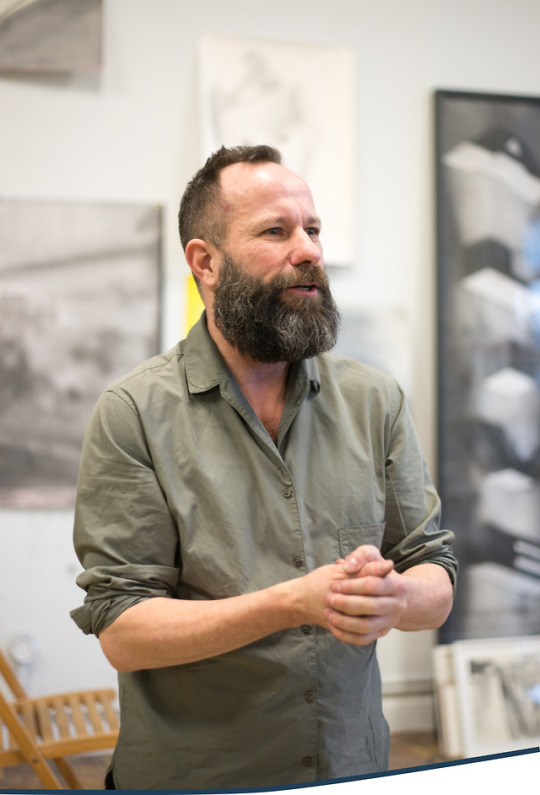
Peter Morrens
On trying to be the third person.
Dutch translation
Date of interview: February 2018
Estimated reading time: 12 minutes
Close to Antwerp, in a sunny Merksem studio, I meet a welcoming, lively Peter Morrens (°1965). It always takes some getting used to his unbridled energy; the most important characteristic that makes him the inspired, versatile and hard-to-define artist whom I have now been following for a couple of years. Peter is represented by Ghent based Kristof De Clercq gallery and involved as a drawing/graphics professor at LUCA Ghent. He does lectures, performances and produces a multitude of series and editions under just as many heteronyms. Until 2016, together with artist Rik De Boe, he ran the exhibition space Voorkamer in the city of Lier.
During the interview, he is in perpetual movement, gesticulative and hyperasociative. His knowledge and gift for remembering quotes are impressive. The somewhat roguish reserve of first soon makes place for a familiar openness. Few sentences get finished and when they are, they end up somewhere completely different than where they started. Because every turn is interesting though, I but gladly follow. After two hours of talking, Peter asks me if the interview has already started…

How should we look at your studio set-up?
Well, to start with, I always work in notebooks. I never fail to carry those things with me. Afterwards, those early ideas get into a transitional phase. That’s what you’re looking at right now. I’m always working on different things at once; I look upon those works as building blocks to be puzzled together in the gallery or exhibition space. I like to be very thoughtful about how something is shown; I think it’s just as important as making the work itself. I may use about every medium at my disposal and wouldn’t like to be known as the ‘grey charcoal artist’. I really love to experiment around.
Could it be that something comes together in your drawings?
Yeah, that’s certainly true. Nevertheless I always search for something else… when I apply one method for too long things start to go a bit too smooth. I’d prefer some resistance in my process. Something has to be a little bit ‘off.’ It’s about the intensity by which something happens. I rather like the idea of walking on a cutting edge, making metaphors literal. A framed piece can be taken apart again, repainted, destroyed. Besides, I am interested in art history, film, literature, and music. I’d like all of those things to find their place. I mean, knowledge doesn’t have to burst out of the work, but still… I presume that if you have made a drawing of it, you can really start to understand something.
I rather like the idea of walking on a cutting edge.
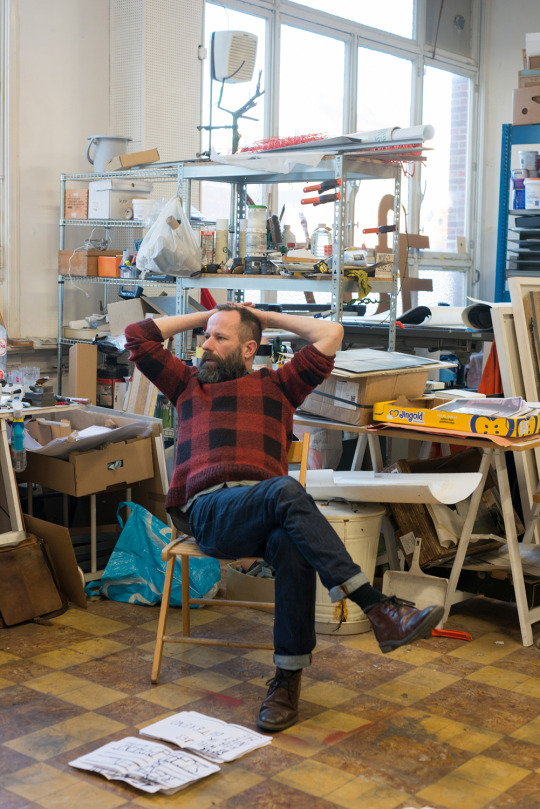
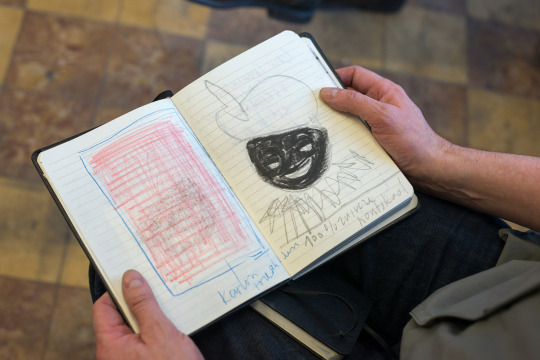
Times change. Do you consider yourself to be post-modern? What role do topical affairs play within your work?
I don’t really think about myself in those terms. But I do hope that the current state of the world is in my work. I even perceive it as the role of the artist. I think it’s important not to fall into retrograde traps, which happens very easy when you work with psychological affects. I find that post-modern attitude quite disturbing regardless of it being the era from which I stem. What especially bothers me is the ‘anything goes’ mentality. On the contrary I really like to be very conscious of how, where and why a work comes to be. Of it being truly lived and existential. In a way you could say that the basic materials may or could be banal.
You mean anecdotal?
Rather how the story of a work’s genesis also becomes part of the work itself. In that respect, the artist always talks about the genesis of a work. What’s important to me is that everything carries its own inherent energy and this has everything to do with how different works are juxtaposed. I’d like to add that I almost never show my work in this studio set-up. I find it very hard to allow people in this private try-out area.
What especially bothers me is the ‘anything goes’ mentality. On the contrary I really like to be very conscious of how, where and why a work comes to be.

Your drawings often refer to the photographic. What is the role of craftsmanship in your work?
Of course it is a base to start from. Still, I only try to apply graphical assets to the point where they evoke contrasts within a set-up. I can work with flashy colors and sculpture as well; sometimes I splash a whole space full of paint for some wild performance. Just yesterday I scribbled down a huge, very banal penis just because I felt like it. I don’t know what I should do with it; maybe I’ll make an installation with it later. Still I understand lot’s of people may find that your best work is the work in which you show your mastery of the medium. But craftsmanship can also mean scribbling down some stupid doodle in one try. Anyway, it demands enormous concentration. Sometimes you can conceive the clearest of thoughts just to have it blown away by ambiguity one second later. You encounter those energies in life as well.
When is a piece finished?
When it has left the studio I guess? There’s that constant stress about something that is finished. Maybe it’s an impossible decision to claim you have completed a piece. Making drawings under the heteronym Herman Smit it’s clearer. They’re drawings after nature, made on sight and in one go. They’re finished when the landscape or portrait is interpreted with the accompanying emotion. This takes something between ten minutes and an hour or so. Herman Smit belongs to the nineteenth century more than this one. I’m thinking about a new show with ‘his’ work, given not much has been showed by him lately. It’s also an extension of my constant need to write everything down, the little notebooks I carry with me constantly.

Sometimes you can conceive the clearest of thoughts just to have it blown away by ambiguity one second later.
When does your work border on the performative?
Herman Smit can be viewed as a performance. Trough him I try to activate and confuse the gaze. People may wonder who this Herman is, where he comes from, what drives him to make these drawings. I let him die in 2005, when his first book got released. When I look back upon it now, of course it’s very clear how much his work relates to my oeuvre, that it’s not two different people at all. Pessoa, who toyed around with exercise of style and sampling genres as well, also influenced me in that respect. I always combined a multitude of activities, thought many aspects of being an artist to be interesting.
What will stay with you from Voorkamer, the exhibition space you ran together with Rik De Boe?
Oh, I learned, worked and experienced so much there. Especially the notion of simultaneity and combining different work methods came to realization in Voorkamer. Doing it together with Rik, who thinks quite differently about stuff than I do, gave us a dialectical framework. The juxtaposition of my rather activist, very physical tension with Rik’s more historicizing, intuitive approach was the core power of the project, like a balancing exercise. Also the fact that we considered ourselves as artists rather than curators. Because the influence of a curator over a work or oeuvre can be so overtly big and almost more important than the content of the work itself. First and foremost, we tried to have a visual discourse. We weren’t interested whatsoever in if an artist was represented by a big gallery or had just left school. We really made exhibitions about works of art.
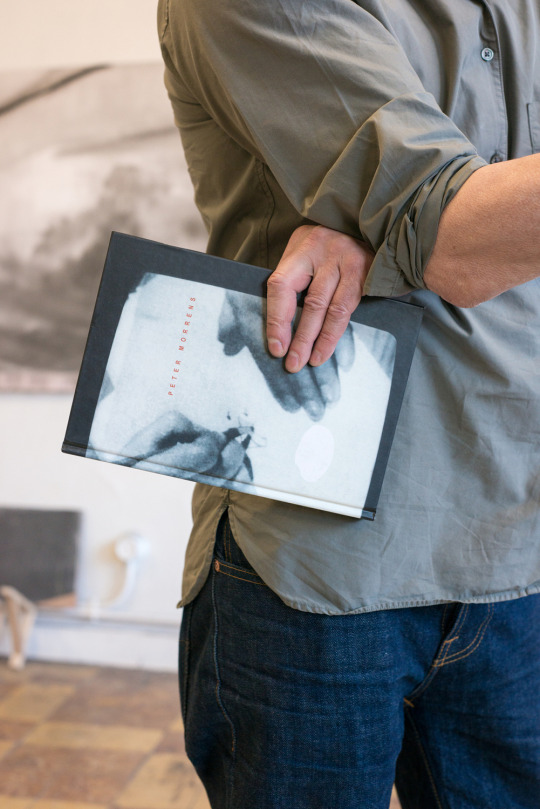
How do you decide if something does or doesn’t work?
When I look around my studio I see a lot that doesn’t (laughs). We have such an unimaginably rich art history. If I’ve seen a bad exhibition, an interesting image may pop up right around the corner: in a book, a movie or where ever. There’s a lot to be inspired by. That quantity and richness is incredible. Even our very local art history goes back forever. Of course I can be mad sometimes about an image, although lately I’m much more able to put such things in perspective. Especially when it comes to art school I can still be aghast sometimes. You’re granted such sacred time in an educational context. What a pity it is to waste all that.
When I was in school, people like Wim Mulders (art theorist red.) were very engaged in the field of contemporary art and encouraged us to really push the boundaries of our atelier. This gave me a firm theoretical and historical ground that I have leaned on ever since. My students must know that all doors are open as long as they go out by themselves. Everybody wants to talk, be curious and approachable. Those boundaries are absolutely not as rigid as they might seem.
Isn’t it so that nowadays, there’s a lot of emphasis on credibility and name; the contests someone has won, the magazines someone is featured in?
I don’t think, for example in Voorkamer, that we cared about credits. Also in the academy or the art world in general there wasn’t much opportunity to make a name for yourself. Maybe I was lucky in that respect? Anyhow, there was never the ambition to strengthen my market value or anything like that. Maybe this isn’t so interesting? I wonder, did we talk about the work yet? (laughs)
Of course we did, but I think it’s also relevant to talk about being an artist.
I think it’s interesting when you say something about the ‘surface’. Maybe it’s very superficial to talk exclusively about the work itself. But an artist always just lingers on the surface. He touches it while making a drawing, painting of sculpture. He covers and scratches it. Maybe this is a psychoanalytical way of saying it, but it’s like the boundary between talking and making an interpretation. Who’s talking when one talks about oneself? He who speaks or he who listens? Is that the same person? Actually it’s quite hard to get to the heart of things. Hence the surface is the place where you dwell most of the time.
My work probably is a catalogue raisonnée that will only be finished when I’m dead. Maybe the others can even complete it or make additions. Of course I can’t reach that ideal position of the outsider. At the same time I also try to create work as a ‘third person’, that distance is quite necessary.
Actually it’s quite hard to get to the heart of things. Hence the surface is the place where you dwell most of the time.

Do you think of yourself as a protagonist in your oeuvre?
All of my sensibilities are captured in the work. Also my social engagement, my obsessions. Care and attention are connected to the way I work, implying affection, a physical act. One makes a double if one creates something. When I make a self-portrait of me as a child, the work isn’t as much about me as it is about ‘him’. Who is who can be understood in a multitude of ways. There are different layers. In this drawing I’m a kid, so we look back in time. The drawing is based on a picture that I didn’t take myself. Which connection does that image have with the now? There’s a shift in medium, size, time and perspective. Again that distance, the attempt at being the third person.
There’s a beautiful painting by Zurbarán in which a young Jesus is playing with a crown of thorns. A magnificent game with the position of the viewer towards time. Of course we all know what’s going to happen later on, yet we see a deceptively peaceful interior. A whole realm of images is evoked, which I think is absolutely marvelous. In the mean time, it is the viewer with whom a game is played: of course Zurbarán is the one in control and he knows very well what he’s doing.
You also produce text drawings under the name Point Blank Press, how do these images come about?
Up to this day, more than two thousand drawings where produced under the name Point Blank Press. Mostly they are sentences or words that I picked up somewhere. It can also be free associations that have an internal origin. Actually it’s a continual exercise in auditory observation. Usually there’s a fixed day on which I work on the Point Blank Series. For me, they are drawings based on the stuff of language.
There is a vulnerability on the border of what is and isn’t an image. Often it comes down to a decision, a choice. Tadeusz Kantor has an interesting view on that, the way he lost his faith in painting because it is ‘just’ a reproduction of reality, the way he looks for unpractical objects to be given use. Because for him the poor, worn out, banal object has an artistic value. ‘L objet entre l’eternite et la poubelle’. The object between eternity and the trash can. It makes me feel good about things that I can decide to completely change their value at whatever moment I desire.
Like Tadeusz Kantor said, a work of art is an object between eternity and the trash can.

In your house there’s also a small studio, how do the two workspaces relate to one another?
At the moment I have an open space here that functions as an archive but can be used to make big, physical and dirty work. For the smaller pieces I tend to stay at the drawing board in my home. There were times where I made the big charcoal drawings at home as well, but for a number of reasons that was very unpractical. What’s so nice here is the huge wall where I can prepare a show or gallery set-up. Depending on the project I repaint the whole room in different shades of grey, which I also use in my exhibitions.
The first part of the day usually takes place at home. The Point Blank series for example are always worked on early in the morning. Afterwards I leave for the studio, meaning a transition to a different mindset. A lot of sketches and notes come about when I’m on my way, thus the movement between home and working space is essential. It’s the idea of ‘the moving observer’. I tend to have a hyper focus on details. Whilst moving, this attention is amplified. To get more of an overview I work towards installations, I can’t seem to get that panorama in a single piece. An installation must look like a room in which you enter for the very first time. Only then one can see everything and nothing at the same time. Only after that, a close-up on different parts happens. The way your gaze moves tells you something about yourself. For me, it is very tactile, almost sensual. I often look for the odd, something that speaks of the political aspect of the public space. An interaction between that what makes me warm inside and that what makes me angry. This happens best in an unfamiliar place, that’s why there needs to be perpetual change in the studio set-up. If you want to say something in a public debate, you should also leave your comfort zone. This implies a physical act. I think all of my work is the result of rather heavy physical action. I really dance while I’m working. It’s a very rhythmical, hypersensitive thing, very much related to music of course; we didn’t even talk about that! (laughs)
What do you listen to when you’re working? I can imagine something punkish…
Well, I do stem from the punk generation and I really like that DIY mentality. But I was never a real punk; I listen to a huge variety of music, ranging from chansons to free jazz and everything in between… I like pumping rhythms and intrusive dissonants that make me think of my work in a way. The energetic, emotional aspect of music is something that excites me and a thing I strive for in my visual work and performances. Wait, let me play you something so the readers can also hear! (laughs)
Peter Morrens’ work is on view until 17/11 at TRUST, the collection presentation of S.M.A.K. in Les Brasseurs, Liège.
Kristof De Clercq
S.M.A.K.
Les Brasseurs
Voorkamer
Interview: Maxim Ryckaerts
Photography: Lola Pertsowsky
English editing: Tyche Beyens

_
0 notes
Photo

Hannelore Van Dijck
Out of the black and into the blue.
Dutch translation.
Date of interview: March 2018
Estimated reading time: 11 minutes
Hannelore Van Dijck (°1986) studied illustration at Belgian art academy LUCA Ghent. Ever since her graduation project she specialized herself in charcoal drawings that she creates in her atelier or directly on site. Be it on paper, wall, floor, or whatever surface, Hannelore works just as intense. When she’s drawing, her whole body functions on behalf of that practice. She recently published a book called The lasting one, that didn’t last, that still lasts in which she gathered about everything she has created until now, an overview of the past ten years.
On the day of the interview I meet Hannelore in Turnhout’s De Warande where she’s working on an in situ piece for the exhibition Het Gouden Paviljoen. When she opens the door, she is covered in dust, completely caught up into her own world. Still, the artist is very open, immediately inviting me for a tour around the exhibition space. In doing so, we wander along the columns she covered in her trademark black charcoal, although, not entirely black. For the first time ever she also used some blue, so it’s exiting we could meet on this apparent turning point. We decide to take a break and sit down to reflect on the courage that is needed for turning things around, to talk about time and discovering.

Why charcoal, Hannelore?
A lot of choices are made intuitively. You decide something in a certain instant, sometimes due to a coincidence. Such decisions are based upon a feeling that what you’re doing is right, without thinking much further. Only in looking back, you can trace the impact it had upon your work. Charcoal was such a decision.
During the first years of my training I used different materials, among them pencil, ink and paint. I didn’t focus on one material because I wanted to investigate a wide array of them. That was a good thing. But for my masters’ project I felt the need to focus on just one and really understand it. I chose charcoal. I made a series of drawings based on the novel Of Mice and Men by John Steinbeck. I started that project thinking I would make an actual book but in the end I realized that it wasn’t necessary. It had become a project of tactile images and they were strong enough in their own right. To give the jury some kind of insight in the story I used as a starting point, my promoter Goele Dewankel suggested to show my drawings as a projection in some sort of black box, which I did but instead of turning the walls black by using paint, I darkened them with charcoal. So in short, I got a space in our school where I could start drawing on the walls. That’s how it got started.

I felt liberated because there were no edges like when you draw on paper. Besides that, charcoal offered certain possibilities. It has a quality that makes it possible to really intervene a space. It can handle the largest surfaces but at the same time, it can pronounce a small detail, always in a black that is both sharp and soft. It’s robust and delicate at the same time. By using charcoal in an in situ drawing, it manifests a materiality that is impossible to fixate. When you don’t force it into preservation, the drawing becomes vulnerable, a quality that I believe is inherent to all matter. It is this sort of letting go that gives me the freedom to create an image. In that sense, charcoal is much more than a creative tool, it guides how I reflect upon my work.
In the end, I just really love to use it. During this plead for charcoal, I’m working with a bag filled with blue pigment, though.
Would you describe this project as a turning point?
Yes, I would. And all this blue is a direct result of that, I guess. I turned thirty one, which means that I’ve been graduated for ten years. Therefore, I am no longer a beginner. I think that with every decimal number, you are inclined to look back and make up a balance. Also, I made a book called The lasting one, That didn’t last, That still lasts, which gives an idea about what I’ve been up to for the past 10 years. So, in a way, the road behind me is bundled together in a book while the road ahead is still open and undecided. The book marked the end of a period and therefor I ask myself a lot of questions, like, where do I go from here? What do I leave behind? What do I take with me? That’s both scary and amazing. Anyways, I try to act. Hearing me say these words out loud… They sound pretty banal. But using a material I’ve never used before has had a huge impact. It makes me see things I’ve never seen before. I think that’s good.
When you don’t force it into preservation, a drawing becomes vulnerable, a quality that I believe is inherent to all matter.

Alertness and discovery seem to be key to your way of working?
Yes, I think so. Every new drawing is based upon a question, and from that question, a new question pops up, which leads to the next… I can’t translate an idea directly into an image. In my atelier, I’m working on several things at the same time. Through a process of drawing and erasing, putting a drawing aside and picking it back up, the drawing slowly comes to life. The eraser has always been an essential tool in my process. Actually, I erase as much as I draw. I mark, I look, I search, I adjust up until the point that I start to see something which I couldn’t have predicted myself. Actually, it is all about the process of becoming, which is essential in creating an image.
What is the difference between working in situ and working in an atelier?
They are two distinct processes, each with their own rhythm. In an atelier one can work unlimited. As long as the drawing isn’t completed, it won’t leave the room and there’s no need for it to be finished. Working in situ demands a different kind of focus. It takes two weeks for me to build, then the exhibition opens and the work needs to be finished. You can’t keep changing it. It demands focus and also a physical effort. I wouldn’t be able to work like that all the time. That’s also why I need to swap from time to time between working in situ and in my atelier. They need each other.
What interests me most is the dialogue that can appear between my work and the space it is presented in. This can originate both in situ as in my atelier. It only manifests itself in a different way. When I bring a drawing to a space, a conversation comes about with that which already exists. When working in situ, I can make the room a part of what I create, an exchange - if you will - with that what is already present.
Actually, it is all about the process of becoming, which is essential in creating an image.

Is music part of that dialogue?
Yes, somehow it is. The rhythm of the music guides my process of drawing. It stimulates me to keep on going. But it is important that I don’t get to choose the music I listen to. It would shift the focus to much. Therefore, I mostly use playlists made by others. The goal is just to strengthen my focus.
Also, playing music trough my headphones helps me to shut down the world around me. I really need that while working in situ because there is so much going on around me. I enjoy concentration and spending time with a drawing, otherwise I just wouldn’t make this sort of work.
What determines the duration of building up a drawing?
I start a drawing. Maybe, after a while, I erase something. Maybe I get lost in the rhythm. Maybe something goes wrong which causes a stain. I don’t have a system, but while I’m drawing, I do look for something to shift, for something to push back. When that happens, I know that the drawing becomes an image, an image I couldn’t have predicted myself. In that moment some sort of ‘ping pong’ comes about. Than I’m no longer the one who’s making up the rules, instead there’s a dialogue between my action, the material and when working in situ, the space surrounding me. That moment of genesis feels nice. Than it really becomes something. It gives direction. The time I need to understand a material, is the time I need to get to that point of seeing.

The time I need to understand a material, is the time I need to get to that point of seeing.

What is your physical relation towards your work?
It’s a pretty dirty job. To see, as much as to draw, is always a physical action taking place in a certain space. So, I use my whole body. Sometimes I look at a drawing from below, from far away, from close. Sometimes the gaze is conceptualized as something distant. Well, I oppose that. The eyes are a tactile organ. To look is always physical because you look at things from a vantage point.
Is the public a part of your working process?
I think so, in a way. I partly use the perspective of a spectator, how he or she walks into the room to get submerged in it. Or actually, it is more about the tension between getting submerged into something and being part of it. The spectators put their own meaning into a drawing, you can’t control how they interpret your work. An in situ work breaks through the barriers between a spectator and what he or she is looking at. The image is a place and the spectator walks into it. What you see, changes while walking through a space. That is something I hold into account while working in situ.
Is photography important for you?
Very much so because my work doesn’t last trough time. Without photography it would all disappear. In that way the picture is the witness of a certain moment. Up until now, I’ve never used a picture as a work of art, but I do use photography in publications. A book is like an exhibition on paper. It has the property of bringing my work together to give it a new perspective.
Sometimes the gaze is conceptualized as something distant. Well, I oppose that. The eyes are a tactile organ.

Time is a part of your process but is it also a theme in your work?
Yes, the slow repetitive working process in my atelier, the fourteen days of in situ working, the transient encounter between the visitor and the drawing, the finite lifetime of an in situ project and the simple erosion, like footsteps, a touch or even the wind, that change an image while it is being watched; all that resonates in my work as some sort of a ticking clock or pulse. My choice for a certain material and a certain approach are embedded in my oeuvre.
At first, the temporality of my work was caused by my choice for working on site. In that temporality, I chose charcoal because it felt like this poetical paradox. It is a very powerful, yet fragile material. The wall drawings and the charcoal in a way also determined the content of my work. Drawing is the engine of my thinking.
I chose charcoal because it felt like this poetical paradox. It is a very powerful, yet fragile material.
You have done some residences, how was that for you?
From 2010 until 2015 I lived in Berlin, be it with some breaks. In 2012 I also stayed in Norway and in 2015 in Barcelona for two months. Fair to say that sometimes I feel the need to depart, to leave it all behind. It helps me to think more clearly. When yo stays in one place for too long, you start to think in circles. In Norway I lived in a small village. I wanted to make a drawing on the walls of the house, but I didn’t have enough supplies for it. Therefore, I collected wood in the forest, pulled of its bark, dried it and turned it into charcoal. It was interesting to see how every sort of wood had its own texture and thus, gives another effect while drawing. It is a material with many nuances. Only then you realise the material you buy in stores is standardised, a product made to fit in a box. But of course charcoal is burnt wood, a material wich is very much alive. Making it myself has been one step in really understanding it’s properties. Every choice you make echoes in your work. Just like my choice for charcoal does.
Actually, talking about it makes me want to go abroad again.

How was your residence in Berlin?
I went there two years after graduation. While studying, one follows the rhythm of the school. But then, when you graduate, you need to find your own tempo. I worked full time and it wasn’t easy to keep developing my own practice. I wanted to open my world and focus on my work. That’s why I wanted to do a residence in one of the big European cities. My stay in Berlin was planned to last six months but eventually I sticked around longer. I learned a lot. Through contact with other artists from all over the world, I learned about different approaches to being an artist. The people I met also looked very differently at my work. This really encouraged me to grow further.
While our conversation gradually comes to an end, suddenly I become aware of the space around me again. I feel that, for a moment there, I completely wandered of in Hannelore’s world. After we said goodbye and I am walking away from de Warande, our conversation keeps on resonating. I too am wondering what the future might bring.
Hannelore’s work is currently on view at DMW Art Space as part of a collaboration with Koba De Meutter.
Website
Gallery Sofie Van De Velde
Posture Editions
Interview: Phaedra Berkvens Translation: Phaedra Berkvens, Maxim Ryckaerts Photography: Joan Panhuyzen English editing: Maxim Ryckaerts

_
1 note
·
View note
Photo

Enzo Smits
On subculture, memories and the art of doing nothing.
Dutch translation.
Date of interview: march 2018
Estimated reading time: 12 minutes
Truth be told, Enzo Smits (1988°) is no stranger to us. We met him about ten years ago in the local skate scene of Mol and to this day we still share the same world of interests. Today we meet Enzo on a fairly sunny Sunday morning at the South Station of Brussels. This time not for skating, but to discuss his work as a filmmaker and screenwriter.
Enzo grew up in Mol, but has been living in Brussels for about ten years now. His developing body of work includes the short films ‘All We Ever Wanted Was Everything’ (2014) and ‘It won’t be long now’ (2016), the group exhibition ‘Nothing is Cool’ (2015) and the scenario for the comic ‘Wolves’ (2016). As owner of book and record shop ZWART-WIT, Enzo displays his daily life as an idiosyncratic selection of reading and listening material. Somewhere between all these things, he finds the time to work together with illustrator Ward Zwart on a second comic.
Before heading to his apartment, we start the day off with a msemmen, a delicacy of Maghreb origin that strikes a balance between bread and pancakes. Feta and olives? Yes please. After a short walk through Saint-Gilles we arrive at his apartment in Vorst. We’re served a black tea as we reminisce over past memories. After thriving in his natural environment for a while, we move the conversation to Le Petit Molière, a cosy café just down the street. That’s when the conversation really gets going. To the soundtrack of "I Can’t Live Without You", "Roxanne" and "Staying Alive" the locals make themselves at home.

Skateboarding is, albeit indirectly, a theme that often recurs in your work. You were a skater yourself during your teenage years. How do you look back on this period?
Skateboarding is super interesting, but the skating itself wasn’t my strongest feature. Pretty soon I felt that I wasn’t going to be very good at it and I started to focus more on filming and shooting photos of my friends.
That's how I discovered the 'creative side' of skateboarding whilst being introduced to a whole bunch of new things. A brand new world opened up to me in terms of music. But I also got to know filmmakers like Mike Mills, Spike Jonze and Harmony Korine this way. I think that, as is the case with every teenager, subculture is a good way to discover other things. In that regard, skating was just a starting point for me.
It’s also true that skating, and in particular hanging around and searching for places, has unconsciously had a strong influence on how I make films now. As a skateboarder you learn to look at a public space in a different way. I think that’s how I developed my fascination for parking lots and other non-places. Places that actually have a very specific purpose, but are used by skaters in a whole different way.
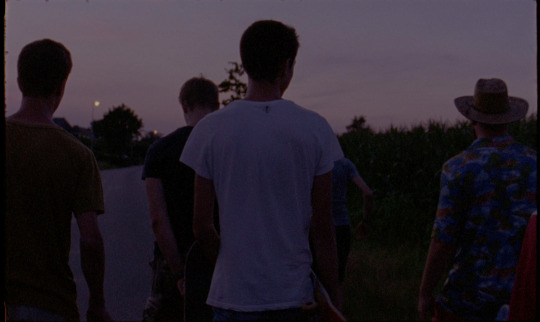
16mm-still from All We Ever Wanted Was Everything (2014)
In your graduation project ‘All We Ever Wanted Was Everything’ (2014) we follow a group of young skaters. How did the creative process of this film come about?
It took a long time before I knew how I wanted to make that film. I didn’t want it to be just another story about skating. I have yet to see a story in which everything revolves around the act of skateboarding itself, to be filmed in a successful way.
Instead I wanted to show everything that happens in the margin: the moving around from spot to spot, the waiting and all the non-moments that stuck with me. That’s also the reason why I wanted to make a film, with people I knew at locations I was familiar with. I did have some idea beforehand of how I wanted it to look like, but there was no fixed script. It would’ve been weird to force text on people. For me it was just as valuable if someone said: "My toes are numb", than any text I could have written. Why would I impose my vision purely upon these people instead of letting them tell the story themselves.
Throughout the making of the film we gradually discovered how we wanted to tackle this subject. The idea was that the film would have the structure of a photo album. That you as a viewer could let your eyes glide from image to image and that the story gradually unfolds. That’s the main idea, but then you still have to convert that idea into a process. At times the filming itself looked very much like hanging around and skating, but with a clear goal in mind. Our 'scenario' became more of a map consisting of places, people and situations. During productio these elements were then brought together and we gradually came to the final result.
The movie was shot on actual film. Why is that?
In terms of material we deliberately opted for a minimal setup: one camera, two different lenses, two types of film and no added light. As a result, we often had to wait for the right light or accept that certain things weren’t visible. Turning on a pellicule gives a grainy character to the image. It was clear beforehand that we would mainly film still images: empty rooms, still lifes, environments, ... Because of the grain you feel as a viewer that there is movement, that you are not looking at a picture or a frame.
Apart from the aesthetic aspect, using 16mm film also entailed a certain method. Unless you work with huge budgets, which is certainly not the case with me, you have to choose much more carefully what you shoot or don’t shoot. In addition, you can’t immediately review the shots. Because of this, during the editing process I had already forgotten certain considerations that I had at the time of filming. I could see the images as just … images. But that certainly doesn’t mean I reject the digital. Each film requires a certain working method. For me the question "How do I make this film" is just as important as "What kind of story do I want to tell". It differs from project to project. For example,'It won’t be long now' (2016), the short film that I made for the 4x7 series for Canvas (broadcasting station), was fully digitized. Apart from the neighborhood views in the beginning, which were made the day before, everything was filmed in one evening. The film is made up of only a handful of long shots, so that the course of time becomes tangible. The best moments in the film came about when it was unclear whether the camera was running or not. Since my characters had never been in front of a camera, this was a convenient way of working.
For me it was just as valuable if someone said: "My toes are numb", than any text I could have written.

Film-still from ‘It won’t be long now’ (2016)
Young people always seem to pop up in your work. Do you cherish a certain nostalgia for your teenage years?
It’s a world that I know and recognize. It is a period that feels like one big intermediate moment, it has a certain slowness to it where you constantly seem to wait for what will come. This world lends itself very well to the stories I want to tell. What I very often tend to create is a kind of ideal, a romantic image of boredom. Boredom without it being boring. In telling something about teenagers, you can really emphasize that feeling which makes the subject so great.
In addition to this, I’m also somewhat receptive to the nostalgia and the melancholy that you can associate with it. My view of how I think about my youth is also a kind of romanticism that only comes about afterwards. I was confronted with this fact during the making of my first film. I had a certain image of the town of Mol or a similar place in my mind that did not resemble what it looked like in reality. In the end, we went searching for places like the ones in my imagination. I’ve been deliberately engaged in maintaining these memories and trying to show a realistic picture of it.
What I very often tend to create is a kind of ideal, a romantic image of boredom. Boredom without it being boring.

The images in your films tend to be quite static. Is that primarily a contentual choice?
I quite often make the choice to film on a tripod. But that might also have something to do with my fascination for photography. I like it when time becomes something tangible/palpable. When this happens, the viewer is given the space to recognize himself in a certain moment or situation. A space between images arises, in which you can create your own stories as a viewer.
I also find this true for books. Even if it’s just about turning pages. One of the few remarks I might give on Ward's drawings is: "Make it longer or try to stretch that action a bit longer."
Do you always choose to work with a small production team?
By working on other films I discovered that the machinery behind a movie is not really my thing. This was my reason for working with a small teams ever since. I want to work with people I trust instead of a big team that only slows everything down on set. If you’re working with forty people, you can no longer jump into the car at the last minute to film somewhere else. Sometimes I'm jealous of photographers because they only have to take care of themselves. Yet I would miss the dialogue with other people. I think I’m looking for the best of both worlds. With Grimm Vandekerckhove as DOP and Kwinten Van Laethem as sound engineer I found 2 people that I feel think about film in the same way I do. So for the time being I do not see why I should need more people.
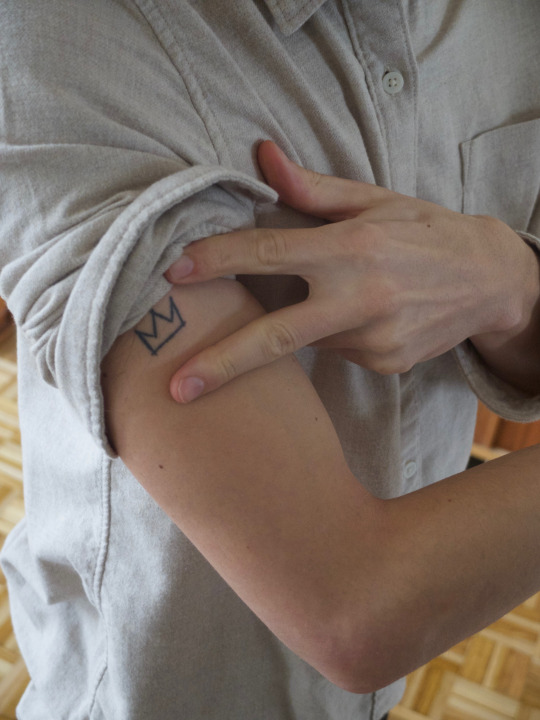

How can the exhibition ‘Nothing is Cool’ be situated within the context of your work?
‘Nothing is Cool’ is a something I already spoke about with Nick Geboers and Stef Renard while filming for ‘A.W.E.W.W.E.’ The way a film is shown has an enormous impact on it’s reception. Too often films are arranged within a program of other shortfilms with whom, apart from the length, they have nothing in common. Yet these films affect each other and people unconsciously compare or link them.
Nick and Stef both work regularly on youth and skateboard culture, it seemed interesting to work with them and build a groupshow on this theme where different media could be combined. Sarah Hermans also joined the show quite quickly. Everyone approached the theme in his or her own way. While building the show everything seemed to fall into place.
I showed ‘A.W.E.W.W.E.’ in loop on a tube television. It happened that people started watching in the middle of the film. Up until now this was for me the most satisfying showing of the film. I also had the feeling that people suddenly understood it better by placing it within the bigger picture.
By limiting yourself in terms of scenario and the way of filming, you try to determine as little as possible in advance. Isn’t this a big difference with the narrative structure of ‘Wolven’ (2016), the comic in collaboration with Ward Zwart of which you wrote the scenario?
The stories in ‘Wolven’ are in that comic and not in a film because the stories have more in common with the structure of narrative fiction, for instance the use of dialogues. A lot of the stories in Wolven are unfinished scenario’s for shortfilms. The format of a comic permits me to get rid of these stories someplace else. But you can also add unrealistic elements in a comic and thus respond to the emotional world of the characters better. Finally, an animated dialogue is less decisive than one that is spoken out.

Fragment from Wolven by Ward zwart
A lot of the stories in Wolven are unfinished scenario’s for shortfilms. The format of a comic permits me to get rid of these stories someplace else.
Do you have a regular routine while writing?
I admire people who can sit at their computer in the morning to start working right away. It’s really quite the opposite for me. For the greatest part, my work process consists of doing nothing, or at that moment thinking that I am not doing anything but being busy in a unconscious way. I walk around or gaze in books, I waste a lot of time behind the computer or I listen to music and suddenly there is one hour of concentrated work. Because I spend a lot of time commuting nowadays, that hour often takes place on the train. For me, work often takes place in between. As a result, I sometimes think of myself as being lazy or doing nothing.
When making a film it is nice that there is an effective filming period which is super intense. Then you are really busy from dusk til dawn.
Do you feel that you want to justify yourself for doing nothing?
I have already admitted that to myself, but sometimes I feel the need to justify something to the outside world. It is also difficult to explain to others what you do when you are writing or preparing a movie. One does not see how a project comes about. That is difficult to measure. I think it is a struggle for many people to accept that doing nothing is part of ones practice. I am quickly distracted, but that distraction is, at the same time, such a large part of the input. In all the things I make now, pop culture and everything related to it is super important.
For me, work often takes place in between stuff. As a result, I sometimes think of myself as being lazy or doing nothing.

It strikes me that you’re quite frank about the fact that your work is made up of the work of others. Who or what influences your practice?
In my films as well as in ‘Wolven’, I really want these influences to be part of the whole. Forty percent of my work was probably stolen in a way. A portion that I have picked up for processing. For example in ‘Wolven’ there is a character who resembles David Foster Wallace because Ward and I like him. The movie posters hanging on the wall are from films that we like. There are scenes based on a Slint song. This is no different with my films. I don’t want to just drop names however. I just believe that pop culture, subculture and youth culture are so closely related that it would be strange to ignore their existence.
People often act tough about it. But when you write an essay, you also literally state all your sources. Why would you hide everything in fiction?
Forty percent of my work was probably stolen in a way. A portion that I have picked up for processing.

"Small town growing up" is a recurring theme in your work. You have been living in Brussels for a while now. Can we expect a story taking place in our capital soon?
Apart from school assignments I have never filmed anything in Brussels. I would love to do that, but there is still a feeling that it is not up to me to tell anything about the city. Many films about Brussels create a certain image of the place. You thereby create a stigma. While I do the same for Mol. I also give an unrealistic picture, but at the same time that has much more to do with an emotional world. I only discovered that and dared to admit it by making work about it. At first I wanted to resist, but I always returned to Mol to make films. For the new book, for the first time I started making something that took place in a city. But in the first scene the main character takes back the train to some allotment.
We end the conversation with "Another brick in the wall" in the background. The regulars open their throats and make their first modest dance moves. Enzo is not really in the mood for dancing, we decide to hang around in Brussels and let the day slumber on.

Blog A.W.E.W.W.E. It won’t be long now Wolven
Interview : Alexander Delport, Jakob Van den Broucke Translation: Alexander Delport, Jakob Van den Broucke Photography: Alexander Delport, Jakob Van den Broucke, Enzo Smits English editing: Tessa Vannieuwenhuyze, Maxim Ryckaerts
_
0 notes
Photo

Casper Clausen
Crossing the bridge from time to time.
Dutch translation.
Date of interview: November 15, 2017 in Lisbon, November 28 in Antwerp
Estimated reading time: 17 minutes
After picking Casper Clausen (°1982, Sonderborg) up at his guesthouse, we install ourselves on the terrace of Antwerpian institution Café Zeezicht, where he has already become a familiar face. Both the name of the bar and the outdoor heaters keeping us warm, are poor substitutes for the scenery in which we met before. Together with photographer Astrid, I ran into the Danish musician and singer along the cliffs of Almada basking in the late autumn sunlight a few weeks earlier. In this part of Lisbon - a short ferry ride away from the city centre – him and his companion Mads Brauer had been creating new material in the studio: the former Portuguese fisher society turned into a rather unique art residency space. While Casper gives us a little tour in the ateliers, chatting with other residents, showing us Ernesto the house cat’s drinking fountain, Mads starts working. Later, when Casper joins him, we stick around and feel like two children witnessing a fairy tale, mesmerized by sound and sight intertwining. Behind the two musicians, the sun is setting over central Lisbon and we feel privileged, eavesdropping on the beginnings of Altid Sammen, which they later premiered in January with B.O.X, a contemporary baroque ensemble.
But even in the pre-Christmas setting of Antwerp, the titillating lightness of Lisbon is still lingering around Captain Casablanca. That is the moniker he uses for his solo project, next to his bands Efterklang, Liima and various other musical collaborations and explorations. It might be the change of scenery – having spent the afternoon rehearsing in a baroque church- or the nearing end of the year, but Casper shows a remarkable affinity for nostalgic reflections. After noticing the old paper I scribbled my preparation for the interview upon, our conversation spirals around the topic of time and how to capture it as an artist: whether it be on an album, by relocating to the Portuguese capital or through autobiographical writing.
How did you end up in Lisbon? Was it a conscious move to the south?
The short answer would be: I lived in Berlin before for six years and I was very tempted to go to the south of Europe. Flama, our promoter and friend in Lisbon, kept asking me to come over. Then I spent a month there three years ago, just to see how it went. In that same period of time, I also recorded an album with the French cellist Gaspar Claus, called Claus and Clausen. I really liked the change, the southern mentality. People are a bit more loose and welcoming. So when I finally decided to move, I didn’t exactly know what the mission was. I was attracted to this more bodily way of approaching music. Coming from Berlin and Copenhagen, it’s quite heavy sometimes. People tend to think a lot in terms of concepts in the north; Lisbon is more about rhythm, culture and dance.
It was the exotic touch I needed. I was attracted to the light, to the poetry of the place, the music, the sounds. I felt there was a calling in that. In the end it turned into some sort of mission for myself to make solo music, although it wasn’t that conscious from the beginning. I was so far away from the others from Liima and Efterklang that I had to start something on my own.
I was attracted to this more bodily way of approaching music.
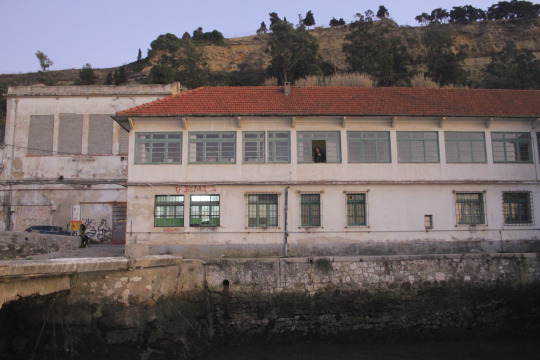
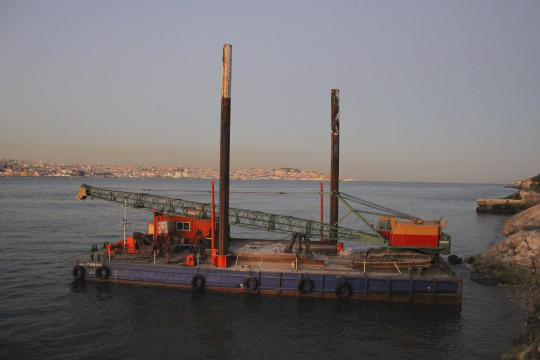
How would you describe the influence of the city on your work?
I try not to think so much about it, but I see it slips in in some sort of way. I’m definitely attracted to a freer form of music. It started already a little bit in Berlin, but Efterklang’s music is more structured. I like the idea of making things quite fast and just playing some shows, making casual appearances. I met a lot of people and I got a lot of open doors in Lisbon, so I could play these small shows in clubs whilst building my solo repertoire. Every time I tried to perform something new.
There are tons of ideas that I got from being in the area that I’d like to explore. There are all these different musicians around and Portugal has a very rich music culture. It has been a great opportunity to be an outsider again. There’s for example Cabo Verde music, or traditional Rancho from the North, which has a very interesting set-up. I get a lot of input and I’d love to get a little closer to it. People who have been living there for a long time, take things for granted that I find fresh and inspiring.
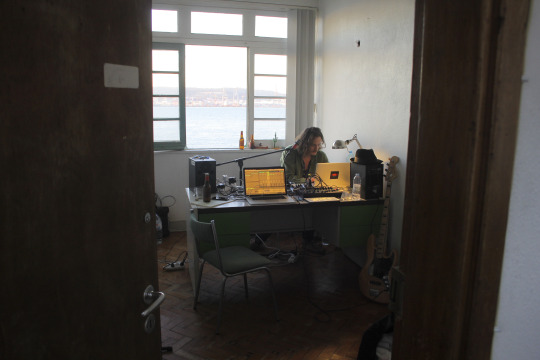
It has been a great opportunity to be an outsider again.
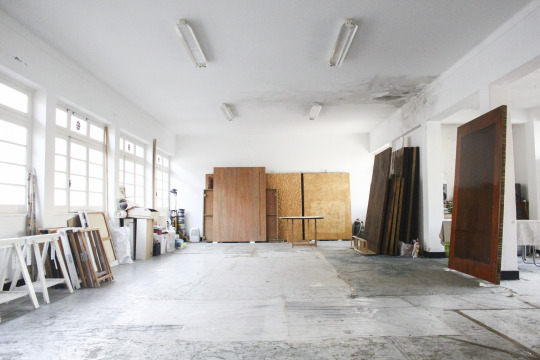
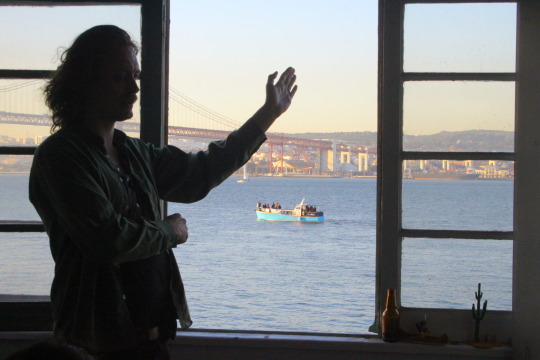
How is Lisbon’s arts scene different from Berlin’s?
I’m curating an evening soon, called Casper Clausen e amigos (laughs). I like the playfulness, keeping things light and inviting friends. There’s still this ritual of playing music. People are really up for playing here, not just in terms of playing music, but playing around. It doesn’t have to be this ‘epic’ thing. There are not as much institutions. Everything is more DIY, in a sense that they need to make things happen uncompromised to their idea. It fits me quite well at the moment that approach. Another difference with Berlin is that there are more people who’re originally from Lisbon, whereas Berlin is more of a mix from people from all over the world.
People are really up for playing in Lisbon, for playing around. It doesn’t always have to be this ‘epic’ thing.
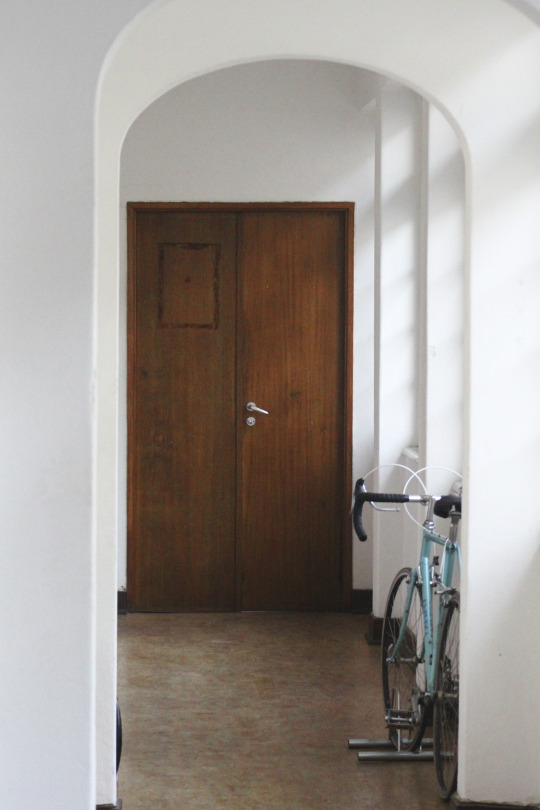

Your studio also seems a ritualized space for creation: this view, the calmness of the area, the water surrounding you… How did you find it?
I found it through my friend André Gonçalves. He was one of the first people I met here, he’s also a musician and builds modular synthesizers (ADDAC). He was my introduction to the city, together with my other friend Flama. They are two extremely different people. Those two men have been the guides into the city for me. André is more of a cave man, a sound wizard, while Flama introduced me to the social life of Lisbon. André spends most of his time in his factory of modular synthesizers in another part of town. Through him, I met Rui (Suares Costa, visual artist), because they used to share another studio together.
Those two extremely different men have been the guides into the city for me.
Rui had just started off this place when we met. He was kind of tired of painting and creating all alone. He once told me that it feels natural to be alone, but he made this promise to himself that he wants this art residency, so he has people around him that can disturb him. His paintings are intense, repetitive work. He created this place as a residency where artists from all over the world could stay for a while. My residency just seems to have turned into a very long one, 8 months by now (laughs).
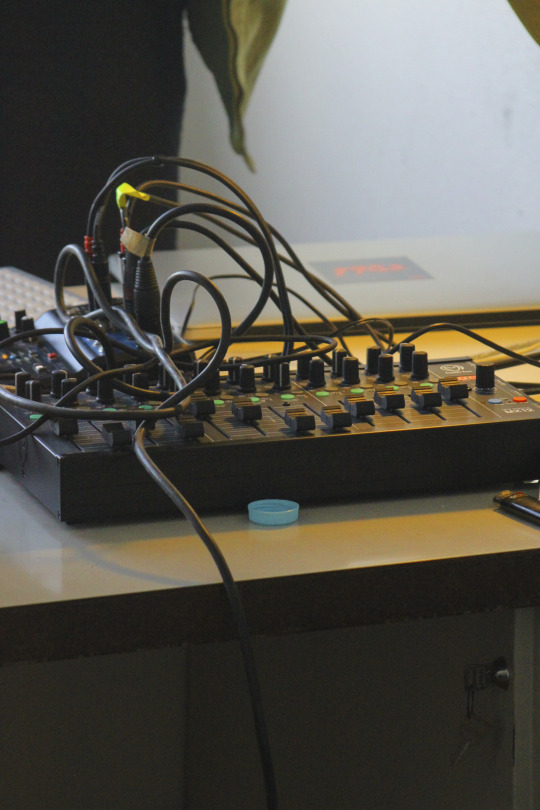
Do you become sort of a cave man as well when you’re creating?
I definitely have both sides in me. I like to completely unsubscribe from society from time to time and just hang out with myself. Very few people would say I have those both sides probably. Others would probably laugh at me and say “Oh Casper, you’re such a social man.” I am, but it’s not the only facet of myself. I do enjoy that a lot, but I always come back to that little space that I need. Lisbon leaves space for both these sides in me.
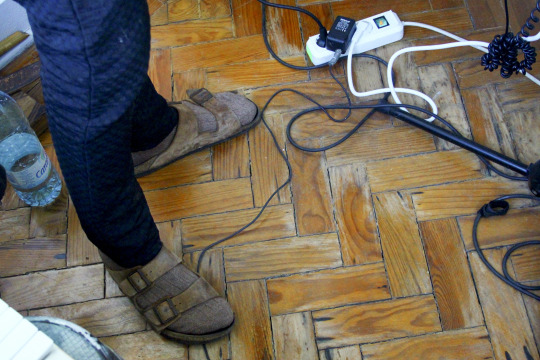
You have to cross the water from time to time, take the ferry?
Exactly. That’s a good way of putting it. Also these two people, Flama and André, two extremes, symbolize something important for me.
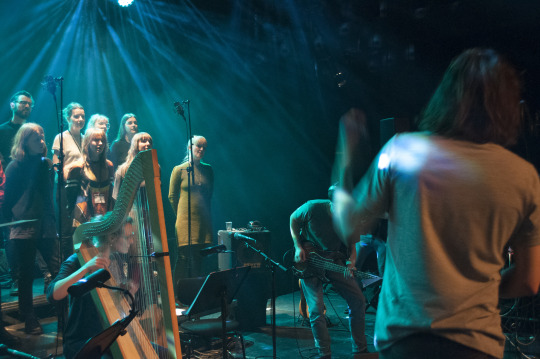
The last album you made with Liima got described in a review as “nostalgic and looking towards the future at the same time”, again dealing with a certain duality. Are you a nostalgic soul or more grounded in the present?
I’m definitely a nostalgic soul. I like the romantic way of looking at life, at things that have been in the past: things you have been going through yourself, historical moments, or great stories that make you feel very small. Such knowledge of the past can be very moving. When I was rehearsing in that baroque church earlier, I realized it can be very heavy. If I devote all my time to it and become very humble to the past, I feel a sort of heaviness I’m not sure I really like. I want to be shaken up once in a while. Someone going like “Hey, you’re living in 2017”. Instead of being afraid of the future, I try to be excited about it.
What I like at the moment, at least regarding to music, is the different genres of the past, different ways of recording. Amazing things have been happening over the past eighty years. All of those era’s carry something. Now we can just take something from everywhere and mix it up. This really excites me, to use the knowledge that it becomes something new, instead of constantly trying to do something new. I am aware that someone has already been harvesting this, but I can use it in the present time. You can cook something up, you know.
I am definitely leaning towards the nostalgic end of the spectrum. You come across a weird duality sometimes, which can be frustrating, because you cannot always morph things.
I am aware that someone has already been harvesting this, but I can use it in the present time. You can cook something up, you know.
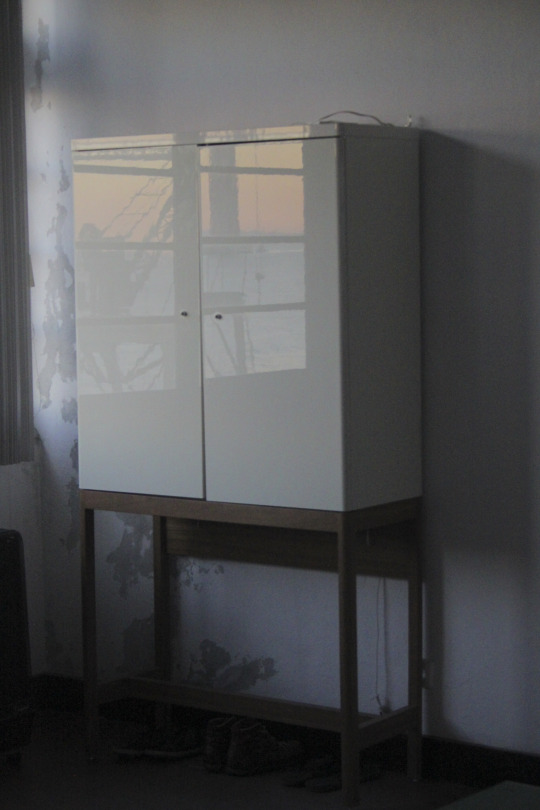
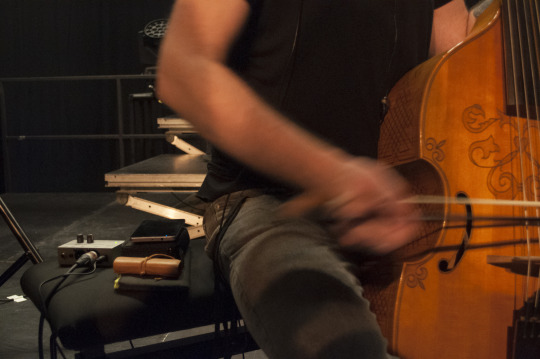
Even in your own story, you highlight certain things.
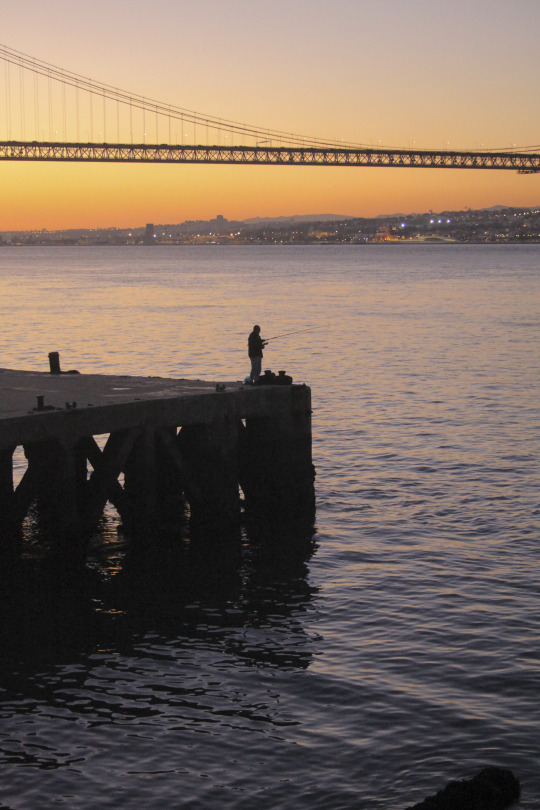
What’s the story behind your album with the French cellist Gaspar Claus?
Our grandfathers crossed each other in the same spot of Lisbon.
For real?
(smiles) It’s a little bit of a romantic story. He’s my brother in a way, even our names resemble each other. We are very much like night and day, extremely different. He likes working during the day, I like to work during the night. He’s quite strict, I’m more floaty. But we felt that there was a sort of story that we could tell. We met through the French filmmaker Vincent Moon. That album is us playing together for the first time, literally. We were sitting in a room, pushing “record” and playing. This kind of meeting was a bit like creating a story based on that. At the time, I was quite into the idea of changing the past. If you create a story, you invent something. We’re playing with reality and fiction and try to find a space there. It’s based on facts, but re-written. We highlight certain things when we tell a story, even for‘real’ events. It doesn’t matter if it was yesterday or a hundred years ago. Even in your own story, you highlight certain things.
Mads joins us for a while. They talk about the rehearsal, about working with a baroque orchestra, how working in those big institutions is different from their own floaty practice. “It’s the closest we have ever gotten to ‘real’ work,” they laugh “being in this room, having a schedule for creating.” But the orchestra has been very giving in the way they think and create together with them.

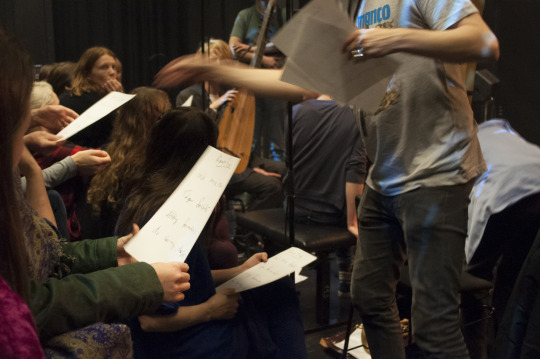
Did you do research for this baroque project?
Just googling (laughs). The ensemble is not really interested in playing strictly baroque music. I think we’re more intrigued by baroque music than they are, in a way. It’s funny, they’re trying to escape it with their instruments while we’re enthusiastic about it.
Coming back to this notion of nostalgia: do you keep a journal yourself? And is it linked to your songwriting?
Lately I moved all my stuff from Berlin to Lisbon, so I came across some notebooks. I’m definitely not a diary guy, I don’t sit down every day to write, but I still scribble down a lot. I just don’t have an organized system. Many times it mixes up with lyrics or songs. My best diaries are my songs. I think I have this distinction between writing down what is happening and then more of an opinionated look on it all. The latter is mainly what turns into lyrics.
My best diaries are my songs.
The other side is more therapy-like. “What did you have for breakfast today, Casper? Where were you?” It’s writing things down in a strict way for myself. I’m hoping to morph those two at some point. Sometimes when I make music from these kind of observations, it doesn’t stick so well. Lyrics come more from singing for me now, rather then they come from writing. I’d love to come to a point where I could write something down and make some music for it. I think it’s a very different way of making music. A friend of mine, Karl Hyde from Underworld, is a mentor in that sense. He likes this methodic writing. Everyday he takes an hour out of his schedule to go to a café and write. He has notebooks for years. So when he needs lyrics, he figures out if something makes sense. I’m naturally always looking for a moment in the moment of the music being created. Which I think is a beautiful way of working, but I would kind of love to find that other way of making music and writing lyrics.
I have a fascination for autobiography, authors explaining their methods, the kind of romantic relationship they have with that. But that’s definitely not me at the moment.
I’m naturally always looking for a moment in the moment of the music being created.
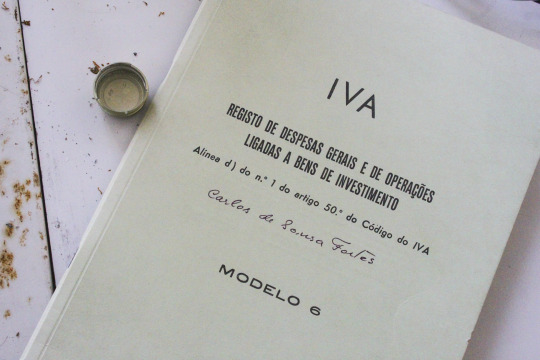
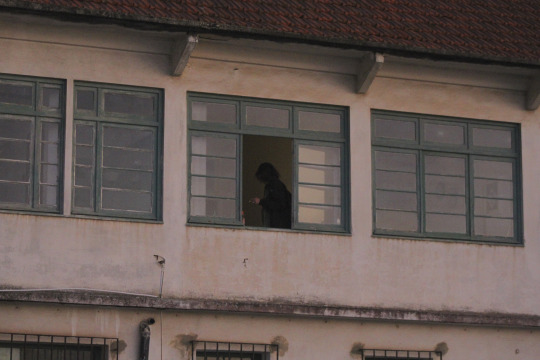
What is your fascination with autobiography about?
Awareness of a certain working method fascinates me, when someone explains a working structure for example. I’m not there yet to nail myself down to that, I feel like I still escape whenever I’m approaching it. It’s like I need to demolish the ship and go do something else. Somehow I’m resistant, but I’d love to get better at it .I love seeing opportunities, but also taking them. Staying with one thing for a longer time, is for some reason, not easy for me. It’s a strange learning process. You get attracted by different things. The last three years have been a lot like that. Before it was ten years of Efterklang and nothing else.
A lot of the lyrics on 1982, our second album with Liima, are about eternal opportunities versus sticking to what you are. Of course it’s related to things around me, but I had the suspicion it had much more to do with me, being where I am right now, in the middle of a life, looking in different directions.
(I get ourselves some more drinks inside. I realize too late I got a white wine instead of a red wine. “Apparently it’s very hard to taste the difference between red and white in the dark.”, Casper remarks. “We’re very conditioned by sight to taste the difference.”)
You also work very consciously with visual material right now in your performances.
True, they are making a movie about me - which sounds like a very weird thing to say.(laughs) A friend of mine, Sebastiao Braga, has a film collective and got intrigued by me as a figure in the city. I am constantly dis- and reappearing: a sort of present absence. There have been made some beautiful movies about Lisbon in different era’s, capturing the Zeitgeist. He now wants to portray me as a character in this specific scenery of Lisbon, create a fictive story based on reality. I invited him to come along to my solo shows, to explore what happens if I incorporate video in my performances. We developed the idea to follow me the day of the show, up until the point where I get on stage. We experiment a lot with abstract levels of images, extreme zooms, or just light and projections.
It’s something that came up after playing so many shows. It feels like you’re copying the same thing. I want to explore how to make everything a unique space, dress it entirely: play with the ephemeral. At the same time, I have been a little destructive with this idea: it started to make sense to also use these visuals for the movie.
It’s very important for him to be in the moment. Whatever goes wrong, is part of the show. He has the ability to become like an extra musician with his camera. It’s not about the right way to capture it. That which he frames, is the narrative he wants to create. The movie is exactly all those things that we don’t film. Realizing that, as a musician, is inspiring. It’s just as important to frame your work. You want everything inside, embrace all of it. I’m coming from that background, being a maximalist. I have all these tiny melodies in my mind while making songs and they need to find their place. That’s something I enjoy in my solo work now: doing very little, but zooming in, focusing on something for a longer time after all.
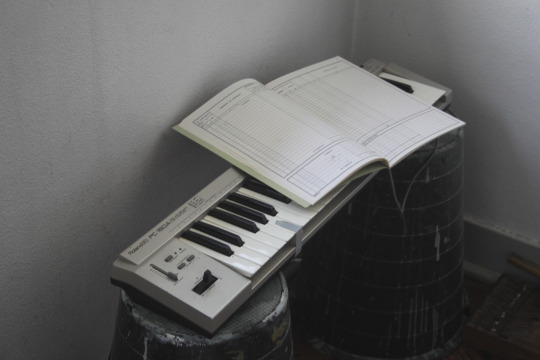
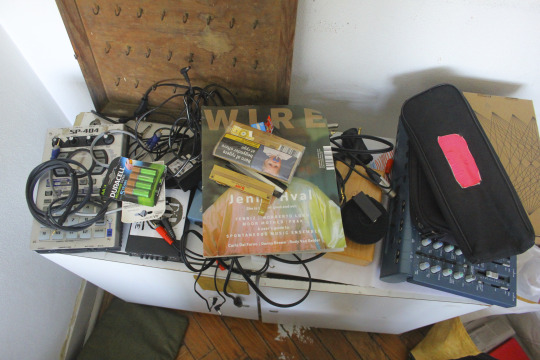
One thing you can at least hang your head on, is that you capture a certain time, a certain energy. That idea is comforting, it’s like a gift. It’s a celebration of a certain moment. To capture something is also to make a comfortable space out of it, so you can look back to it and you can think about yourself in that place. It gives you some kind of personality. But besides yourself and your ego, it says something about that place too, the people that were there, the vibe of the place. We do this with Liima too, during residencies. Certain songs are reflections of the time spent in that exact spot.
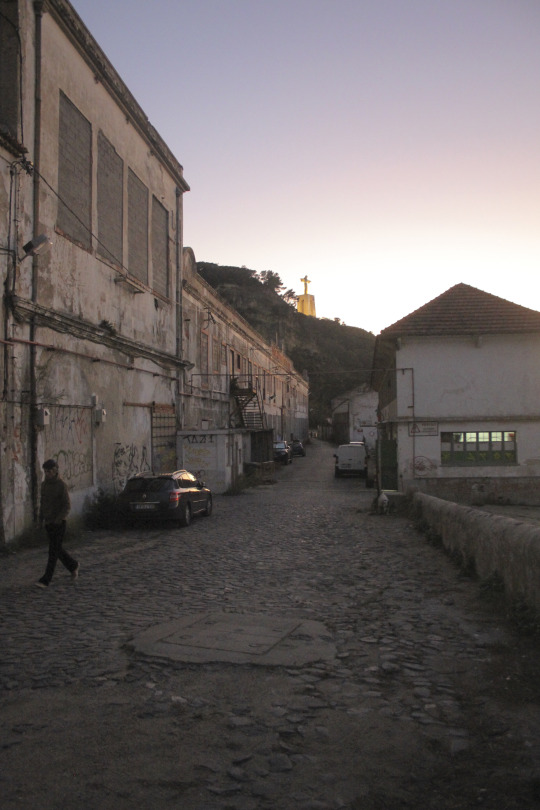
You share quite a lot on Instagram. What’s your relation with social media as an artist?
I do. I’m having a bit of bad conscious about it at the same time. I use Instagram stories quite a lot, but I didn’t think so much about the concept of stories before. The fact that it disappears again… It connects with the mindset I spoke about before, about being on stage with visuals, or being a musician. “Now I’m here, let’s make something out of that.” Of course I have my doubts about it: what do I want to share? Persona-wise: how do you look at yourself, how do you feel about yourself? You’re developing a character. The question is again about how much you’re giving away to that character. It’s the creation of a narrative: what do I highlight? Because if you just base it just on fictional elements, it doesn’t become authentic. It needs some roots in something that is unmistakably authentic. You’re creating a space for yourself, but it’s also the fundament where you’re picking up your ideas from. So what do you bring into music, or into that public space, from that space fundamentally for yourself? It’s important to create a safe ground, not to get lost in that vast ocean. Public space is an interesting given, because there’s a constant eagerness to it. You raise expectation to repeat whenever you did something great.
I don’t think I’ve found something else besides authenticity as the most real way to get things done. It’s exactly like that for singing. The very best part is when I don’t reflect about singing, when I just sing. And it carries onto other things as well.
B.O.X, Efterklang and Korus, june 2018 https://www.visitantwerpen.be/nl/barok/b-o-x
Claus & Clausen https://lesdisquesdufestivalpermanent.bandcamp.com/album/claus-clausen
Bull’s Eye Residency http://www.ruisoarescosta.com/bull-s-eye---artist-in-residence-program.html
Interview + translation: Tessa Vannieuwenhuyze Photography: Astrid Theunynck & Tom Peeters English editor: Maxim Ryckaerts Dutch editor: Britt Sterkens
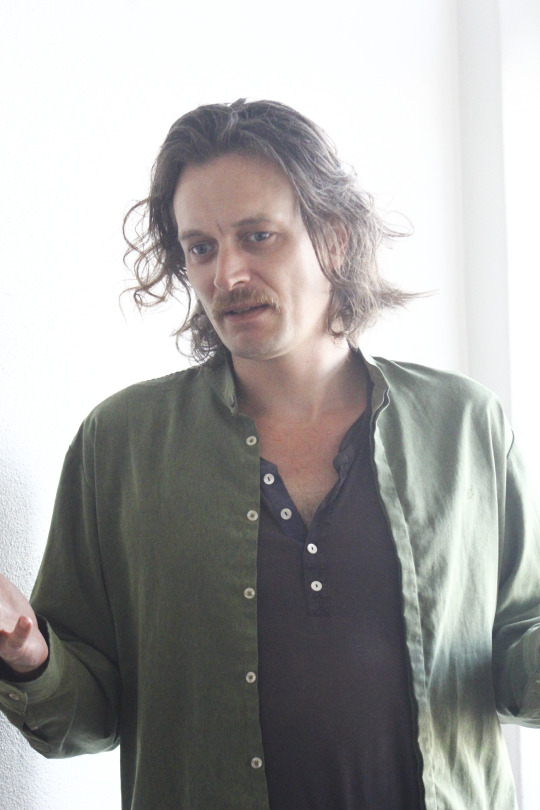
-
2 notes
·
View notes
Photo

Siska Vandecasteele
A time for clear observation.
Dutch translation.
Estimated reading time: 10 minutes
Browsing through her portfolio and books, you encounter many people amidst everyday life. A Bedouin woman in Palestine, the Cao family, pear growers in Sichuan. Or closer to home, Kristien, a woman in poverty and Johnny, a carnival employee. All of them subjects that she takes time and care for in her work. ‘I need that’, Siska Vandecasteele (°1982, Leuven) clarifies on a sun-drenched garden patio. ‘Because it’s more than just making a living, the act of taking those pictures. And I need time for that. A lot of time.’ It sounds somewhat counter intuitive to recover that balance in the hectic hassle of everyday life. Because there is so much more to tell in images than what newspapers and magazines convey. Big stories of little people, with more space for nuance as well. Even though simultaneously she takes a critical stance towards her own medium.

Self-portraits with knitwork in the snow for your project 21. Pictures of young people in their houses, combined with a landscape, for your book 30. It seems as if you reflect on your own life at crucial times.
21 was my graduation project and is indeed somewhat a metaphor for the search of self at that time. I’ve been occupied with images from a very young age. It started with the love of drawing and enjoying art-classes more than general subjects. But I knew early on that I wasn’t good enough to really stand out in that field. So I chose photography.
In a split-second I – a teenager from the ‘silent’ Kempen - was catapulted to lively Ghent. I received the basics of technical courses such as chemistry, physics and optics and was introduced to icons from photographical history. It was a very traditional education, with a focus on documentary and journalistic coverage. Every free moment we were sent out on the streets to make a report. Then you have to really get out there and talk to people. It changed me enormously. Made me more assertive. Luckily.
The pictures in the snow were made in Finland. I spent a year there as an exchange student at the photography course in Helsinki. It was more an art school. Hence, a lot of freedom. No assignments, but room to discover for yourself what it is you want to do. A pleasant experience. Though I ended up mostly knitting on myself. The result was a big sweater. Knowing me, it’s probably never going to get finished.
Every free moment we were sent out on the streets to make a report. Then you have to really get out there and talk to people.
In 30 it seems as if you went looking for peers to see what they have achieved in life. Was it a matter of making up a score?
The cause lies elsewhere. As a young photographer you take on every single assignment, which can completely absorb you. Around my thirtieth birthday it was time to change. So I decided that I wanted to start making things that were close to me again. Return to slow working. I even went back to analogue photography for this project with a 6x7-camera. When I looked around I saw peers in extremely divergent situations. One had children; the other still lived at home. Someone tried to build up a new life as a fugitive while another became transgender.
To me, that diversity between people was extremely noticeable. How everyone tried to mold his/her own life and that in the end, everything turned out quite alright.

You worked on this project for a year. You could almost call it a process.
It is. What I put forward, asks time. Really, a lot of time. Because I tend to overthink, but also because I want to create a bond between me and the people I capture in my work. I talk to them often. I love listening to their stories and that’s also a sign of respect. For them and for your subject matter. It’s just how it’s supposed to be. Besides, I couldn’t do it any other way. We need to feel at ease when we’re together. That mutuality is important. Only then I take out the camera. Sometimes, in hindsight, I feel that the connection was much more important than the result.
Alongside the portraits of people in their thirties you placed landscapes. What was your aim in doing that?
At my request they had all chosen a place with nostalgic value. Or at least a surrounding that evokes a strong memory. Looking back on it, I would like to give that section more context next time.

We need to feel at ease when we’re together. That mutuality is important. Only then I take out the camera. Sometimes, in hindsight, I feel that the connection was much more important than the result.
To give the viewer more grip? To tell us something as the acting photographer?
Hmm, the observer interprets such images in his/her own way and makes a new story with it. Whereas I observe the world, am hit by a subject and then start exploring it. That always brings about nuances. It occurs to me that because of that I can partially understand others’ point of view or their way of life, even if they are so radically different to my own.
Can you give an example of that?
My series In Presence, about mister Cao who grows pears in Sichuan. Twenty years ago he was a pioneer in terms of manual pollination. Because of monoculture and overuse of pesticides, the bees were killed. So the Chinese government promoted a method to fertilize the pear blossoms by hand. Now, twenty years later, all that manual labor has turned out to be too expensive and so the young generations leave for the cities. The countryside ages and after mister Cao, there might not be any manual pollinators left. Where is the nuance in that? Look, I’m in favor of the natural option. Just give me the flowers and the bees. But I travelled to China because it intrigued me that people are taking over nature’s role. On site it turned out that mister Cao didn’t have much choice. For him it was a way of survival and I can acknowledge that. In time he as well will be replaced. Meanwhile, he remains in his village, almost entirely alone. That touches me. That story summons up questions while it’s being told and gets different angles.

For ‘Hidden Borders’ you stayed with a Jewish Colonist and a Palestine Bedouin girl at the West bank of the Jordan. A place where all nuance seems to be completely lost.
That’s right, a very intense experience as well. Affaf is a nomad girl who wakes up very early each morning to do housework and graze the sheep. She pays three times the price the colonists pay for water. Her family has been trekking from oasis to oasis for the past centuries, in an area that has been occupied by the Israeli army as training ground. This turns her into a captive in open air. Mazal is Jewish with Dutch roots. She lives in a settlement, has a beautiful house, teaches music and is an interior architect. But she cannot leave the settlement without an armored wagon. Also a prison, right? And what I found so peculiar: in every day life she turned out to be such a warm, pleasant woman. I felt extremely welcomed by her. But then the topic shifted to the settlements, and suddenly there was absolutely no room left for nuance. The colonists live a life that is entitled according to them. For her all Palestinians are scum.
In 1 out of 4 you turn homewards, to Antwerp. You even give a camera to a woman living in poverty to make her capture her own surroundings and dietary habits.
For a project focusing on nutrition in the city I searched for a theme. 1 out of 4 refers to the fact that one out of four inhabitants of this city live in poverty. How do those people get their hands on food, I wondered. And what do they eat? With Kristien I had an instant click and she was excited to collaborate. So I gave her a disposable camera and let her take pictures. The pictures she took, were beautiful to me, and pure. Not artificial at all, but also brutal. They capture what it is to live in poverty. Every day the same packaged soup in a cup of hot water, A mountain of mashed potato with a boiled egg on top. Easy and cheap, that’s about it. Place those straightforward images next to the pictures of a ‘foodie’ Instragram-account and you’ll see the biggest possible contrast. For the same price as a super healthy smoothie, Kristien can feed herself for days. They are two completely divided worlds. How crazy is that?

I see commitment as well outrage. Do you keep in touch with people that you’ve photographed when the project has been wrapped up?
Sometimes, out of engagement. To see how they are doing, not to take more pictures. Kristien and I meet once and awhile. It brings me much joy to see that she’s doing well. Despite all the negativity in her life, she remains remarkably openhearted. You won’t hear her complain about the fugitives making their way to Belgium. According to her everyone deserves a place under the sun.
But at the same time I have to be careful not to get too carried away with a sad story. With 1 out of 4 I pushed the limits. I even got some people together to hang up posters with a photo collage throughout the city of the project. It had a huge impact on me. In the end I got the feeling that I myself was fighting a battle against something so unjust. It became so intense that it was wearing me down me and I had to stop. Even at home and among friends I was stressed. That’s how mad I was at the world. That was the sign for me to change my ways.
For a project focusing on nutrition in the city I searched for a theme. (The title, ed.) 1 out of 4 refers to the fact that one out of four inhabitants of this city live in poverty.
But still you’re doing a series on a carnival employee.
I’ve been occupied with that project for about 5 years. Can you believe it? Rome wasn’t built in a day. It’ll be ok. The scene has been of interest to me for quite some time now. From an external point-of-view, the “carnies” live on the edge of society. I’m curious as to why someone chooses to live that kind of lifestyle. Why the carnies prefer that way-of-life. Stripped of all the carnival “romance” you get to meet a tight community. Intriguing. I’ve been following Johnny, sometimes with a lot of time in-between meetings. Johnny is part of the 8th generation of a family of carnies. It’s his life; even if it’s not at all what it’s cracked up to be behind the scenes.

Stripped of all the carnival “romance” you get to meet a tight community. Intriguing.
What does the future entail?
More in-depth research. For a long time I rebelled against my classical upbringing in documentary photography and journalism. But I’ve noticed that I still have that in me as well. I’m hyper curious, like to show others what’s happening around me and leave that open for interpretation. I consider myself very lucky for everything that I’ve received from the people I’ve portrayed. The meetings in itself are a gift.
At the same time I question myself on photography as a medium. With the digital revolution photography has been trivialized. Everybody has a camera these days, even smartphones have built-in software that will make your pictures look better. We process images all day long, everywhere we go. The result is that we’d rather see the beautiful ones, instead of those containing a story. We become selectively blind.
It has influenced me to experiment with other media forms than photography. It feels less limiting. The project about Johnny has been going in that direction and will be a diptych between image and sound. With the audio I try to put forward a story about him as told by the people in his life and he himself also talks about how he perceives himself. The pictures and the book focus more on how I see him, they’re more about our dynamic. Two separate stories for two separate senses. Excited about the effects.

Interview: Chris Van Minnebruggen
English editting: Tyche Beyens
Photography: Sanne Delcroix
www.siskavandecasteele.be www.1op4.be
Order the book here
_
0 notes
Photo

Bert Huyghe
A long-term thing, at least for the moment.
Nederlandse vertaling
Date of interview: November, 2017
Estimated reading time: 12 minutes
Before visiting his studio, we meet up with Bert Huyghe (°1989, Eeklo) in a Ghentian sandwich parlor, the city being his artistic headquarters since many a year. Apart from the late post-punk band Ping Pong Tactics, the countless releases and booklets, the Geuzenprijs awarded essay The Boxer and his slightly provocative, sometimes hilarious performances, Huyghe especially manifested himself as a painter, producing thickly layered, colorful canvases, instantly recognizable by their smeary charm. With clumsy virtuosity they speak of painting itself, in all it’s treacherous self-evidence. Since 2017, Huyghe is represented by Brussels’ Rossicontemporary, alongside a.o. John Van Oers, Luc Deleu, Lore Stessel and Ritsart Gobyn.
Some time later we find ourselves in the centre of creation. Some recent works are being put up for us: a collection of football shirts, dangling from an imaginary clothesline on the studio wall in a familiar candy and Nickelodeonlike color spectrum. An eclectic mix tape of Bruce Springsteen and trap is stuffed inside the cassette player. Bert talks without uh’s, sometimes thoughtful, then again floating on a linguistic rapid. We’re caught up in a discussion on the social position of the artist. Lots of interesting stuff has already been said and I haven’t even pressed the record button yet.

You could also say that normal life consists of making two thousand euros a month and that art and strange paintings are of no value to society whatsoever.
So Bert, why do you paint football shirts?
Well, because the forms and colors attract me. It’s not about which teams or brands they represent. They are paintings, in the first place. I don’t really want to talk about adidas, or them being a big multinational. I don’t sit at my desk first, trying to decide on whatever good cause I will engage myself for. That’s not my job. Being an artist I’d rather embrace adidas, to examine such a brand visually and show it to the world, on a highly personal level. That’s also taking your responsibility. Because I really am a nineties kid, influenced by sports clothing and television during my very nice childhood. Of course I think one should be critical and reflective. But on the other hand I can’t deny being psyched about a new pair of sneakers. I wonder: how will people look upon those brands in a thousand years? That three-stripe pattern goes back a few generations now. What does that mean for us? To investigate that also means taking one’s responsibility.
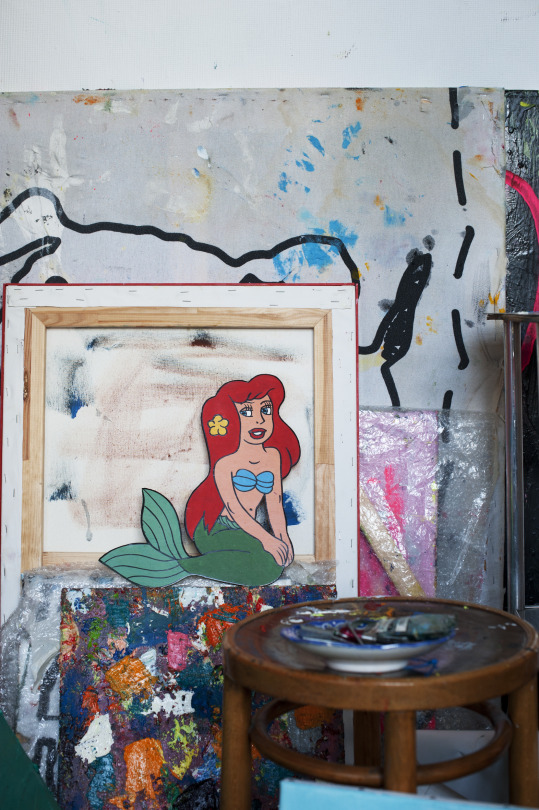
Right now we’re in a peaceful beguinage. To what extend does this environment have an influence on you and your practice?
It’s nice and quiet around here, that’s what I like about it. For me, the studio is a vantagepoint from where I can look at the world, while it’s turning upside down. You could also say that normal life consists of making two thousand euro a month and that art and strange paintings are of no value to society whatsoever. But the opposite is true: the studio is the only place of value and normality. To get back to that social aspect: I don’t think Guston painting Ku Klux Klan figures should exclusively be understood as a political statement, I presume he also did it just because he felt like painting funny shoes, or because he liked to use the color pink, or because he loved comics. Researching a medium and the world outside and what that means for you as a person, can’t be separated. You always tell something about what surrounds you. Each medium offers it’s own set of tools for doing that.
You played in a band for many years. What place does music have in your visual practice?
Music was and still is very important. I also believe Ping Pong Tactics was all about finding an honest sound. At first we where booed at for sucking at guitar - given the fact that none of us had any musical training - or for wanting to make beautiful pop songs but singing them terribly out of tune. But in doing so, we created a ground zero from which we could start all over, rather like an existentialist approach to making music. Everything’s possible, everything’s permitted, what will happen if we utilize that freedom? I also see the anachronism of that attitude. Our songs had a nostalgic touch to them, often referring to our childhood, the rural environment we grew up in. That’s also why we split up: because we outgrew it all, I guess.

Everything’s possible, everything’s permitted, what will happen if we utilize that freedom? I also see the anachronism in that attitude.

Do you miss it?
I miss the physical aspect of making music, as one can also miss the physical aspect of playing football. You should always, at a certain moment, be able to stop any collaboration. However much there is to be learned, there’s always that danger of becoming each other’s clone. Then you know the time has come for finding your own voice again.
(pauses)
To maybe answer your question: a certain childishness is also present in my paintings. It’s about therapeutically approaching my youth, I guess. Therapy is an important function of art. For the record: I did have a very nice childhood. Maybe this also makes the studio into a place of freedom, a space where you can be more like a child. At the same time, my ten-year-old self would probably say that I could make much nicer drawings than these. Thanks to the fact there really wasn’t any art where I grew up, I could approach things with an open mind once I got a little older. I often entered the room doing something that had been done a hundred times before, but just a little louder. Half the people liked it, the other half turned their backs. I didn’t really mind.
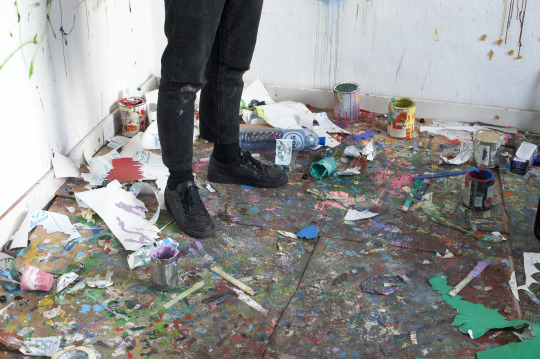
It’s about therapeutically approaching my youth, I guess. Therapy is an important function of art. For the record: I did have a very nice childhood.

Do you care about what people think of your work?
Look, I’m very glad Rossi(contemporary, red.) represents me, for example, and that they really believe in what I’m doing. This gives me time and space to seriously work towards a goal, to really accomplish something. Of course everybody sees something different in my work. When they identify themselves with themes like childhood, football or the Simpsons, that’s just great. When they think I captured an aspect of our generation, I even take that as a compliment. But the last thing I want to do is to impose an interpretation on anyone. You know, lot’s of people come in here and ask how a certain painting was made: what’s beneath this, why’s that stain there… You’re asking questions about artistry in general, social themes and such. That’s fine by me. You do your job and I’ll do mine. A child also just likes to show it’s drawing, I guess. Of course we can’t compare how a child experiences art to how an adult does. Those are two completely different things. There’s that certain cartoonish jest that I’m sampling as an adult, but in the meantime I’m really looking for a way to paint like only an adult can. I think that’s a very serious job. I believe that doing something silly in a serious way is a lot more important than … doing something silly in a silly way. (laughs)
Of course you owe a lot to history and previous generations, and this may sometimes feel like a burden. But by now I’ve distanced myself from considering Walter Swennen my dad or anything like that.
Is it still relevant to be authentic, to create something original?
I for one believe I simply am my work. I don’t really care about who’s copying what or whatever. Of course you owe a lot to history and previous generations, and this may sometimes feel like a burden. But by now I’ve distanced myself from considering Walter Swennen my dad or anything like that. However interesting I may find his work. I also learned his generation looks at the world a lot differently than ours. You see, whenever you are something, you don’t really give it a second thought. It’s just who you are, at any given moment. That’s why I don’t regret anything, artistically speaking. I do regret buying a certain sandwich, but not my art. Even bad decisions are good, if there’s something to be learned from them. I’d rather focus on the ideas still ahead of me, instead of the ones I already had. I look upon all of this as a journey that will last until I’m an old man. That’s my greatest ambition, to do this forever.

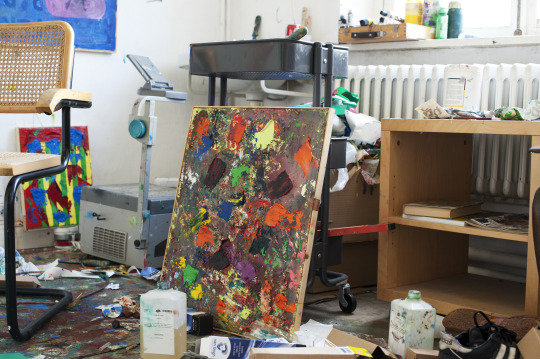
I believe that doing something silly in a serious way is a lot more important than … doing something silly in a silly way. (laughs)
You are known to produce a lot of releases and editions, be it independently or not. May we expect anything soon?
My most recent booklets or ep’s where the result of a more intense process. This felt more to the point, in a way. Like you said, my production flow used to be a lot bigger. People like Gerard Herman also taught me a lot about releases and graphics. But here again, I currently look upon myself as a painter. It’s just what consumes all of my energy right now.
I guess something important has changed in that respect. Look, this might be interesting to show you guys (takes a big painting, puts it on the wall). I call this one my Cy Twombly. I still like Twombly’s work a lot, by the way. While I was making it, I tried very much to paint in a poetic, intuitive manner. Stuff accidentally falling on the canvas, drippings, stains ... You know, right. That way it almost turned into a beautiful abstract. Something in me resisted right away. I felt like that country boy again, not fitting in with all that prettiness. So the next thing I did was put on my name in big letters. At the same time, I also couldn’t make it into a purely conceptual painting: a white canvas with my name clearly printed out. Both attitudes are in perpetual collision. I was inconsistent, which is very important for an artist. Lately I tend to lean more towards the calculated approach because I’m making a series now. I believe it’s a long-term thing, at least for the moment. In that sense my work isn’t much like Swennen’s anymore. I can’t imagine him ever making a series.

As you’ve probably noticed, some time ago it was very hip to paint these meaningless abstracts with clumsy frames around them. But the fact that it’s a gimmick doesn’t mean I’m forbidden to do it also.
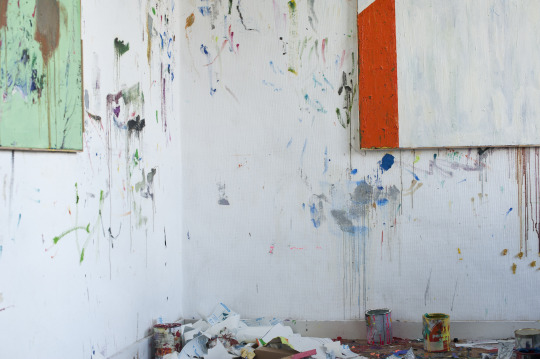
You’re working on landscapes now: a classic theme within painting. Is that part of the change you mentioned?
You know why I’m doing that? Because my grandmother once asked me when I would finally paint a landscape (laughs). My interest for The Simpsons and cartoons in general, from which I derive them, was already present. It’s just a nice coincidence that this connects to art-history. You know, we used to live in a beautiful rural area called Sint Laureins and this influenced me a great deal, but nature and landscapes we mostly just experienced like all kids do: within the artificial frame of a television set. No doubt I owe a lot to the canon. The Simpsons and football are also part of that canon, by the way. The bright colors of football shirts positioned on a pitch, the way they contrast one another: that’s painting in real life. It’s part of what attracts me in that sport. I could only find that out by intensively making lots of paintings. Constructivism was also influenced by sporting outfits, I’ve heard.
(pauses)
Actually, it’s all about painting. Everything else is just an excuse. How a painting is made, that’s what I find most important. The way I paint it, how that sets me apart from other artists. As you’ve probably noticed, some time ago it was very hip to paint these meaningless abstracts with clumsy frames around them. But the fact that it’s a gimmick doesn’t mean I’m forbidden to do it also. It’s about making an interesting image. Do I remove the black lines from a cartoon? Yes? So, why am I doing this then? Because it leaves me with plains of color, interacting with one another. That’s when it becomes a painting. Everybody thinks Lichtenstein just painted comics, for example. That’s not entirely true: he really selected those images, altered them, fixed the composition. All until they spoke as paintings, until only the right tension remained. I never dislike something somebody else has made, by the way. Worst-case scenario it’s just boring.
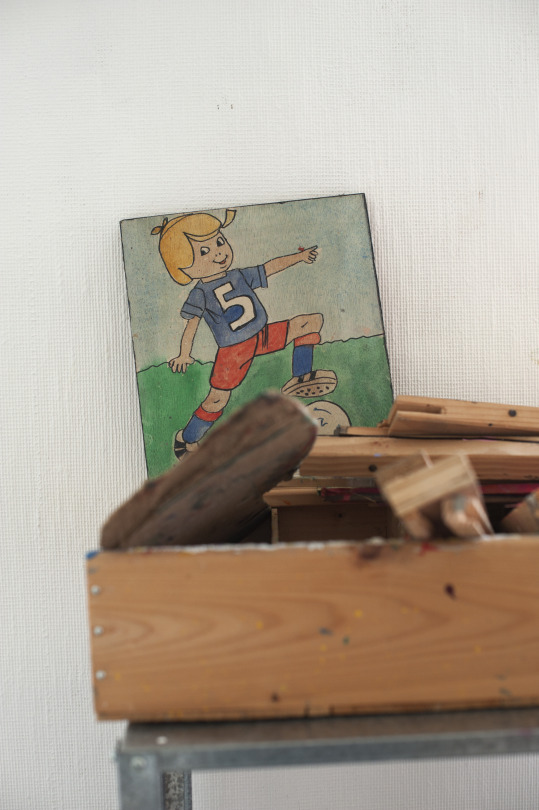
That’s the most profound quality of paintings: them being physical objects. You can just watch them as an accumulation of paint, a collection of colors. It’s a residue of an act.
Do you watch The Simpsons waiting for the right still? Or how do you start a painting like that?
No, I select images from the hundreds of interesting blogs exclusively occupying themselves with collecting Simpson’s screenshots. In that sense my method of image hunting is very contemporary. But that’s not what my work is about. I don’t really believe in the influence of, let’s say, social media on my work. I think people are still very much analogue beings. Internet and social media are just practical tools as far as I am concerned. That’s the most profound quality of paintings: them being physical objects. You can just watch them as an accumulation of paint, a collection of colors. It’s a residue of an act. To understand this, you don’t have to have any connotations. I believe, that as long as it’s good, it’ll float like oil. I don’t want to make a puzzle that has to be solved or anything. Some people like that about art, when there’s a solution. But that one solution doesn’t exist, if you ask me.
Interview and English text: Maxim Ryckaerts
English editing: Maia Daley
Photography: Sanne Delcroix
www.berthuyghe.be

_
0 notes
Photo

Henry Andersen
The riskiness of seduction and the plastic language of LA hip-hop in melting pot Brussels.
Nederlandstalige versie
Date of interview: November 23, 2017
Estimated reading time: 17 minutes
“Off to Brussels”, that’s what Australian-born artist Henry Andersen (°1992) scribbled down on the note he left for his fellow travellers on his first trip to Belgium. Several years and a detour via Berlin later - where he studied with the Austrian composer Peter Ablinger - he is now officially living in the Belgian capital and wrapping up his Master of Fine Arts at KASK in Ghent.
Just like Henry himself, his artistic practice can’t be easily fixed in time and space. Henry produces a variety of artworks and performances, ranging from a Slow Reading Club dismantling the choreography of readership, to a conceptual album, to architectural installations. His work oscillates between the visual arts, sound art and performance, transforming along the way. Stanzas or The Law of The Good Neighbour for example - a word game piece – exists as a printed work, a performance, a released record and a curated group exhibition.
On a particularly gloomy autumn day, we arrive just in time on Henry’s top floor flat in Ixelles to escape the stormy weather. Australian-born, Henry isn’t particularly used to these sudden seasonal changes “This year I am prepared for a proper winter though”, he smiles. With a portrait of our ancient king Boudewijn overlooking the plant and book filled living room, we discuss his widespread trajectory over a cup of coffee. Moving around the house during the interview to explore what spaces and surroundings mean, he is always elaborating his answers, moulding them in order to scan their borders: a characterising element of his artistic approach.
‘Stanzas’ or ‘The Law of the Good Neighbour’ released on KRAAK
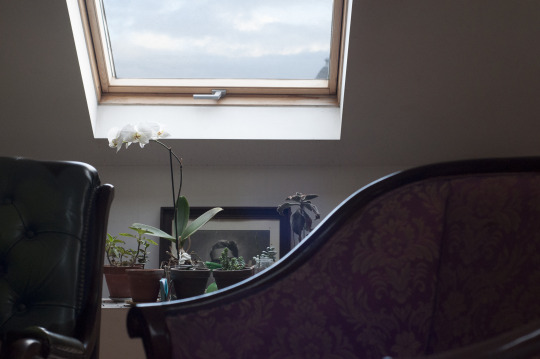
It’s not exactly easy to pinpoint what you do. How do you actually introduce yourself when you meet new people?
(Smiles.) What I do and how I introduce myself are different questions maybe... Generally I just say that I’m an artist and that I mostly work with text. I use written text and spoken text. Sometimes I write myself, sometimes I find text, sometimes I commission or alter text. Almost every project is beginning with text and then the endpoint changes. So I make a lot of performances, some printed material, some installations, some sound recordings.
But always starting from text?
Yes, text always seems to be the starting point nowadays. And then it’s often developed in some kind of collaborative format. I like to work with people around me. It’s a way of being less precious about the finished result, and it’s also usually a much more gratifying and fun way to work.
For example, the record I released on KRAAK is a recording of the readings I do with friends. It’s something I have been doing for years, and it ends up being a documentation of different relationships around me. It means I'm always working with friends to realise the recordings, and that the particular qualities of their voices and their relationships are given a lot of scope in shaping the piece.
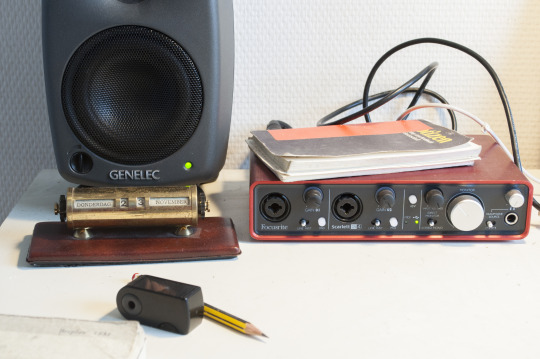
There are a lot of really interesting people working in that city, but at some point, I started feeling a little limited with that scene.

You studied music composition in Australia before moving to Berlin. How do you still relate to the idea of being a composer these days?
I wouldn't really call myself a composer anymore. When I was in Germany, I was composing music for others. I was much more involved in producing music for other people to perform, in spaces dealing with experimental, classical music. There are a lot of really interesting people working in that city, but at some point, I started feeling a little limited with that scene. It’s quite dogmatic in certain ways. I had a lot of friends working as visual artists, and I wanted to move more into that setting. So moving to Belgium was a way to formalise that shift somehow, by studying fine arts in Ghent. Since I’m here, I don't think of what I do as being so strictly related to composing anymore.
The kind of composing I was involved with is very reduced, very German, conceptual composition. It’s working with simple blocks of material. It has a lot of parallels with structuralist film-making. So even if I'm making less music now, I think those ways of working still have a lot of impact on how I think about form. The other thing is that as a composer you work very hard at how your ideas are communicated to a player, so I think that interest in different models of communicating ideas – often deliberately leaving stuff a bit vague and open to interpretation– carries over to what I am doing now.

So it was a very conscious shift into visual art as your main thing then?
Yes, but since being here I feel like I'm moving between contexts quite often. I made a record, so I end up performing in music contexts. Now with the Slow Reading Club project, with my friend Bryana Fritz, we end up performing in theatre spaces. It feels like this kind of practice is allowed in Brussels in a way that isn't necessarily the case in other cities.
There's something very nice about that freedom. It means you get to interface with different spaces, different audiences who bring their own frame of reference, different types of attention. It is interesting to think about what’s expected in a particular setting and then decide how much to go along with it, and how much to try to bring in other frames of reference. So for example, with Slow Reading Club we organised a reading in a theatre, Beursschouwburg. We decided to try to use the technologies of the theatre - stage lighting, for example, or even just the fact of gathering a whole group of people together at one time – but to try to push other kinds of durations, other sets of experiences. So the whole thing was very long – about 3.5 hours - and it started at 11pm which means it starts to draw on all these expectations of a party or something. We served people rum, we used a carpeted space. We wanted to play with those different frames.
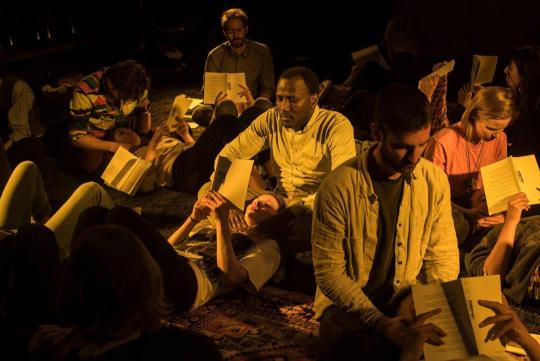
Slow Reading Club at Batard Festival Photography: Cillian O'Neill
It is interesting to think about what’s expected in a particular setting and then decide how much to go along with it, and how much to try to bring in other frames of reference.
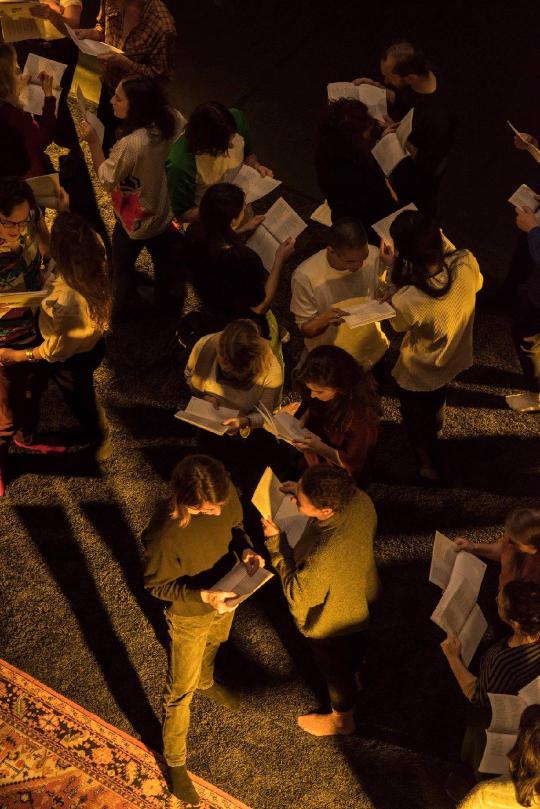
Slow Reading Club at Batard Festival Photography: Cillian O'Neill
(Recently) I noticed his notes in the margin of Foucaults’ Discipline and Punish. He must have made them when he was more or less my age now. I was fascinated by the idea of having a relationship with him at that age.
How does that align with the Wansbrough piece, the font you made based on your father’s handwriting?
My dad’s kind of an interesting guy. (laughs) He made documentary films about particular leftist concerns in the 80s in Australia. When I was stealing some books in my parent's house a while ago, I noticed his notes in the margin of Foucaults’ Discipline and Punish. He must have made them when he was more or less my age now. I was fascinated by the idea of having a relationship with him at that age. I took scans of his handwriting and developed it into a digital typeface I can use myself.
There’s a lot of love in it as a piece, but at the same time it’s a hollowed out, fleshless format - to reduce someone's private handwriting into a typeface and give it away for someone else to use. To display the piece, I ask that a space use the font for any external communication – so any invites, any posters etc. should all be written in this slightly clumsy font. I liked the idea of giving away the responsibility for what content the font would be used for. I wanted to keep it as functional as possible.

If your father was a filmmaker, I imagine you got in touch with art quite early on.
Not so much. There was a lot of literature around when I was younger, my parents read a lot. So I was exposed to literature early on. Also to music, there was some music around in the house. But I hated music until I was thirteen – other than this one CD I had of the Traveling Wilburys. (Laughs)
You hated music?
Yes. It used to really upset me. I didn’t understand why listening to music was something that people would want to do with their time. Still, I somehow ended up in a band when I was a teenager. I played guitar. It just seemed like a fun way to hang out with friends, to be in a band. I got into composition through that.
But I was only exposed to contemporary art quite late I would say. It’s getting much better these days, but there wasn't so much contemporary art around in Perth, at least not so much that I had access to. I started going to much more exhibitions when I moved to Europe. The first year I was living in Germany, the first thing I’d do when I arrived in any city was go to the museums and see all the permanent collections that each city had built up. I learned a lot from just wandering around – about how all these artists related to each other but also just about what sort of work I liked, what I responded to, what experiences were possible in a museum space. I really loved this feeling of just swallowing it all in and being totally fascinated.
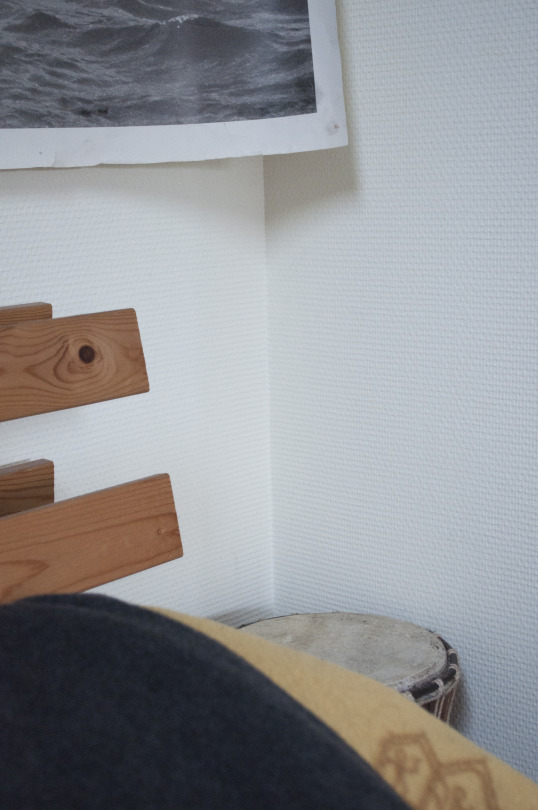
‘Stanzas’ or ‘The Law of the Good Neighbour’, was maybe the first time I really worked with language again after university. That was also the summer I was listening to a lot of hip hop, particularly stuff out of LA.
When did this fascination for language occur to you then for the first time?
I had a really good English teacher when I was in high school, she would always encourage me to write prose and poetry. Nothing I made in university had any language element to it though. So then I got a little bit away from it. ‘Stanzas’ or ‘The Law of the Good Neighbour’, was maybe the first time I really worked with language again after university. That was also the summer I was listening to a lot of hip hop, particularly stuff out of LA. Those guys have this amazing, plastic way of using language. Making things sort of flex around the rhyme, even if doesn’t always make sense in terms of content. It’s very elastic and playful, and often really funny as well. The text is sort of caught between being a method of delivering content and an aesthetic object in its own right. That was definitely something I wanted to think about in my own practice.

Gradually, I started to realise that because I'd been adding to the list for such a long time, over years, it started to have this very autobiographical function.
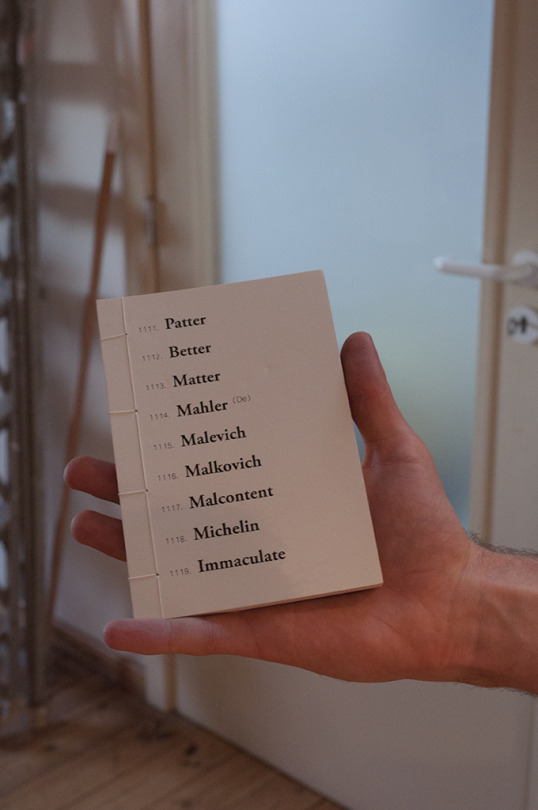
Did you start the word list for ‘Stanzas’ very consciously or was it a playful coincidence?
It was definitely playful. It started at home one night for fun. I didn't necessarily have any plans to make it into a piece, but I enjoyed doing it. Even after the first performance or two, I didn't think of it as a piece. It was a fun thing to do with people I met. Basically, the list is just constructed by adding words which sound like the word before: “human”, “hammon”, “harmon”, “mormon . Gradually, I started to realise that because I'd been adding to the list for such a long time, over years, it started to have this very autobiographical function. When I was living in Germany there were a lot of German words, or place names from around Berlin -“Schlachtensee” for example, which was always my favourite lake to go swimming. Since I moved to Brussels more and more French words crept in but at the start it was very basic things like “jus de pomme”
I organised a lot of readings where pairs of friends would read sections from the list. Sometimes for a public, but more often just in their apartment on a Sunday afternoon or something. I built up quite a big archive before I thought much about how to present it. Then whenever I would be invited to present something, I would think about different ways of making this activity public.
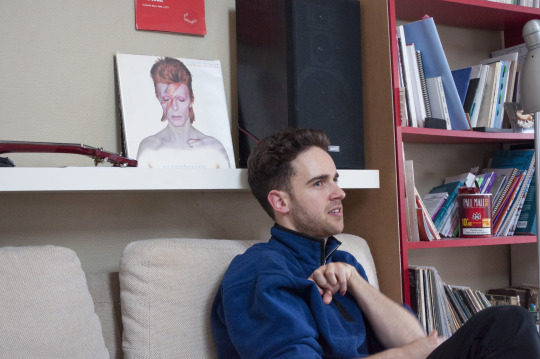
Can you still turn off the list in the back of your head when you listen to people these days or has it completely structured the way you listen?
It’s a nice question. There were periods where I was writing it way more intensively, when I was writing every day. At the moment I write very occasionally. Usually there is a hangover of an hour or so, where after I finish writing I'm still thinking about words in terms of how they sound next to each other, rather than what they mean. It’s a very awkward state to be in if you turn up to a party or something. (Laughs)
Now it only happens when I hear a word that I’m really seduced by. Some words are really seductive, for some reason, because they have a strange sound or they remind me of something really specific.
I think a lot of my work is about being seduced.

There’s definitely a sensual side to your work. How important is that notion of sensuality in your work?
I think a lot of my work is about being seduced. I’m very interested in what seduces me. It’s a good motor for me to start working on something. I don't mean it in a sexual way, more like this whole-body fascination for something. Where it gets stuck in your head. The best example for me will always be being a teenager and listening to a certain band. Where you don't just want to listen, you want to read every interview online, start to dress like them or whatever. It’s some kind of extreme hunger. Something that you feel on a bodily level.
As an adult the feeling is much rarer and usually less intense – otherwise it would be difficult to get anything done - but occasionally I still feel a really bodily reaction to something that peaks my interest. A lot of projects for me start like that.
The folding screens, Paravents, started out like this. I found this image online, of a set of room dividers that were designed by Eileen Gray in the fifties and I was totally seduced by it. I've never seen the original objects, but in the image they seem extremely strange. Like some kind of half-way point between and animal and a wall. They confused me and building them was a way to figure out how to deal with that feeling. I spent a huge amount of time building and cutting and I just guessed the scale in the end. It wasn't the idea to make a faithful reproduction. I’m more interested in the image of them than I am in the actual objects.

Seduction has a vulnerability to it that I like. It’s much riskier than keeping critical distance, it often ends in tears.
So it’s more the fascination for your own fascination then?
Totally. Fascination is an important clue for trying to locate yourself as a body in a terrain where bodies don't necessarily exist: a study of the body where it isn't. This is particularly the case in language. I think language is usually understood as something bodiless: over here is language and over here is the body but the two don't really meet. I like the idea of working with language but being really consequent about the role the body plays in the equation: how does my skin feel when I read, how does the musculature of my face move when I speak etc. More broadly, I think bodies present a challenge because they are non-exchangeable. They are always specific, so they don't really belong to a late-capitalist logic which is so constructed around measurability and exchangeability. That makes them very important, I think.
Seduction has a vulnerability to it that I like. It’s much riskier than keeping critical distance, it often ends in tears. But I like this kind of proximity, this way of dealing with material.
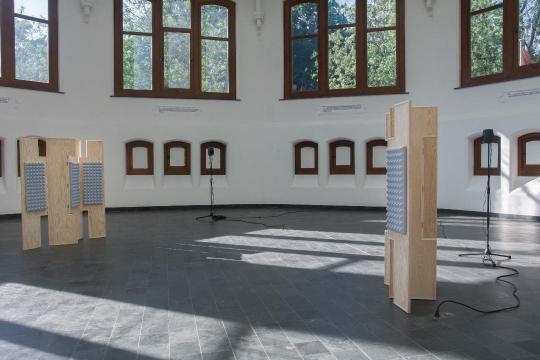
Henrys’ graduation project in KASK, Ghent. Photography: Omar Chowdhurry.
How did you start the Slow Reading Club?
I met Bryana at Batard Festival in 2013 and we kept in touch when I moved to Brussels. We always wanted to work together and we had a joke that we ran a reading group, though we never once met to read together. One night we were drinking together in a bar and for some reason we wrote a manifesto for this fictional reading group – about how to think of reading as something embodied and erotic. It was a fun document to make – lots of slightly crude jokes. Amazingly, we got invited to participate in a festival (kunstenfestivaldesarts) based on the manifesto, so the text came first and the project kind of developed out of that. It was interesting to work on something with this fixed document in the background. I think it kept us on track.
Basically, the whole thing came from the question of how to suspend critical reading. We wanted to try to read texts without using all of these techniques of critical reading and deconstruction that we'd learned through arts education.
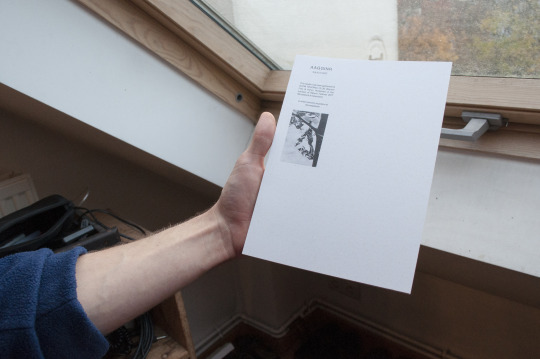
Can you completely turn off criticality?
Probably not. But I believe that there’s very tiny brief moment of aesthetic experience before you can put something into language or understand it. It’s not the idea to grasp this state – I think that wouldn't be interesting – but about setting up the conditions for it to emerge. What do you need in space to let that happen? What happens if the lights are yellow for example, what happens if there’s alcohol, or if you have all these other informations of smell and touch interrupting the reading process? What kinds of conditions can we set up in order to let that emerge?
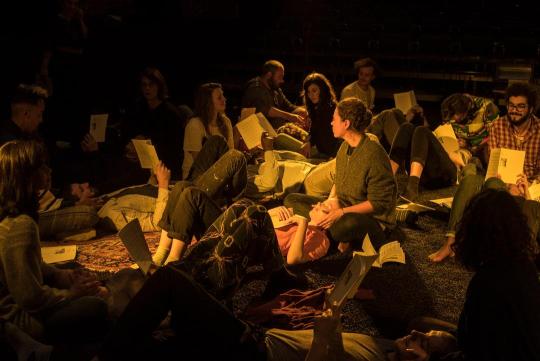
Slow Reading Club at Batard Festival Photography: Cillian O'Neill
What are the plans for the next Slow Reading Club editions?
The texts that we read change every time. Each time we organize a session, it’s a kind of answer to the last one. So for example, for the first session we had a lot of texts that would deal with the nighttime or with a thin edge between the self and the world – everything kind of expanding outwards. So then the second session at La Loge, was about fetishizing confinement, fetishizing enclosure and the walls around you. Then in Batard, we wanted to break with the idea of enclosure and get into this slightly magical thinking where bodies are always changing shape – turning into animals for example. It was a lot of texts about mimicry and doubling.
Next, we'd like to maybe think about coldness. Until now, everything has been performed in a kind of soft, warm space. It’s been a lot about tactility and community. We want to experiment with something a little more alienating.
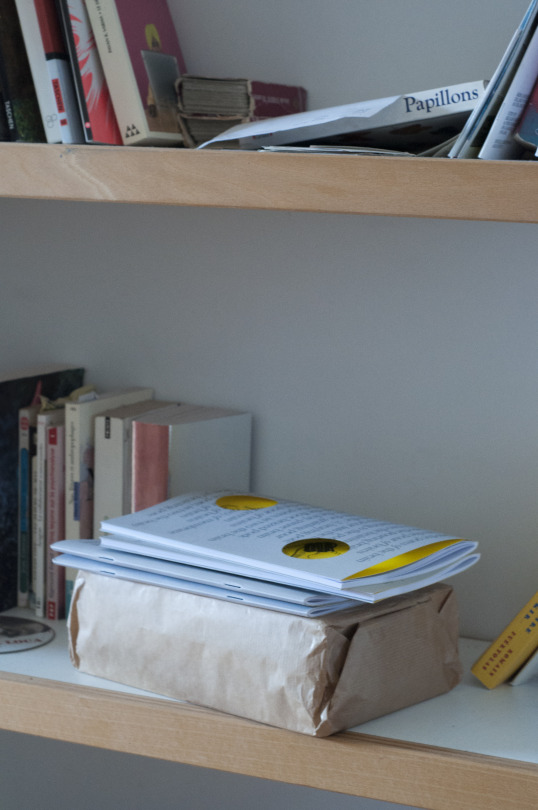
The manifesto states that SRC aims at the production of some kind of excess, a word that occurs repeatedly in your portfolio. Can you elaborate a little on that?
Excess is everything that doesn’t fit the frame. If you want to make excess make a frame. So excess is somehow like this unknown and unknowable territory that is blossoming out of everything that is happening all the time. It’s a material you can't really handle or make sense out of.
For my record launch at Brussels gallery Damien & The Love Guru in May last year, I was somehow interested in this idea that every time you make something, it generates all this excess that you didn’t mean to generate. I wanted to see how I could deal with that. With the album, I had all these friends that had given their time to make readings. There was this kind of excess of people that couldn’t fit onto the experience of that record. Everyone who had given a reading had some practice of their own – as dancers, writers, artists. I asked everyone who had done a reading to show some excess or overage from their own creations – people showed prototypes, or cut up old works into new ones, Marion Menan showed a film that she had previously use as a backdrop for a dance piece, Eleanor Weber wrote a very beautiful play using a bunch of scraps of her own writing that had not been published because they had been rejected, or cut out in editing or the research had just gone in another direction.
The idea was to make manifest this kind of imaginary community of people who were surrounding the record and to make manifest all of these overages spilling out from their own work. I wanted it to feel like a collection of stuff relating to the people involved, without everyone feeling that they had to put their best foot forward like in a group show.
It was totally not minimal: too hot, too much color, too many people. I loved that with this austere minimalism, the gallery was full of sweaty bodies.

I also wanted it to be a very joyous event. I had done a few readings already in the months before in Brussels, so it didn’t make sense to just do that again. The piece is funny in a way, but also austere and a little disinterested, so I wanted to the launch to be the complete opposite. It was totally not minimal: too hot, too much color, too many people. I loved that with this austere minimalism, the gallery was full of sweaty bodies.

Where do you work or create the most?
It changes a lot, now I’m a lot at home in my apartment reading, but I was working in a wood workshop to make the room dividers for example. I’m also looking for a studio at the moment. I like to have a place to come back to. So I don’t have to think about my washing when I’m working.
I think now more artists should work in office spaces – to get inside the warm carcass of the global financial crisis.
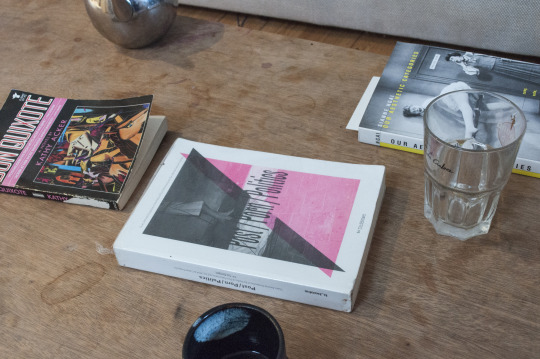
What would be a perfect home or studio for you?
I’ve never really done much to the houses that I’ve lived in. Before I was always in shorter-term rentals, this is the first place I have been for a longer time and I haven’t changed that much. There’s a difference between the kind of architecture I like to think about and the houses I'd like to live in. I'm writing a lot about modernist architecture at the moment, but I don’t know what it’s like to live in those spaces. It might be horrible! Those houses fascinate me, the way they propose a different way of living, but I don’t know if I would actually want to live in one.

As for a studio, for a while I was really into the idea of working in an old office space – blue carpet, potted plants, water cooler. In Britain in the 1980s you had all these YBA artists setting up in old factories because the industrial sector in that country was completely collapsing. It developed into a very specific aesthetic. I think now more artists should work in office spaces – to get inside the warm carcass of the global financial crisis.
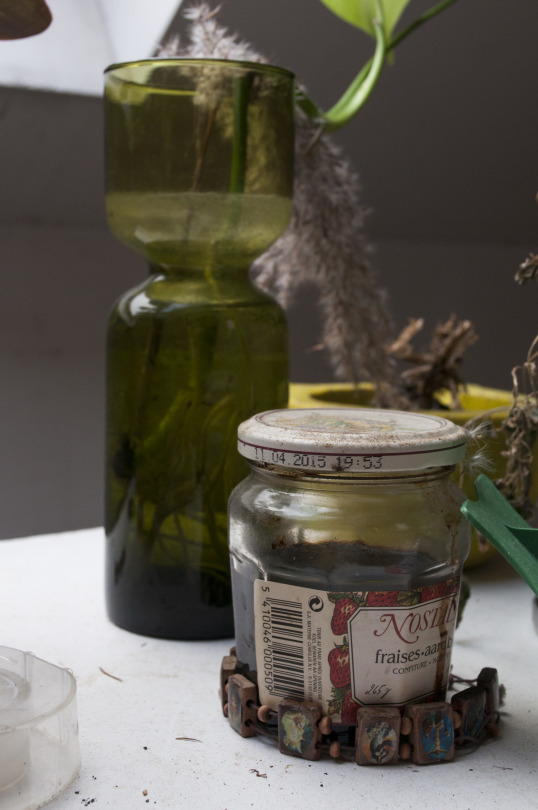
And the people here (in Brussels), that’s the main thing. That feeling of familiarity, conversations that can stretch over months, and even years. That’s what makes it feel like home.
Is Brussels home for you right now?
I like it a lot, so I think so. There are a lot of interesting people floating about and it’s the size that I like. Berlin was somehow too big for me. Here the city is small enough that I feel part of a community. I feel like I have an idea of what’s going on in the city even though there’s still too much to see. There’s influx of different sorts of information and I really like the mix of languages. And the people here, that’s the main thing. That feeling of familiarity, conversations that can stretch over months, and even years. That’s what makes it feel like home.
What I find really striking is the excitement that pours out of your work, as though always on the lookout for new possibilities. What is something you’re particularly excited about at the moment?
I’m really looking forward to this winter actually. (laughs) I think that there’s something in trying to love what you normally really hate. I used to hate writing emails, now I started writing these very flowery emails and I’ve started enjoying it more. So yeah, this year I'm trying to convince myself that I enjoy the winter, just by pure force of will.
Interview + translation: Tessa Vannieuwenhuyze
Photography: Tom Peeters
English Editor: Henry Andersen & Steven Kremers
Dutch Editor: Britt Sterkens
_
0 notes
Photo
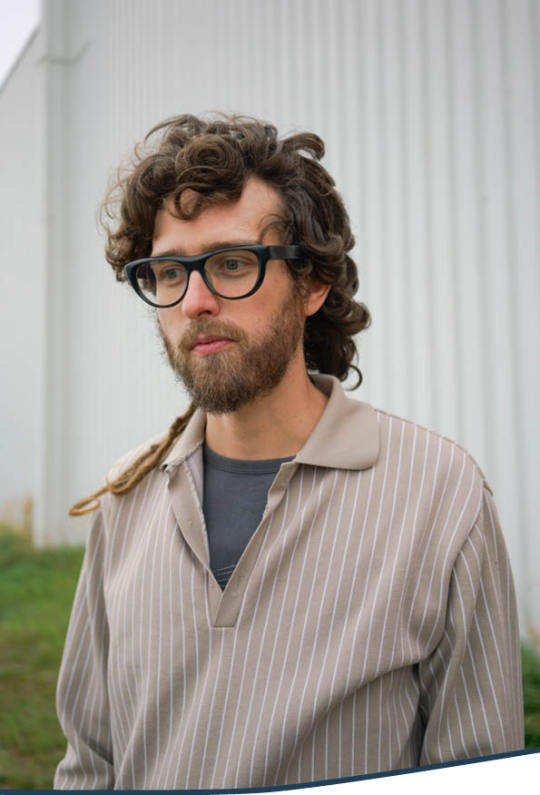
Octave Vandeweghe
How fascination with stone led to a search for the religious
Nederlandstalige versie
Date of interview: August & December 2017
Reading time: 11 minutes 40 seconds
Octave Vandeweghe (°1988) studied industrial product design before trying his hand at Goldsmithing and Jewelry Design at Sint-Lucas College, Antwerp. Frustrated by Industrial Design, he decided to pursue goldsmithing and jewelry which allowed him to give his products a more personal touch.
Before we start, I take a little more time to enjoy the view. It still feels quiet and secluded, under grey skies waiting to shine in the sun.
After a bit of wondering around the northern docks of Antwerp, we come across Octave's white caravan. It is accompanied by a few floating houseboats in the dark Scheldt water. Octave is a tall young man, calm and serene. His van feels somewhat isolated, set against a wall in the pouring rain. Despite the dreary weather, he has opened his doors to us. I carefully climb aboard a structure that resembles a verandah, cozy but functional. A pot of Moroccan mint tea simmers on the stove while classical music comes out of a tiny stereo mounted on the wall. It’s the perfect atmosphere to quietly awaken to. Before we start, I take a little more time to enjoy the view. It still feels quiet and secluded, under grey skies waiting to shine in the sun.
Later Octave shows us his studio. It’s in a well-hidden warehouse which he shares with some colleagues and his girlfriend, the Israeli artist Dana Seachuga.

Where do you spend most of your time?
Most of my days are spent in my studio. I leave early in the morning and come home late at night. When I arrive in the evening, it’s to relax. I don’t work here.

What’s the most important part of your studio?
I must be able to feel at ease. A stark white environment wouldn’t do it for me. I reorganise it constantly to fit my mood. That’s a big part of my working there. I’m always trying to create a warm and friendly environment because I spend so much time there.

Your studio is huge. You share it with other artists and creative people. Do you prefer working with others?
I like working alone, but I prefer not to work alone in my studio. At the moment I share it with five people and I like the interaction. We don’t need to talk constantly. But sometimes it’s useful to have others around when you’re having difficulties with something. If I’m looking for a solution to a technical problem, there is always someone who can help me. The sheer size of it has allowed me certain opportunities.
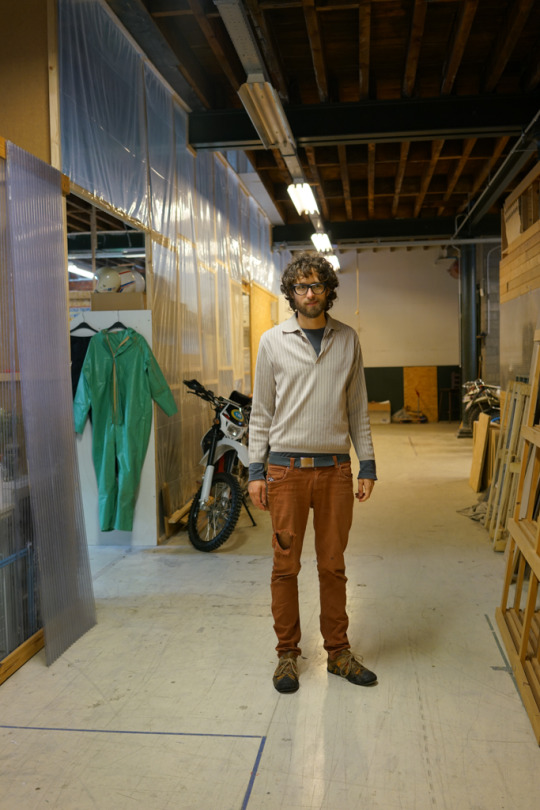
My mother was an avid collector, and my father still is. He’s incapable of throwing out anything from that period, so his home is filled with sentimental objects.
In your assemblies you combine a range of many different objects. Where did your search for objects begin?
It started with collecting utensils and parts of utensils that caught my eye. I found these on the street, in container parks or second-hand shops. These objects did not have to be complete for me. Sometimes I didn’t even know what they were for. Many objects I found in the attic or cellar or garage of my parents’ place, crammed along with stuff from my father, my deceased mother and my grandparents. My mother was an avid collector, and my father still is. He’s incapable of throwing out anything from that period, so his home is filled with sentimental objects. I guess I inherited it from him. It brings with it a certain struggle. On the one hand, I have a great aversion to this type of hoarding nature, on the other hand it’s something that fascinates me.

I study the history of an object, the material used and its transformation to create 'poetry'.


How do you work once you have found the 'right' things?
Actually, I don’t assemble found objects anymore. Even though I was convinced of the things I made, I sometimes found that the work I produced became ‘lost’ in the world. In my recent projects, I start with a subject, theme or niche. I study the history of an object, the material used and its transformation to create 'poetry'. This comes after a long investigation.
During one of my exhibitions someone asked me if one of my objects was a knife or more like a gem. I couldn’t answer this with conviction because this isn’t really something I consider. The two come together naturally. But it did make me consider the material and the feeling of the objects more closely.
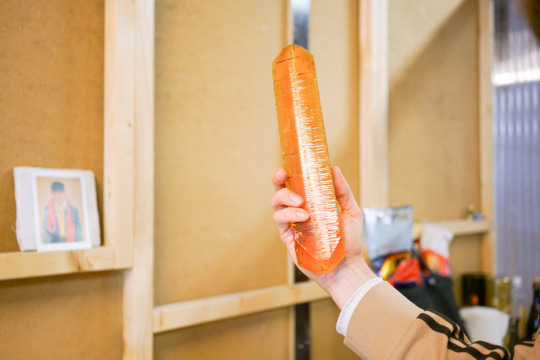
A slogan you used in one of your exhibitions was "What meaning do things carry in relation to our everyday life"? What led you to this idea?
It evolved that way. I often look at an object I’ve been using all my life and wonder: "Where does this come from? Why is it like this?" Most people don’t give it a second thought and that’s quite normal. I really find it fascinating to dig deeper into the history of an object.
What feeling do you want to create when redefining it?
I don’t find it necessary to create a specific feeling. Although in my recent work I’ve been exploring that. In my previous work, it’s been about the search for something ‘different’, then taking that apart and offering a new insight to it - it's not so much about feelings.

A gemstone arises and grows in a very specific form, through crystal formation. It is a very hard material, which carries within it a kind of eternity.


The exhibition after the period of your assemblages is called "A Brilliant Cut", you started working with gemstone cutting. How did that transition come about?
To be honest, I never thought that stones were really that interesting. Certainly not gems, because it made me think of jewellery. I didn’t know the scale of what was possible within it. I was mainly working on the theme with 'knives'. I did some research and when studying the genesis of knives, I ended up with stone! Two images I saw stuck with me. It was the structure of 'flint' knives and the ‘faceted diamond’. The different relationships between the two. This led me to start working with stone. The result was a smaller installation of three objects, three forms that referenced knives.
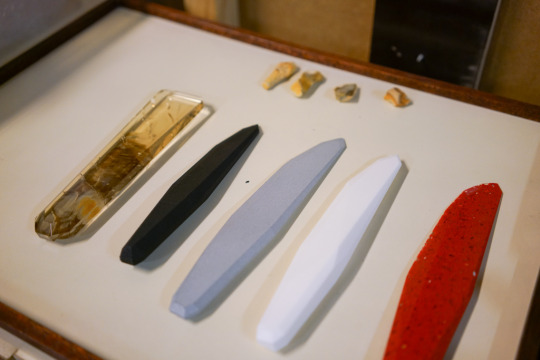
The deeper I have gone into it, the more interesting it has become, also because it’s a totally unknown discipline to me. In any case, it’s a fascinating material. A gemstone arises and grows in a very specific form, by way of crystal formation. It is a very hard material, which carries within it a kind of eternity. Silver and gold, for example, is different. If a future generation decided to throw everything in a pot and melt it, the shape would be completely lost. This is less evident with a stone. You can grind it into something new but there’ll always be some loss.

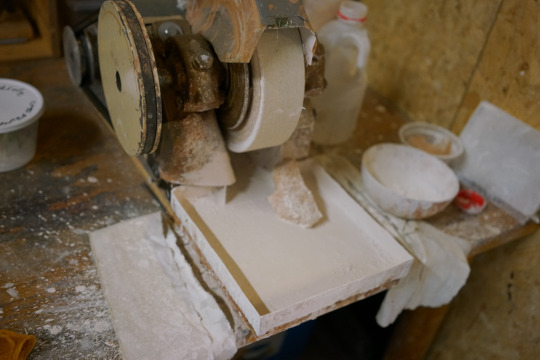
A quote of yours that really struck me is: 'Objects are more often "waiting to be used" than "being used".' If I look around here in your van, I don’t see too much stuff. I suspect you might think we have too much ‘stuff’. Would I be right in thinking this?
You could say that, yes. Although I'm not entirely sure why it bothers me. I think I’m a bit bothered by the number of things that come onto the marketplace. Things that have not been properly thought through or that just aren’t necessary. For me, this is more problematic than people who own too much stuff. I personally also enjoy being surrounded by lots of stuff.

You do?
Yes, but that’s because of my upbringing. My dad’s insatiable collecting played a huge role in it. After my mother died, he hardly threw anything out. It was the same situation when my grandparents died, from both my father's and my mother's side. So now he’s surrounded by a huge number of things... I don’t want to live like this, but I’ve been influenced by it. That’s why I live rather minimalistically here in my van. Perhaps in reaction to it.

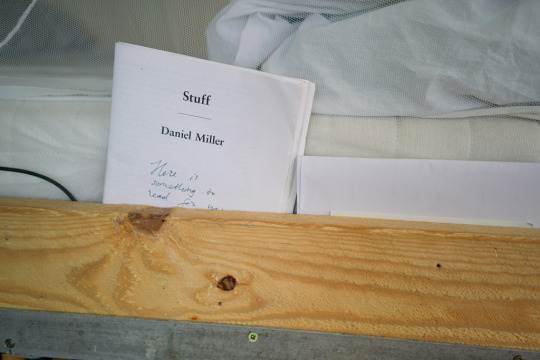
Why do you actually live in this van?
First of all, it’s a dream that I always wanted to fulfil. Many people dream about it, but not many people actually do it. And certain aspects of my personal life have led me to do it this way.
Secondly, after graduation I was looking for alternative solutions to make ends meet. Financially it’s very interesting to live in a van. If I have to go to an exhibition, I can bring my entire home along with me. I have everything I need so there are no extra costs or rent to pay. It's simple. I have my studio and I have my van.

In your work you seem to like to go back to the essence, the primitive form of something.
I’m becoming more and more interested in this yes, and for different reasons. I could link that to my life in the van, but it goes deeper than that. The way I live now is in reaction to where I come from. I grew up in Knokke and spent a large part of my youth in Scouts. At the time, I always thought it was great to go back to the basics, to disappear in a tent surrounded by nature for days at a time. That primitive way of life has always appealed to me one way or another.

With most utensils, I’m interested in discovering their origins This tells you a lot about a tool. Take this for example, (grabs a lighter from a magnet attached to the stove ed.) in the olden days, when we wanted to make fire, we put two stones together. With this lighter, it is still exactly the same principle. Inside is ceramic or mountain stone and a tiny hammer. So, we are still doing it in exactly the same way. I really like the fact that people have invented a way to make the entire process so much faster and easier. I find the primitive idea behind it really interesting. Where do these things come from?


What is it about certain stones that inspire you to get to work on them?
It depends on if I 'find' a natural stone or a mineral. Either it is the size, or part of the natural shape or texture that incites me to further develop it. So, what I do is then only an addition to what already exists.

If I am going to work on a ‘cultivated stone’, then it must be around a form that I have preconceived. Certain artificial materials form in a natural way.
The choosing between rocks and forms that are made either by man or by nature and the possibility of doing something with this, playing with it, is something that fascinates me.
What did you do next with the ‘Cultured Manners project’ (2016)?
I've continued in the direction of 'A Brilliant Cut', where the crudeness of the stone and knives remain present. But I've added to this idea by working with a set of specifications. Together they form one work. Everything revolves around etiquette, table manners, a man-made concept. The scale of this work is also different. It’s more spatial. This is a very pleasant way to work because until now, I’ve always worked with smaller things. It offers new possibilities that lead to new ideas.

What’s in store for the future? You’ve recently made a 'menhir' of 3 meters high, that can be seen at Anciens Abbatoirs, Mons (BE). Why?
One way of looking at a menhir, is as though it were a giant stone cut to create a crude looking knife. This idea is an extension of my previous work. But instead of working around the beauty and function of this object as an artefact, the process gave way to a certain religious wonderment, in its most primitive form. That's how I recognise the religious in non-religious elements. I plan to continue working with this idea.
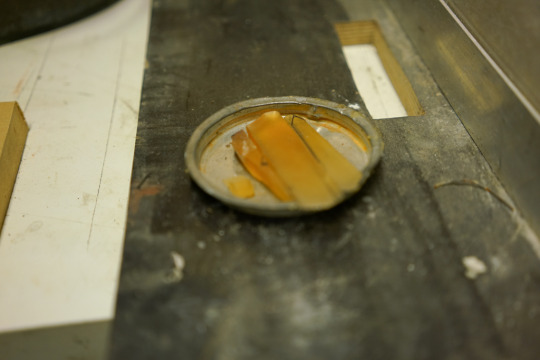
(Red. TSUA was given the opportunity to check out some of his works inspired by this idea in Octave's studio. We’re very curious about what the public will think.)
Interview: Petra Jacobs & Han Spauwen
Translation: Han Spauwen & Steven Kremers
Editing English text: Steven Kremers
Photography: Joan Panhuyzen
0 notes
Photo

Lieke Marsman
How clarity and a life of poetry and prose emerge out of seclusion and crossing out.
Nederlandstalige versie
Date of interview: November 7, 2017
Estimated reading time: 14 minutes
Lieke Marsman (°1990) is a young Dutch writer who makes the adjective ‘young’ already look outdated. Growing up in the quiet provincial town of Zaltbommel, the first seed of a writer was planted. At twenty years old Lieke made her debut as a poet with Wat ik mijzelf graag voorhoud, for which she received recognition and several awards, including the C. Buddingh prize. In just ten years a second collection of her poems was published. And recently she published her first novel Het tegenovergestelde van een mens, that links the unexpected literary theme of climate change with love and skillfully combines prose, poetry and essays.
Lieke Marsman is a writer who travels around the world to give talks in the weekends, and retreats behind her desk during the week. A robust wooden table in the co-working space of a big canal house. A beacon of peace and quiet. Through the windows you can catch a glimpse of the idyllic yet chaotic city Amsterdam. Lieke speaks with a calm certainty about her multiple thoughts. Her words are carefully chosen, keeping all subtleties intact. Perhaps it’s the philosopher in her that also asks us a question every now and then, while pouring us some tea. ‘I’m just forcing this on you, I don’t even like tea myself. But we’ll do it for the picture, for some warmth (laughs)’.

Do you have a strict writing regime?
No, not really. I just get up and go to my workspace every morning and go back home in the evening. I used to work from home, but it made me crazy to be in the same small space the entire day. The walls came at me. I work here for little more than a year now and I am much more productive. There’s more of a pattern to my daily life, but I’m not very strict on myself. If I get an idea when I’m home, or have to finish a small task, I do so. I’d rather not, but in reality, it happens. To be able to write I need plenty of time doing nothing. Just walk around, or sit down a bit. I guess that doesn’t count as a strict regime.
Do you have certain habits before you start writing?
I wish that writing would happen automatically whenever I had a cup of coffee. But no, I have no rituals. One day your mind is clear, the other day it is the total opposite. That’s what influences my writing process. When I only wrote poetry, it was even more difficult to plan. Whenever you have an idea you write a poem. Nowadays I can control it better. In the form of an essay for example. It’s more about work ethic than inspiration.

How did you start writing? Was there always a natural urge?
From the earliest age, I was fascinated by books and always wanted to write. When I was thirteen, I wrote my first poems. If I was pleased with the result I wanted others to read them. Not the people close to me, but rather anonymous people on the internet. I spoke with people around the world. Life was so boring otherwise. So, chatting with someone in New Zealand was really exciting. That is how I got to know other people who were interested in literature and poetry. At that time, I already thought it would be fantastic to publish work. That happened much sooner than I could imagine.

While writing I have the possibility to say things exactly the way I want to. In my most beautiful ‘vulnerable’ way. People don’t get to see that things are much messier in real life.
Why poetry?
When I was very young I kept an online diary. My first collection of poetry is actually a result of that. However it was not a traditional diary with entries like: ‘ Today I did this..’ I couldn’t get that on the paper. I could keep on writing, but I wasn’t able to be totally honest. For instance, to say:’ I have a crush on this person’, or: ‘this is how I feel because of that’. There are people who write down their deepest secrets, but I can’t. So I wrote them down in a very cryptic way. And that quickly turned into poetry.

Do you always need a detour to describe feelings?
Yes, a detour always seems necessary. Which is odd, because people often ask me if I find it difficult to write such personal things. But it goes through a whole process, so that in the end it actually no longer has anything to do with me. I do like to play with that concept. While writing I have the possibility to say things exactly the way I want to. In my most beautiful ‘vulnerable’ way. People don’t get to see that things are much messier in real life. When you write you can choose when you are vulnerable. And that is way it is not really vulnerable at all. I feel totally in control when I can choose: now people are allowed to see this tiny part of me.
Have you ever felt the need to look for that real vulnerability?
No, I cannot do that. That will probably happen once, but not anytime soon.

When you are young, feelings are more like avalanches, a flood. Now I don’t feel like that so often.

Do you feel that you have already experienced an evolution as a writer? Things that you do differently?
I don’t know if it is a conscious development, but my first poetry is very talkative. You can see that already looking at the lay-out, for example. Whenever I write poetry now, I notice it is much more compact. I could no longer write the poems from my first collection. When you are young, feelings are more like avalanches, a flood. Now I don’t feel like that so often. And now I write more prose and essays anyway. It’s fun to try out new things. For the time being there is no way back, but perhaps it will return as a kind of circle.

Where you instantly drawn to Amsterdam as a place to live and work?
It was a very conscious choice to move here. I knew I wanted to move as soon as I finished high school. But I didn’t know where to. Later on, I met people who already lived in Amsterdam. And then I thought: ‘This is where I want to live. There are so many people working on what I am doing here.’ I studied philosophy and found my peers. When I talked about writing poetry, people said: ‘How nice, can we read it?’ While that was always a bit strange in Zaltbommel. Back there I was a bit ashamed of it. But in Amsterdam poetry turned out to be cool. In Amsterdam, suddenly, I could be cool.
Do you need people around you doing the same?
At that moment, I think, it was very important. The first couple of years I totally immersed. Not necessarily exclusively in the literary scene, in the gay scene also. Here I found people with whom I could just go out in a way that I actually liked. Before I thought that hanging in bars was a terrible idea.
Now I notice that the thought that other people are in the same line of work as I is enough. And I do like to be by myself a lot. Sometimes I think ‘everybody, just leave me alone!’ (laughs). I need it to be able to write. Silence. Especially for poetry. I sometimes wonder why I haven’t written any poems for a year now. Probably because I put too much energy into other things. If I took two weeks of vacation, would isolate myself, it would come back. But at this time in my life I find it hard to take a vacation.

In the book your character travels to Italy. You did not go on a study trip yourself?
I have thought about it: maybe it would be helpful if I go there myself? Just to see how it looks, to visit the dams. But it didn’t come to that. I only watched some videos.
In your novel Het tegenovergestelde van een mens, that among other things speaks about climate change, you work with the idea of a dam. What do you find fascinating about a dam?
I noticed, generally, people don’t understand it, they think dams are a bit of a boring subject. But I find it fascinating that such a massive construction is created by humans. It is quite a big intervention in nature. That complements the themes of the book. I also thought the concept of a dam that breaks is beautifully dramatic. So that had to be an important moment in the book. In the Netherlands you don’t have constructions like that. And I always knew the story should be set in the mountains. Maybe because there are no mountains in the Netherlands. So when you see them, it must be because you’re on vacation (laughs). I think people who live in the mountains do not experience it that way.

The climate theme, did you add that later or was it a clear subject in advance?
At first I think I didn’t realize how well it fitted with the rest. I was more concerned with creating a story. At that time I had just graduated and I was finally able to read what interested me. I started reading more about the climate because I knew very little about it. And I found that kind of odd. Then, you might recognize that, when you’re working on something, suddenly everything seems to refer to it. Whatever I read, it was about everything I wanted to say. I knew I wanted to write a book that would mix fiction, non-fiction and poetry. So it really was a blessing when I ‘discovered’ the climate change theme. It was a perfect match with the ideas I already had in mind.

When I started reading about climate change I noticed there was only very little written prose on the subject. I wanted to do something about that, not only as an artist or writer, but as a human.
The book highlights the bad nature of humankind and how they want to turn the natural environment to their hand. In contrast, you also sketch the good in people that want to love. How do you see the ‘human condition' yourself?
It changes a lot. I don’t believe in ‘the nature’ of people. There are good people and bad. And people who are a little bit good or a little bad. At one moment I was reading Leopardi. He has a really extreme cynical view of humankind. I actually found it kind of funny and I understand his ideas. If he would be alive today his ideas would probably be even more extreme. It was an interesting look at humankind to mention in the book.
Simultaneously, there is the character Robin, who is much more positive. At a later stage of writing I let a friend read the work. She did not understand why Ida has a relationship with Robin, ‘cause Robin is a grumpy bitch’. She hasn’t said any positive thing at that point, while, for me, it was very clear the she was the positive, down to earth voice in the book. So giving her more explicit positive ideas was partly a practical choice. The book needed someone with hope and believe in the good. For myself, I think I’m somewhere in the middle.

Humans in relation to nature, how does this translate into art? Is there an activist role that you have to play as an artist, or can it be separate from it?
I think that artists can determine that for themselves. And it’s important there’s non-activist art as well. But when I started reading about climate change I noticed there was only very little written prose on the subject. I wanted to do something about that, not only as an artist or writer, but as a human. It’s an interesting topic to approach in many different ways. Philosophically, as well as with concrete examples and data. I like to take a big subject such as climate change and approach it from different angles, like poetry, essays. I think I’d find it very restrictive if I could have only written poetry or essays on this matter. Although it took me a while to find the right approach. But as soon as I found it, it felt very natural to me. I don’t know why others don’t do this more often. Why limit yourself to only one genre?
How do you determine when the work is finished? When do you know that the book must be released?
When there’s nothing more to edit, to delete from it, I think. Like a sculpture, first you remove big parts of the story. Next you work on the scale of millimetres. I was pretty rigorous with editing my work. At least two third was scraped. I even arrived at the point where I was taking away too much. That’s when you can harm the work. In the end finishing the work is a matter of feeling. The feeling that everything is right in place. And also, the feeling to be done with it.

Sometimes you have to clean up, and it can be such a relieve. It may sound tough, but it also applies to people or relationships.

What you write very much comes from within. What is striking in your work are lifeless objects that are used to give shape to the personal shape. Where does that come from?
On the one hand I am intrigued by object-oriented philosophy. On the other hand, sometimes you see a ‘thing’ and you know, you feel, it is ‘sweet’. It is something you want to care for. I think that’s such a strange and funny concept. It’s about feelings for and of things. Secondly, I find it special that you can connect things that actually don’t have much to do with one another. You do that as a writer and I also think as a reader. At least I hope so.
In the book you describe the character Ida putting all sorts of objects she loves next to each other. Did you also do that as a child?
Certainly, but I think every child does that? Nowadays I no longer collect anything, but I can still be happy as a child with pretty things. But I also love to throw stuff out. Every once in a while, I try to throw out as many things as possible. Only books I can’t let go of.

Like making cuts in your work?
Yes, it doesn’t only apply to my writing, but to everything. Sometimes you have to clean up, and it can be such a relief. It may sound tough, but it also applies to people or relationships. Throughout the years you can carry so much ballast, you must create some clarity in order to create new energy.
What’s it like to talk about the book now? Is that something you enjoy?
It differs. Some performances are fun, others are pretty stupid. It depends on the ambience, or if you’re not in the mood for talking but you have to. Because the book is about climate change I also get asked for non-literary events. That’s what I hoped for, to get invited into different scenes and environments. It gives me a lot of energy. I don’t always get that from the literary scene (laughs).

Is that the reason why you write more essays and opinion articles now?
Yes, I think so. At a certain point, I always feel the need to do something new, or I’ll get bored. I have been writing poetry and performing it for ten years now. It is no longer that exciting. So I’m taking a little more distance from it right now. I do trust that in time it will come back to me.
You translate poems as well. Some are also included in your collection Man met hoed. How does this relate to your own poems?
Sometimes you feel like writing poetry but have no idea of your own. Translating can then be a nice way to do some creative work without having to be full of inspiration. It’s a form of practice. At first I looked for poems that were quite easy to translate. Just so it would be relatively thoughtless work. Like you’re laying out a jigsaw puzzle. But then I thought, maybe I’d like to try something more challenging. Something that requires more concentration.
When I changed publishers, they stopped printing my first collections of poems. So the idea was raised of publishing a new combined edition with some extra additions. That’s where the selection of translations came in. For that I chose poets who either influenced me or inspired me. I thought it was good occasion to introduce poets who are less known.
In the outside world there’s so much you can relate to and write about. It never ends.

There is a lot of room for humour on your website and Facebook page. Do you want to lighten up the dusty literary world?
My website that simply refers to Google, is mainly a matter of laziness (laughs). I had fun making the site but didn’t really feel like keeping it up to date. And I do love humour and find it very important. I take my work seriously, but do not always take myself so seriously. In my work it is also a way of bringing some variety and keeping it light. Some of the themes I write about are pretty heavy. I find it meaningful you can also laugh every once and awhile.

Are you your work? Or do you consciously try not to be?
I don’t think I am my work. But I do feel that if work doesn’t go to well, I am personally not doing great either. Maybe that means I am my work in a way. It is the only thing I am certain is always there. It gives me a lot of self-worth. To me, it is a way to determine what parts of my life, besides work, are good for me. If I’m in a relationship and my work suffers from it, then I know: I need to end it.
Is there a fear that this sense of certainty in writing ever ends?
That has been a true fear. But the fear is under control, now I know I can also write non-fiction. I want to continue with the form I have found. In the future I want to pick out one specific theme again, or continue to write about climate change or the oil industry. In the outside world there’s so much you can relate to and write about. It never ends. That is why I am less afraid, because I really enjoy making non-fiction work as well. It is not a plan b.
Interview + English translation: Lynn Elshof and Han Spauwen
English editor: Nour-Lise Valette
Photography: Eva Beeftink
0 notes
Photo

Evy Jokhova
London based multi disciplinary artist.
Born in Switzerland to Russian parents, Jokhova lived in Soviet and post-Soviet Russia, Austria and Estonia. She is currently based between London and Tallinn. Her multi cultural background and exposure to diverse social and political structures in altering states of flux and stability form the backbone of Jokhova’s research and practice.
In 2013 Jokhova completed MA in Political Communications, Goldsmiths College (London) with an anthropological research project on media influences and the sense of political belonging in Soviet and post-Soviet Russia; and in 2011 she completed an MA in Fine Art, Royal College of Art (London) with a final thesis on the ontological question of being in architectural space.
Her practice is research driven by investigations into relationships between things, the creation of social systems, and how social behaviour can be altered through architectural construction, with reference to the post-Cartesian ontological question of being in space and the relationship between building, body and mind. Jokhova’s projects are often supported by anthropological fieldwork and interviews.

‘Wotruba Score’ (detail), ink and pigment of paper, by Evy Jokhova (2016)
Fondest childhood memory:
Creating a make-belief home between a climbing grapevine and the back wall of our summerhouse in Estonia.
Playing cards in the sauna. Swimming in the sea. Hiding in the attic. Secretly eating out-of-date marzipan with my great grandmother. Being read to.

The smell of home:
Definitely the smell of hearty soup, savoury Russian pie, French casserole, occasionally tarte tatin and, of course, pipe tobacco is the smell of childhood home.
My adult home is more a waft of fresh linen, neutral, airy. Sometimes the smell of a hearty soup also lingers here, or of freshly boiled rice. A subtle fragrance of grass, or leaves or field flowers or something from the garden brought in by a crisp breeze pulling through the open windows.

Something you have heard:
Harold Pinter’s recorded Nobel Peace Prize speech – although it was made in 2005 scarily with everyday it grows more relevant.
The story of Heaven & Hell that I have heard several times, each time re-told a little differently by very different people but always with the same moral. This is the way I remember it.
A call to prayer in a small town in Turkey with only two mosques, which, clearly in competition, each night attempted to shout over each other.
A 30-minute soundtrack comprised of blue whale sound recordings created by Peter Zinovieff (commissioned by Andrew Spyrou through The Association for Depth Sound Recordings) played in the gallery space of TBA 21, Vienna.

Something you have read:
« But would you kindly ponder this question: What would your good do if evil didn't exist, and what would the earth look like if all the shadows disappeared? After all, shadows are cast by things and people. Here is the shadow of my sword. But shadows also come from trees and living beings. Do you want to strip the earth of all trees and living things just because of your fantasy of enjoying naked light? You're stupid. »
- Mikhail Bulgakov, « The Master and Margarita »
Some interesting articles on the future of Narkomfin – a pioneering Soviet Modernist building created by architect Moisei Ginzburg in 1928 with the aim of empowering people – but sadly fell into disrepair.
An article, forwarded to me by a friend that discusses how the recently opened Elbphilharmonie concert hall in Hamburg was partially designed by algorithms.

Something you have seen:
This year as a whole has been nomadic as I travelled from residency to residency since late February – Amsterdam – Vienna – Tuscany – Lithuania with trips to Tallinn and London in between.
I am saturated with new images, so many it will take a while to process them all, for their impressions to settle and commingle with older memories, a few which are strongest in my mind right now:
An incredible pink light emitted at sunset reflecting in the roof of a greenhouse.
The blinding whiteness of the Carrara marble quarry, that was a times too much to bear even with sunglasses on, and the dust, the marble dust, the mountains of dust that poofed up in little clouds of white smoke as I walked on it.

Sol Le Wit’s murals at Gori Foundation, Italy.
The splendor of Italian villas and chapels abandoned and left to decay in the Tuscan countryside.

Beautiful shades of grey turning in deep lead sky as a storm brewed over a Lithuanian beach and a Soviet-built concrete constructivist coastguard building that made me squeal with joy.

A collection vast of green colour palettes – olive trees, Cyprus trees, palm trees, pine, birches, moss, ferns, grass, shrubbery.
The fantastic people: Kristin Hjellegjerde and her gallery assistant curator Trine Stephensen taking ‘Sisypha’ – a giant fake rock sculpture – for a walk down Wandsworth High street.

Something you have felt:
A sense of clam watching the stormy sea relentlessly smash its waves into the shore.
Achy muscles when I run 10km along a sandy beach.
Sheer delight at getting up early enough to have a swim before anyone else got to the pool.
Equal delight at collecting fresh vegetables planted by a French man in an Italian garden in the mornings.
Joy when collecting pebbles by the sea and topping up my stone collection.
A sense of home every time I return to Vienna.

‘The Shape of Ritual’, still from film by Evy Jokhova
Someone you have encountered:
My grandmother; a new friend that has introduced me to new people and experiences of how life can be lived; an old friend who reminded me of bonds forged in early childhood; a person who has lived the entirety of their life in one town and is incredibly proud of its heritage; a lecture by Alexander Garcia Düttmann on French philosopher Jean-Luc Nancy when I was a student at the RCA (I cannot find a record of the lecture I heard but here is a link to another one); a taxi driver who told me to spend less time staring into my iPhone and trust more in people who have been doing their jobs well and for a long time.
Evgeni Morozov giving a fantastic lecture on how the Internet aids dictatorships at the G10 conference on philosophy and economy in the beautifully sparse Westerkerk in Amsterdam earlier this year.
A Weltwunder.
Something you have created:
Sculptures that also function as sound diffusers and can alter the acoustic properties of a space and an analogue system for transcribing buildings into music.

Stemming from the concept that Pythagorean mathematical ratios are the premise for harmony in both music and architecture the translation process systematizes buildings and renders them into linear visual scores through abstracting their architectural features into colour coded shapes. The scores are then given to a musician to create a composition from, with a set duration for the music piece that relates to the time it takes to circle the building outside and inside with a slow pace.
This system was created for my ongoing project ‘The Shape of Ritual’ – that explores the relationship between sound, architecture and the body.
Architecture as frozen music – music as liquid architecture.
The aim of the project is to transcribe three selected ceremonial buildings (representing Classical, Gothic and Modernist architecture) into music and compare them observing how the mathematical principles that inform their architecture manifest (or do not manifest) in their musical renditions.
It relies on collaboration with musicians, composers, dancers and soon hopefully also singers and coders.
Evy Jokhova
Pictures by Evy Jokhova
Interview by Nour-Lise Valette
0 notes
Photo

Bendt Eyckermans
A young painter on transforming his generation and his surroundings into art.
Nederlandstalige versie
Date of interview: September 29, 2017
Estimated reading time: 13 minutes
Bendt Eyckermans (°1994) was born in Antwerp and graduated from its Royal Academy of fine arts as Master of Painting. He was raised in a creative family and from an early age on, with attending art-high school Sint-Lucas, the preparation for his current trajectory began. From a more graphic way of working, he transitioned to the more ‘classical’ art of painting when making the choice for the Academy of Antwerp. Yet Bendt’s surrealistic work is all but classical, since the painter’s ‘muse’ is his immediate environment and peers. With his alterations and intense use of color, he captures the ‘zeitgeist’ of his surroundings, the Generation Now.
In high contrast to the object of his work, the location where Bendt paints is a place where time has been standing still for the past decades: the former studio of his grandfather, where the last rays of summer sun are entering through the skylight. Especially the monumental gravestone that sculptor Lode Eyckermans created for himself, seems to catch most of the light. Lode shows off between two saucy women. “It was found to be a bit bombastic for a churchyard, but it suited his personality. He was a very extravagant, interesting figure.” It’s warm here now, but two weeks earlier the atmosphere in the studio, located in the Jewish neighbourhood of Antwerp, was quite different. After a day of heavy rainfall, the roof couldn’t protect the dozens of sculptures anymore and the studio was flooded with water. Luckily the old and new work of Bendt got away unharmed and on this September day we are guided through the impressive space that feeds his work. It’s no surprise that Bendt receives a lot of inspiration and energy from this spot. By working here, the painter literally surrounds himself with what he loves most: art.
Kusseneers Gallery : Bendt’s solo expo ‘The Clouds Have Gathered’ can be visited until the 25th of November at Kusseneers Gallery.

Has the studio been altered much since your grandfather worked here?
When my grandfather moved in, around the 40s, he shared the studio with five, six other painters. After a while they moved away and from then on he started filling the studio with art of himself as well as work of others that he had collected. That’s why it’s still pretty full. Personally, I don’t feel the need to change it or display my own art here. For me, this is a sort of time capsule that has been preserved and I find that very charming.
A while back you did an interview for the ‘accessible art fair’ and told them that it’s a big honour to work in the studio of your grandfather. Do you find it a burden sometimes as well, to walk in his ‘footsteps’?
No, not at all. Maybe I’d find the search for my own style more difficult if I were a sculptor as well, but up till now I haven’t experienced any kind of problems with it.

My father told me recently: “you’re actually a sculptor, but you just don’t realise it yet.”

And would you ever consider sculpting yourself?
My father told me recently: “you’re actually a sculptor, but you just don’t realise it yet.” So maybe someday (laughs).
Is there a certain routine connected to your day at the studio?
I don’t have any specific ‘rituals.’ What needs to happen is that I arrive here by 8 in the morning and I leave around 8 in the evening for dinner. That sounds like a long day, but it doesn’t feel like that at all since there’s nothing I’d rather do. Usually I look at the time and hours have passed without me even noticing it.

Do you work with music?
Sometimes. Music can give energy and work very motivating but I also really appreciate the peace and quiet and enjoy working on my own. If I do play something, it varies in genre, depending on the time. What I also enjoy listening to, are podcasts, talk shows, something informative to learn from. I listen to BBC’s ‘Witness Archive’ programs, as well as their ‘Arts & Ideas’ and film podcasts. Pretty much everything the BBC broadcasts.
You spend quite a lot of time alone in your studio. Does it get lonely?
It’s much better that I’m here on my own if I really want to work and I also enjoy that. I never have to feel lonely since I have friends stopping by here almost every day. They spend some time on the couch but the result is that I’m too distracted. It’s fun, but then I’m really not doing what I’m supposed to be doing here (laughs).

Do you also have days that the work doesn’t progress?
You have hard days and better days. That’s normal, everyone has those and I’m no exception to it. Usually, I leave the studio to go outside and try to meet with some friends. I have the feeling that if I stay here at a moment like that, I continue doing the same thing over and over again. If I leave the studio for a new environment, see new things, talk to people or simply watch a movie, it offers me new ideas.
Your immediate environment plays an important role in your work. Do they find it comfortable to serve as a sort of ‘inspiration’ or have people complained about it?
No, my friends feel honoured and Gaëlle, my girlfriend, also enjoys that I can paint her.

It would be great if in a couple of decades people could still relate to what I have made.

Your immediate environment is also your generation. Is there anything specific that you’d like to highlight in your work of this generation?
For the exposition that I’m currently working on, I’m mostly focusing on the pessimism of my environment and their dark outlook on the future. That is something I’m working with. It’s definitely not the only thing I want to capture, but I do like to create a sort of atmosphere, a vibe.

Is it important to you that your work stays intact for future generations?
Of course, I’d really like it if in a hundred years time a new audience looks at my work and finds a completely new meaning in it, that they start to think about what the work could mean for them. It would be great if in a couple of decades people could still relate to what I have made.

And what is the feeling that you want to carry forward to the audience?
I just hope that they feel the love that I have for my craft. I don’t aim for a specific emotion that they ‘must’ feel, I just hope that they can dwell on the image and think about it. That they fantasize for themselves and start adding reasons to why this painting was made in this particular way. There are concrete reasons why the paintings look the way they do, but I don’t find that important. I find it important that people can give their own meaning to them.
So it’s not that your work absolutely needs to transfer a message to the audience?
I don’t like to talk about my own paintings that much and don’t feel the need to forward a specific message. If other painters want to do that, it can be amazing, but it’s not my goal. My work shows who I am and I’m not looking for a narrative, I’d rather capture a form of visual poetry.

Are there artists that you admire?
Yes, but not really painters. Mostly, I look up to film directors like Michael Mann and Michael Scorcese. When I was young I always wanted to make films. Now I’m sort of my own DOP, cameraman, screenwriter, set-designer, and director through my paintings. They might be stills instead of moving images, but that’s the only difference. It’s not that I don’t find inspiration in pictorial art, but that’s still different than really looking up to someone. I have to admit that I experience that feeling more often with people such as Mann and Scorsese.

Recently someone also told me that I work like a printer: I don’t work from zone to zone; I work from corner to corner.

How do you start after you’ve decided what you’re going to paint?
I start off with a black and white picture, but the elements in that picture are more anchor points that I can revert to. Sometimes, when I have a composition in my head that looks interesting, I’ll ask my friends, people that I know to pose for me. But it’s not my intention to make the result look like the actual image. I try to give it my own spin, but once and awhile I’ll take a glimpse at the picture to see how something is formed and then I’ll make my own version of it. It wouldn’t satisfy me personally if I simply copied a photo. I want to make it interesting to look at in my own way. Often I find myself looking at a specific element and then I imagine what it would look like if it were enhanced for example. The result contains somewhat surrealistic alterations, which have grown naturally as well as been chosen deliberately.
Technically I start with a sketch of the drawing so that I have a sense of where everything is supposed to be situated. The old masters did it like that too: first a drawing in gray scale and afterwards they painted on top of it with paint. I think that it might be the academic part of me that makes me do it like that. Recently someone also told me that I work like a printer: I don’t work from zone to zone; I work from corner to corner.

Does that academic part, for instance your education at the academy of Antwerp, have a big influence on your work?
Technically? Yes, definitely. Stylistically? Absolutely not. If you take a look at the class that I graduated with and our work throughout the years, I was the only one that painted like this. There was no one that really chose to paint figuratively. All my teachers were very free in their vision of what we ‘must’ do. It’s not because you’re a student at the academy, that you’re pushed in a certain direction opposed to what people often think.
Did they hammer a lot on technique or more on freedom of expression?
They didn’t hammer, but of course you learn it quite elaborately and I find that very important too. As an artist you must know what you’re dealing with. You must know your trade and from there on you can start free styling.

I’m insecure about my work, but that’s normal.

Do you always have a specific idea of what the work is going to look like or does it happen that the work starts to lead a life of its own?
I always have an idea when I start, but it never becomes exactly what I had in mind and that’s ok.
Is there a favorite work of yourself of which you think: if the studio is set on fire right now, then I’ll go running with this one?
(laughs) No, not really. I let go of my work when I’m finished, but maybe in a few years time I’ll look back on it and think: yes, this work I consider my favorite of that period. It’s not that I can’t be satisfied with the result, but it only lasts a couple of seconds and then I already have to put the painting somewhere else. I find myself not being able to look at it anymore because I’m so tired of it already. I’m insecure about my work, but that’s normal.

You’re quite critical of yourself, are you sensitive for other people’s criticism?
I’m only annoyed by critique that I can’t do anything with. If it’s constructive, if I can learn from it, critique can be a wonderful thing. But if it’s just a negative opinion, then I can’t grow from that.

When did you realise you wanted to become a painter?
It was a relatively impulsive decision. After the sixth year Sint-Lucas, I graduated and realised I couldn’t paint at all. I didn’t know how to handle color. I had a pretty graphic education and worked mostly in black and white. Then I entered the admission exam for the academy, got in and two difficult years ensued but I found my way eventually.
How does painting influence your mood?
When it fails, I’m unbelievably bad tempered and you can’t have a decent conversation with me. But when I succeed, I’m happy, optimistic. It satisfies me enormously and I can’t live without it. If I don’t paint for a couple of days, my girlfriend notices it immediately and she’ll say: “Go to your studio, you’re annoying.”

Are you attracted to people who are also part of the creative field?
I have a pretty creative friend group, but that was definitely not a conscious decision. It is pleasant to be able to stimulate each other. I have a friend for example whose studio is close by and sometimes we meet halfway to show each other new work. We can discuss in a constructive way about what we like or dislike about each other’s work and at the same time we can stimulate the other to continue working.
The best compliment that I received recently was from a friend who told me that because of me he started loving Antwerp again.
Your studio is located in Antwerp, you live nearby and Antwerp is a recurrent subject of your work. Is that a conscious decision?
I often find that the people who live here forget how beautiful it is. There’s a hate/love relationship that I sometimes experience myself. But I try to incorporate what I see, the beauty, in my work. The best compliment that I received recently was from a friend who told me that because of me he started loving Antwerp again.
Antwerp is important in my work because this is the city I live in and the beauty of it surrounds me daily. But not just Antwerp, all of Belgium has something very particular that I find very stimulating to work with and that offers me a lot of inspiration. If I were to live somewhere else, I think that a little bit of my heart would remain here forever.

A while back some work of you appeared on fabric. Are there other things, apart from painting on canvas that you would like to use your art for?
Those were forty handmade creations, but I’ve stopped doing that for now. Maybe in the future I’ll pick it up again but for now I don’t want to become a one-man shop. I mainly want to focus on oil paint on linen, making interesting paintings and discovering the possibilities I have with that.

Is there a profession of which you think: if I were to quit as an artist, I’d give this a shot? Something completely different?
Cook maybe? Or, like I said earlier, film director but maybe that would be too close to the arts. I think I’d become very unhappy if I couldn’t be of any more meaning to the art scene. If I have to, financially, of course I’d be willing to do something completely different but on the side I would always infuse my life with something more creative.

At the moment you’re preparing your solo exposition that will open on the 25th of October in the Kusseneers Gallery in Brussels, do you have other plans after that?
After the exposition the future is still undecided but I’m not concerned with that. I want to focus on the now and prepare the best possible exposition. What happens after that, we’ll see.
Interview & English translation: Tyche Beyens
Photography: Maartin Warpy
1 note
·
View note
Photo

Lauren Ellis Matthews
California-based writer, illustrator and designer.
I have been relishing Lauren’s poems for a couple of years now. The world she depicts in her work always projects me in a very comfy bubble, and her Experience Serie is a perfect reflection of the nostalgic warmth her work radiates.
Fondest childhood memory:
It's a place inside of my head mostly but it happened inside of my 3rd bedroom (we moved a lot) when I was probably 4. I was alone, the door was closed, it was evening, maybe twilight, which is the most cunning time of day. I loved being alone in my room. It wasn't a very good punishment for me. It felt so safe and limitless, like I could think or do anything in my own space. I was on my four poster bed and I was also in a space in the clouds I had entitled Kid's Castle. I was probably silent. I was jumping from my bed-cloud to another-cloud and I flew. I remember only being slightly surprised, "I've been told this is impossible". But I know I did it. I can vaguely remember the feeling. It happened very quickly and then it was over.
I've never told anyone this before.
Other childhood memories which largely inform my practice today were being in the library, where I felt very free: I could pick out any book I wanted and as many as I wanted and no one would tell me no. Today I love to get a large pile of books from the library, greedily, even though I couldn't possibly read them all before they're due. Also my mother's office. I used to get to accompany her to work where I would post up at the photocopier all day and make dittos for my dolls. Spelling sheets, etc, for their classroom. I loved photocopying. I still do, and I end up using it a lot in my projects.

The smell of home:
Clean sheets on a good day. Coffee in the morning. Palo Santo, open window at night. Lately I've been burning rose geranium leaves. Often I cook leeks which are horribly smelly. I wish it always smelled like fresh bread; it doesn't.
"Je reviens mon amour. Je reviens et on va prendre ton bain."
Something you have heard:
This podcast between Durga Chew Bose and Tavi Gevinson is full of gold.
Ariana Reines discussing the supernatural on Season 1, Episode 4 of the SFMoMA Raw Material Otherworld podcast is also amazing.
I recently went through a breakup and have found solace in this song The Fog by Overcoats and also the Dirty Projectors' song Cool Your Heart.
I also heard the other day a Frenchwoman say to her son, "Je reviens mon amour. Je reviens et on va prendre ton bain." and I thought it was one of the more gorgeous things I've ever heard.
Something you have read:

For my writing class my teacher recommended "Cousins", a short story by Jo Ann Beard. It's incredible and I was sobbing on the train as I finished it.
Ariana Reines again, I found a copy of her book The Origin of the World and I ate it up. My friend Liz recommended a book to help me deal with myself called Owning Your Own Shadow, by Robert A Johnson. My friend Kate gave me a book of Emily Dickinson's envelope poems and these are brilliant.
Something you have seen:

I saw this the other day in the Los Angeles hills, at the pool of a friends' family home, the perfect kind of early twenties cool and secret small Spanish manor. It's Liz's hand and a party umbrella and a flower.
Lately I have been feeling a strong sense of returning. I keep visiting all these versions of my past self - I will see a group of girls on the train or in the locker room and mentally return to the people I once was, things I once lived. Or I will physically return to a space I had once embodied: drive down a street I've not visited for 15 years, go back to a small town I was in one year ago. But both feel like a revisiting even though the time distance is different. It's like déja vu but different. It feels like I'm checking in on how I used to feel and seeing what parts of me I have retained. It's been going on for about a year. It's a very interesting lens.
Someone you have encountered:
I introduced myself to Sophie Calle when I was drunk at the opening of her recent show. She was uninterested. The next week I listened to her speak at a different opening. She was hilarious and it was delightful.
I encounter my friend Margot semi-regularly and because she is 2 she is always saying interesting things, for example, the other day in the backyard I asked her if she wanted to go on the tire swing, and she replied, "I can't right now. I'm on a boat. See you later."

Something you have created:
I'm working on a yearlong project called Coarse Book. It is seasonal. There are two spring editions (early spring, late spring) and three summer editions (low summer, midsummer, high summer) and it remains to be seen how many autumn and winter editions there will be.
I’m searching for a way to catalogue the connection between the things I read and love. Normally I write down quotations from the books or articles I'm reading, but I wanted a visual documentation of all the things I read in a month. It reminds me of university; how the disparate things I consume (a podcast, an online interview, a physical book, a magazine article, a poem) never fail to somehow relate and form their own dialogue.
I was in school in an interesting in-between period. Certainly we used the internet but we were still given a lot of course materials as printed handouts or as "course books", large photocopied plastic-bound tomes you would pick up at the copymat. I loved these, the way they looked, the textural text that had been copied from a book and was a bit fuzzy, the black blacks and grey and whites, being able to write in the margins and interact with what has already been written - doodling, what you'll eat for dinner tonight, etc. I was feeling lonely for printed material and had just gotten a binding machine for a song (thank you, craigslist angel) so I made these collections.
I'm sure I'm breaking copyright laws but I still like it. I just like the idea that every word you consume - whether you hear it or read it - and no matter where it originates - somewhere elevated, somewhere "inconsequential" - goes into the same space in your brain and you gel it all together and it becomes something else.


Something more visual I've made this year is a deck of tarot cards. The most fun part has been letting myself be guided as I make them and cut them out. It was fascinating to see what the scraps became and how they refer to the original intent of the card. The process of creation has felt like a many-month-long tarot reading. Even when I laminated them they ended up in surprising, telling combinations. There are many forces we cannot see.
Lauren Ellis Matthews
Portrait and tarot images by Ward Long
Interview by Nour-Lise Valette
0 notes
Photo

Naomi Velissariou
Actor, and theatre maker, playing with pride and perspective
Nederlandstalige versie
Date of interview: June 7, 2017
Estimated reading time: 16 minutes
Naomi Velissariou (°1984) grew up near Genk, city of Ford, in a Flemish-Greek family. After graduating from the Maastricht Academy of Performing Arts as an actor in 2012, Velissariou created for Frascati in Amsterdam and appeared in several plays, movies and a television show. For her last play Sontag, she dived in to the works of the American philosopher and author Susan Sontag and wrote down her own thoughts in the essay ‘Mens durf te falen!’ (Dare to fail!) for De Correspondent. Despite, or maybe thanks to, the acceptance of failure as a virtue, Velissariou got quite some attention and recognition for her theatre work, and is considered a voice of a new generation. Velissariou has ‘a personal signature that makes us curious for future development’, as the Charlotte Köller Award Jury put it, who rewarded her with an encouragement award. Drawing inspiration from Müller, Aristotle, Sartre and Sontag, her theatre work is clever, trying to link the philosophical to a rich inner world and challenge her audience.
We visit Velissariou on a rainy day in Amsterdam. After a journey across’t Ij by ferry and a windy walk through Amsterdam Noord we are warmly welcomed. As soon as the door opens, Velissariou is constantly moving around. She pours some tea and puts nuts and chocolates on the table, while her ginger tomcat Kevin cries for attention. Before we can start chatting about her life and work, we get a little tour of the ground floor apartment, complete with backyard and garden shed. On the living room walls some recently bought Athos Burez photographs grab our attention. Burez is also responsible for posters and campaign images of Velissarious plays. "I often find photoshoots very uncomfortable, but not with Athos. With him, you are building a world, often in one day, and live in his fairy tale. You play, as children would. "

Where did the need for theatre begin?
Acting or making?
Which came first?
At first I really wanted to be an actor. Even though I was not the kind of kid that really enjoyed putting on shows. I was just very interested in languages and spoken word. My parents sent me to evening school for diction and performance, a very Flemish thing to do if your child is good with words and languages. After high school I auditioned for Dora van der Groen right away. I became very insecure at that school. I didn’t make the second year in one go and had the chance to do it again, but I was afraid. My classmates were very talented and I really looked up to them. I thought: if I have to retake this year I am going to feel so stupid, and maybe grow too afraid of acting. So I started university, with the idea of taking a sabbatical year. One year turned into five years and eventually I earned my masters degree in theater and film studies. During the last year at university I realised I really wanted to act instead of getting a Ph.D. Otherwise I would never leave my desk and I have too many impulses to do so. So I went to the Academy of Performing Arts in Maastricht.

Those years at university became more then just a means to pass time, right?
Yes, I definitely got interested in the studies, but it took quite some time. In the beginning I was just delighted to be one of two hundred students in an auditorium. It was a very sobering experience after the very personal focus in a class of seven at the academy. I grew up in a very protective and loving environment in Limburg. After a Catholic all girl school with uniforms I went to a pretty rough theatre school in the centre of Antwerp. I was too young for that to be honest. It was too intense for me at the time. At the university your individuality doesn’t matter as much. If you want to get good grades, you just have to work hard. But only at the end of my masters did I aspire to an academic career. Even though it is not the path I chose, those years at uni… I wouldn't have missed it for the world. I learned so much there and gained a lot of life experience. Those were the wildest years of my life (laughs).

You wanted to be an actress, but now you are also a theatre maker.
Yes, I am, but I never really aspired to actually becoming a maker or a director. It turned out to be a natural combination. I switched so many times and in the end I graduated as an actor and as a dramaturge. In between the theory, the content of what you want to tell and the actual embodiment of it, lies the creation of theatre for me.
How do you determine the position you take, as an actor or director?
In the past few years I mostly directed and acted in my own productions. I did shoot for films or television. Next season, for the first time in a while, I am acting in someone else’s play, as Ophelia in Hamlet by Abattoir Fermé. In my own work it is less obvious what position I will take during the creative process. The first question always is: ‘Am I on stage or not?’. It determines the whole further process. The past five years I experimented with different models and there are pro’s and cons for each one.
A solo is the most distinct way of working. I am alone on stage and acting and creation are automatically one. In my last production, Sontag, it was also very clear that I was directing, not acting. By distancing myself as an actress, the whole creative process could take place outside myself. That way I had more control.
I found that directing, creating and acting at the same time is not ideal for me. Occasional collective work, for me, is neither fish nor fowl. On stage, in rehearsal, I am not entirely free, because I always have to keep an eye on the bigger picture. I am not really present with my fellow players, and I am constantly absent from my artistic team because I am on stage rehearsing. Making and acting at the same time is a duel between keeping distance and surrender. The distance you have to keep to control the course of the play and the complete surrender you need to forget in order to act on stage.

I am convinced art is a priori political. Because an artist forces themselves to constantly think out loud.
How does your creative process begin?
It depends on what you mean by ‘begin’. Most of the time it is something that I’ve read or seen that made me excited. What happens next depends for a great deal on how much time and money you have to actually make a production. Right now, for instance, I am doing research for a play for next year. It is going to be a concert play, based on the work of Sarah Kane. Her work has become kind of a cliché, as a psycho-dramatic-erratic-womens theater. For me Kane’s writings are the perfect song lyrics. So I’ve been in the studio for two months already, with different musicians and producers, making ten tracks that will be the core of the play. When those tracks are finished it will become clearer what the course of the play will be. But in the meantime the premiere date is already set and the first promotional text is out the door.
Conceptualising, doing research, rehearsals, it is a gradual experience. It is a constant metamorphosis: from the first idea until the last performance. I never really know when the process begins or ends. But most of the time it starts with words, writing, and only then does it get thematic. I never see something of topical interest that makes me want to make a play about it. Journalistic theatre should not become the norm; I explicitly try to take a stand on that. Art needs to be relevant, but that is not the same as being topical. For instance, I think the self hate and suicide of Sara Kane is very relevant. But I do not feel the need to do sociological research on the current suicide rates of women in Europe.

Doesn’t politics automatically enter the work?
I am convinced art is a priori political. Because artists force themselves to constantly think out loud. The choice of expressing your thoughts is, a priori, a political choice. That’s also what scares me the most the night before a première, that I am going to share my thoughts on something with the world. It feels like one of the most vain things you can do: have people pay to watch you and listen to your thoughts. You have to take yourself quite seriously to assume that whatever you have to say can somehow be of added value for someone else’s life. However, if you don’t think that, you should not be making art. It is even more vain to let people pay to see your work if you don’t believe it is worth its while. No false modesty, but you should be able to put it all in perspective. It is a difficult balance.
That balance reminds me of the struggle the characters go through in Sontag.
Sontag indeed very much explored on that idea. Susan Sontag did not want to die, because she had the feeling she had much more to share with the world. You must have a fairly big ego to think something like that. On the other hand, she was ashamed for all her ideas that were accepted as a truth. Her essays frequently became successes by the time Sontag herself thought of them as out-dated because her philosophy was strongly related to the present and her own life. As an artist you experience that as well. You make about eighty per cent of the artistic choices because you are very tired that day, you just broke up with your boyfriend, or you drank too much coffee that morning. According to Sontag art is not good because all the separate components are well-considered choices, but because the entirety of the work has one drive, one that you cannot ignore.

How do you experience something losing its truth after its creation in theatre, a medium that is fleeting and at the same time can cover a tour of several months?
Sometimes I can experience that feeling… Especially with older work. One of my works A tragedy (simplified), had the opposite: it was endowed with more meaning after it premiered. It was a struggle to make and when it first premiered, not a big hit. Nevertheless it always returned, because the subject matters could be seen in a particular context: a Flemish girl of Greek decent, the immigrant story, Genk as an industrial city. I understand why it was revived. But it is a piece of work that I am a bit ashamed of, because the political message people wanted to see in that still hunts me. At the same time, I am proud of what I created.
Acting in your own play is one of the most embarrassing things to me. If you create it and act in it, you are responsible for everything. Up to and including the lights you stand in. There is nothing you can hide behind. It is my body, my story. If you don’t like it, it does sort of feel like you don’t like me. However, if people do like it, it feels like it’s your birthday everyday.
Theatre is not a talkshow. For me it is the medium of fictional relevance.

Your earlier work, A Tragedy (simplified) and Mr. Jones, seems to be much more direct personal stories. A play like Sontag seems to be more distant.
A tragedy was about my family, yes, but I played Electra. I turned myself into a character to make my story more universal. So it would be more open or recognisable for the audience. Because of the so-called political dimension everyone wanted to see in it, my story got a lot of attention in the media. Unfortunately, that is all that remains now. Mr. Jones dealt with my idea of love and my relationship, and I was on stage with my actual ex. But nobody knew that, so it wasn’t an issue. Those are the works you have to make first, about origin and love. But after A tragedy, I really had to fight hard for my work not to be labelled as personal-documentary-immigrant theatre. That is not my kind of theatre.
A Tragedy was an attempt to apply Aristotle’s poetics onto my own life. Mr. Jones was an adaptation of Cocteau’s Le Bel Indifférent and attempted a dramatic rendition of my own suffering. Every concept contains something that is at once personal and distant. To me, there is no rift between those earlier works and the rest. My work just naturally continues. Sontag was very personal to me. But some people missed ‘me’ because they did not see me on stage. With Sontag I could actually really share what I wanted to say. Thanks to that so-called distance from myself, because of the themes, as well as the fact that I did not act in it.
Your bookcase sure looks a lot like the one on stage in Sontag.
Yes, Sontag also always had her picture taken in front of her bookcase in her own home (laughs). There is even a special Sontag corner in my bookcase. I have read almost all of her work now. She is an inexhaustible source to me.

Sontag, Sartre, those are all quite intellectual sources for your theatre.
Yes, I guess so, but then again, who cares (laughs). But I do not want to make it elitist. I think a work of art is best when it works on many different levels. I always try to make sure one can enjoy my work without any knowledge of all the underlying philosophies. With Sontag I sometimes got the feeling people came to get a summary of Susan Sontag, a speed course in her philosophy. It was nice, but I did not expect it. Sometimes it felt like they came to see my show as an extra to the additional programme the theatres organised. People like to have a useful evening and like to think they learned something. This behaviour is also somewhat the side effect of the explicit politically engaged theatre popularity. The audience wants to see what they saw on the news, or what they read in the paper, translated into a personal, fun, manageable story That is not the essence of theatre. Theatre is not a talkshow. For me it is the medium of fictional relevance.
To me theatre is a place where pain is allowed to exist; you are allowed to feel pain and to look at it. I think that is something really valuable.
What is the purpose of theater then? Solely art?
Theater can be whatever, but it has no direct purpose. Theatre can tell us something about the human condition. I realise that sounds very cliché. For me, theatre is a way of life, of survival, but that probably sounds romantic or heavy too. To me theatre is a place where pain is allowed to exist; you are allowed to feel pain and to look at it. I think that is something really valuable. It is different from a theatre of solace. Put bluntly, I can relate myself to the world in two ways: either a sober, scientific way, or in a melodramatic, personal way (laughs). Theatre lies somewhere in the middle.

I do not want to make frumpy, bourgeois plays, but uncompromising work next to having a loving life with friends and family. That’s a huge prerogative if you ask me.

Do you need an environment that is direct and straightforward?
I do need an environment in which I can switch off my cynicism and hyper-awareness. Although it can sometimes be a virtue, most of the time it’s actually works numbing. Right now, for instance, I see myself talking about that hyper-awareness. I should’t go “meta” all the time, let alone talking meta about meta like I’m doing now, or there’s no end to it. (laughs). Then I will literally have no idea what I am doing. I find it one of the most striking things of this time: all those narrative constructs we grow up with, that makes us so aware of everything. I could just cry thinking about it because it doesn’t solve any of all that self-awareness. If you are sad, you are sad.
Do you feel the need to retreat?
My job entails being around people, all of the time. Every three months you start a project with new people and every time you establish these intense connections. Therefore I more and more do feel a need for peace and quiet. If you’re rehearsing or when you’re on tour, you end up at the bar almost every night. So, on my nights off, I like to be at home with my boyfriend. Sometimes it can feel a bit isolated, because after a while it is hard to separate your friends from your colleagues. Now I have to learn to surround myself with people on those days off as well. Really invest in my social life, host spontaneous barbecues and attend birthday parties.

I do not strive for something specific. I just have to create theatre. That is my ambition.
What are your hopes for the future?
I would like to find a balance in work and private life. After graduating you fear you won’t get any work, or if you do find a job, you fear it is not enough to provide for yourself. If you find out that you actually can, then you can afford to only take on interesting work. Now I just hope to continue what I have done for the past years, to create pieces I really want to create. That is truly fantastic. But the past five years it has been at the expense of everything else. I hope to have a real home and family life aside from work. Without having to make great artistic sacrifices. I do not want to make frumpy, bourgeois plays, but uncompromising work next to having a loving life with friends and family. That’s a huge prerogative if you ask me.

What are you artistic ambitions?
To be strict with myself, not making any compromises. As an actress, I do not want to take on a role just because it is glamorous. I only want to do parts in which I can stay true to my own poetics. Sometimes I wonder if I don’t have enough ambition as a theatre maker. I do not strive for something specific. I just have to create theatre. That is my ambition. I hope that when I am sixty-five, I’ll still be lying in my bed trembling and vomiting when I have a premiere the next day, because I don’t know if my ideas are worth an entry ticket. Hopefully people will be convinced it is indeed worth it. Maybe that is my artistic ambition: to make myself go through all of that, over and over. That’s enough challenge for a lifetime.
Interview & translation: Lynn Elshof
English editor: Hendrik Wittock
Photographer: Tom Peeters
0 notes
Photo

Geran Knol
Balancing between his autonomous work, illustration, Park Pardon and Oval Angle.
Nederlandstalige versie?
Date of interview: May 25, 2017
Estimated reading time: 8 minutes
Geran Knol (°1991, Makkinga) is a visual artist and musician. Until the age of 17, he lived with his family in a little village in Friesland, a northern region of the Netherlands. After he graduated high school, he decided to go in a different direction and took his first steps into the world of art. He received his bachelor’s degree at ArtEZ academy in Zwolle in the Netherlands and then moved to Belgium with his loyal partner in art, Bloeme van Bon, to get a master’s degree at Sint Lucas Antwerp.
Geran and Bloeme’s graduation project later on blossomed into Park Pardon. The artistic couple are inseparable and over time, they have developed a consistent style. Currently, they both live in a cosy suburb of Antwerp, Sint-Laurentius. We met Geran in his idyllic fourth-floor apartment to talk about Park Pardon, Oval Angle and his individual work.
Geran Knol Park Pardon Oval Angle

How would you describe your personal work?
I always start from the techniques, the tactile and tangible stuff. A pencil on a paper. The structure of the paper is always very visible in my collages. For me, it feels like a research of shapes. Every work is a result of the previous.
Which three words would you use to describe your work?
Form, abstraction and loneliness.

In a room full of people, I sometimes feel like an outsider. It’s that feeling that I try to assimilate in my drawings.
Why loneliness?
Loneliness is a recurring theme in my work. I’m an introvert. In a room full of people, I sometimes feel like an outsider. It’s that feeling that I try to assimilate in my drawings. However it’s not my intention to make my work sentimental. By creating ridiculous situations and playing with colours, I try to emphasise that loneliness.

Which object or person inspires you while you are working?
When I’m working, I’m always surrounded by little sculptures and other objects. It’s a collection of objects (sculptures, jars, vases) that I bought on flea markets or received as a gift from my friends. Their visual language inspires me. They are often handmade, imperfect objects that are also a little bit ugly, but are charming because of that.

Who would you say has influenced your work?
David Hockney has been my role model for years. I believe our styles match. I especially love his work from the 60s and 70s. My favourite Dutch artist is Klaas Gubbels. There is a similarity in visual language between his and Hockney’s work.
Which of your creations do you like best yourself?
That must be one of my most recent pieces. I usually only like my own work for a short amount of time before I grow tired of it. I’ve just started a new piece. I’m currently working on bigger panels and I’m very happy with it. If it works out, I’ll make a series out of it.

As a child, I didn’t really know what it meant to be an illustrator, but I knew I wanted to draw and go to art school. “That is where you become an artist,” I thought.

Have you always wanted to study illustration?
As a child, I didn’t really know what it meant to be an illustrator, but I knew I wanted to draw and go to art school. “That is where you become an artist,” I thought. I used to sit at my kitchen table for hours, drawing with my felt pens on paper. As a teenager I always wanted to go to college in Maastricht in the Netherlands. The rebellious idea behind that choice was to know that it was situated on the other side of the Nederlands. When I was 17, I moved to Zwolle to go and study arts at the ArtEZ academy.
In 2012, I graduated as an illustrator in the Netherlands, but these last few years, I’ve become somewhat more autonomous. I’m consciously balancing on a thin line between working for myself or others. Honestly, for me, there doesn’t even have to be a distinctive line. I often work on commission. I like the variation of it.

It’s exhausting at times to always work visually, but at the same time it’s a personal must.

Your education forces you to stay in the art world for the rest of your life. Have you ever regretted that?
Yes, I have. I sometimes think about how my life would be had I chosen a practical job, but then again I would never have felt happy. It’s exhausting at times to always work visually, but at the same time it’s a personal must.

You were born in the Netherlands; can you see that in your work?
Personally, I don’t really see it. At the moment my inspiration comes from everywhere around the world. I’m inspired by the figurative work of the Dutch Bart van der Leck. African sculptures attract me too. You can find an African influence in the work of Park Pardon.

PARK PARDON
How did Park Pardon come to be?
I met Bloeme on the academy in Zwolle. It didn’t take a long time for Bloeme and I came to realise we had the same taste. Originally our plan was to found our own little publishing company to publish our own work and the work of others. However we deviated from that rather quickly. Eventually, we collaborated to make art and became the duo “Park Pardon”.
Park Pardon was our graduation project in both Zwolle and Antwerp. In the period between our bachelor’s and master’s degree we had neglected it a little. ‘An Entrance to Mention; the Park Pardon Principles’, the work (book) that we made during our internship at the Antwerp design company Afreux , was a new inspiration for Park Pardon.


I think that, as a team, we dare to take steps we would make less quickly on our own. For example, as Park Pardon we made installations and various sculptures.

Why do you two work together? What are the benefits of the collaboration?
Through the years we did become closer and it seems like we fused together in a way. People often don’t see that the pieces are made by two people. We know each other through and through and that has its pros and cons of course. We know exactly what the other has envisioned. Lately, though, we have been growing apart in our individual work and it does make our collaboration somewhat more difficult. On the other hand it provides a new impulse for our collaboration. I think that, as a team, we dare to take steps we would make less quickly on our own. For example, as Park Pardon we made installations and various sculptures.

The word Pardon is an apology for the naivety that our work displays.

Why the name Park Pardon?
One night we made a list of words that came to mind. We were looking for a name that was easy to pronounce in both Dutch and English. The first word had to refer to a place, so Park. The word Pardon is an apology for the naivety that our work displays.

How would you like the project to evolve in the future?
At the moment we are collaborating with Uitgeverij Bries, a Belgian publisher, for our first book. For that, we are trying to get a fund in the Netherlands. We both want to make an effort and breathe new life in Park Pardon. Although it remains an addition to our individual work. I do hope that there will be a good balance between Park Pardon and my own work in the future.

OVAL ANGLE
In the music world, you are known as Oval Angle. Why did you choose that pseudonym?
When I was given the opportunity by Louis Reith (artist and owner of the publishing company Jordskred) to make my first tape, I didn’t have a name yet and had to come up with one fast. I wanted a name that expressed something impossible: an oval angle.
Publishing under my own name was out of the question. In the beginning I wasn’t confident enough about my music. Using a pseudonym allowed me to hide behind a name.

Actually, I’ve been making music for much longer than I’ve been drawing. I started making music when I was 15, as a hobby, and I’m still doing so. At the time it probably was more noise than it was music (laughs).

Why did you want to make music? What drove you to that?
Actually, I’ve been making music for much longer than I’ve been drawing. I started making music when I was 15, as a hobby, and I’m still doing so. At the time it probably was more noise than it was music (laughs). Through the years, my interest in music broadened and I started listening more often to folk, ambient and experimental music. Also, my style in music has gotten a lot closer to the style of my visual work.
How would you describe the style of music you create?
Well, more or less like my drawings: abstract. I use a lot of self recorded samples and distort them. Or I take bits and pieces from existing songs and modify them. I love to mess around with it. It’s like you can take an eraser through your song, so to speak. Just like you can with a drawing.

If you would have to choose between music or drawing, what would you choose?
Drawing. Although I find the interchange of the two disciplines perfect, music remains to be primarily a personal project. Only occasionally I feel the need to go public with my music. That's different in my visual work.
Interview & translation: Eline Schaerlaecken
English editor: Gary Leddington
Photographer: Maartin Warpy
1 note
·
View note
Photo

Ode de Kort
A young artist, her sculptural experiment and the recurring ‘circle’.
Nederlandstalige versie
Date of interview: May 7, 2017
Estimated reading time: 15 minutes
Ode de Kort (° 1992, Malle, BE) grew up in the silent ‘Voorkempen’ in Flanders, Belgium. As the granddaughter of sculptor Jan Dries, she grew up considering form and thinking about art. Before finishing her master photography at KASK in Ghent (Belgium), her still blossoming oeuvre was picked up by Giuseppe Alleruzzo from SpazioA in Pistoia, Italy. It was here that she launched her first solo exhibition at the beginning of this year. In this exhibition, 'O froooom O toooo O’, the circle shape - for years an old friend in her work - formally received its central place: in the title. Exercise, play and repetition are central to the production process of de Kort. In her sculptural experiment, the artist tries to stretch the boundaries of the photographic image by pollinating them with a mix from other disciplines.
De Kort also showed work in CAB (Brussels), Extra City Kunsthal (Antwerp), Hopstreet Gallery (Brussels), Tique Art Space (Antwerp) and De Directeurswoning (Roeselare). About early-age success, the artist says, "I try to look at it in a practical way: either you make work or you don’t. The rest will come.“ According to de Kort, she inherited that do-mentality from her grandfather.
On the day of the interview, Joan Panhuyzen (the TSUA photographer) and I meet each other for a coffee with breakfast in the outskirts of Antwerp, where we have a brief talk about de Kort’s work. Choreography, the subtle control in her meticulous arrangements, the encounter between sculpture and photography, circles of course, and whether - and where - humor shows in her practice. When the young artist finally leads us in, she immediately starts talking about her studio and new book (a co-publication with Silvio Ebner and SpazioA Pistoia). As she introduces the book to us, it almost seems like her hands dance with the pages. A pleasant experience that we detect a few minutes later again when de Kort demonstrates her relationship with a certain rubber circle.
Ode De Kort
SpazioA

The work from my grandfather is my most treasured possession.
You grew up in a small family as an only child. One of the main characters in your life was your grandfather, sculptor Jan Dries. How did you see him?
My grandfather made an imposing impression on me as a growing child. I was sensitive and did not always like the things on my plate. He was strict but fair. Later, I mostly had philosophical conversations with him. My higher education started at the same time as the beginning of his health problems. In 2014 he died. We actually have never been able to talk about my work in a mature way, and that still pains me.
What is the most important thing you learned from him?
His 'do' mentality! Also that you always have to listen to yourself and that stubbornness is therefore fully permissible in that regard (laughs). When I turned 23, my parents gave me a work of his for my birthday. It's called "Toetssteen". If you push it, it always finds its axis back. I can manipulate, move and tilt it, but it always comes back to its natural balance. That's powerful, right? That work is my most treasured possession.
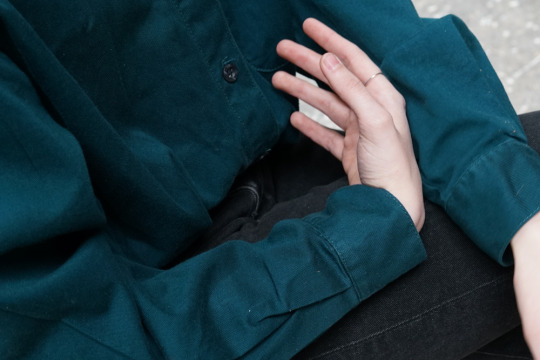
Your grandfather worked in his later artistic life mainly with white Carrara marble, a material that he remained faithful to until his death. Also in the last year, you have explicitly chosen a lot more for one form: the circle and its derivatives. In the sense of self-discipline and faithfulness to one recurring motive, I see a clear resemblance between you and your grandfather.
First I want to clarify that my grandfather has done a lot of different things in his life. He started with ceramics, in his earlier work you find a lot of color and he could draw amazingly well! Only after a long time he decided on white marble. Light began to take a more essential place in his work. How light functions and moves for example. Then Carrara marble was a logical switch for him.
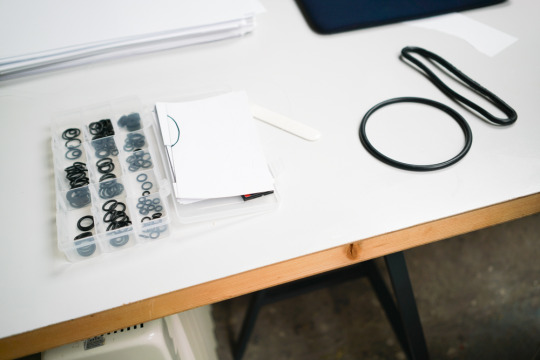
It’s no devised plan for the next twenty years (laughs).
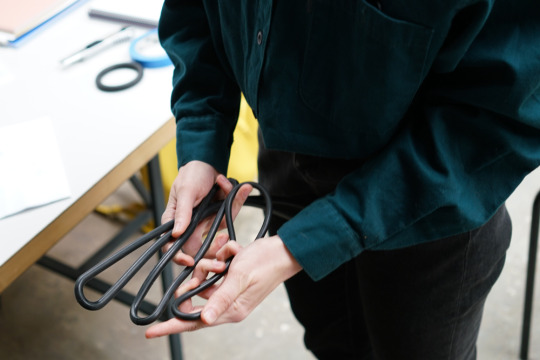
With a few objects I've been working for a couple of years now.
But to return to your statement: I think it's because of a certain attentive-ness with which I grew up. My parents and aunt are also very attentive and notable people. Once Pieternel Vermoortel said that I could easily work for five years with one stick or one circle, and she was right. With a few objects I've been working for a couple of years now. Exercise, play and repetition are important motives for me. Some may find it too monotonous to always re-use things again, but on the other hand I find it admirable to make a choice and stay behind that. Just look at an artist like Daniel Buren, whose work is characterised by the persistent use of vertical stripes. You can say, “They're only dashes", but of course then you totally miss the point. However, I do not know what camp I'm in yet. It's just happening like this now. It’s no devised plan for the next twenty years (laughs).
More recently I began to see that the circle often returns. At one point I made a radical choice.
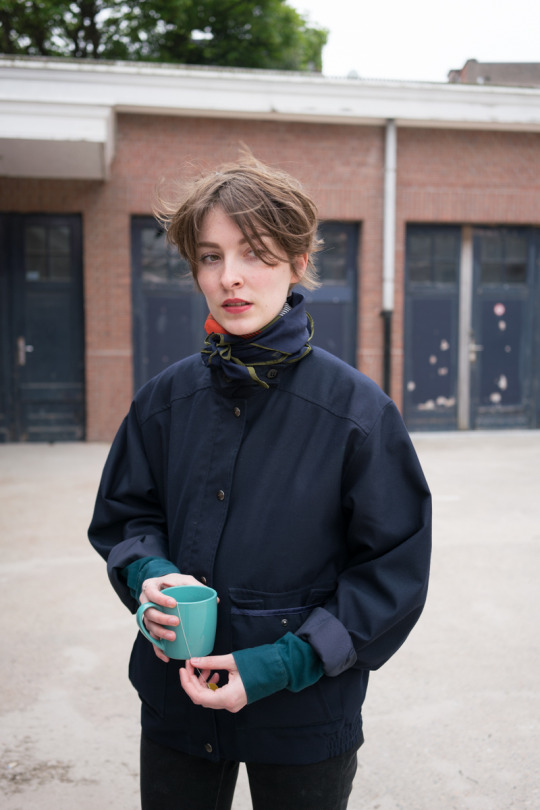
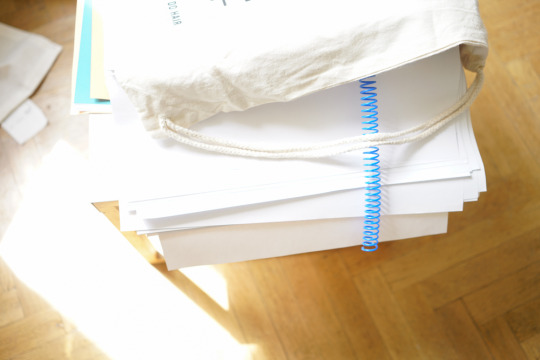
Pure photography does not affect me too much.
Your first circle is already visible in the work 'Frozen Movement' from 2013. After that, in the Fold / Unfold work from 2014 and 2015. Was it always there to begin with?
Until last year, the recurrence wasn’t a conscious motif. More recently I began to see that the circle often returns. At one point I made a radical choice. Curator and founder of KIOSK in Ghent, Wim Waelput, invited me to the Hopstreet Gallery (Window) in Brussels and the video I made for this show, Suspension of a Circle (2016), was an important moment. For 9 minutes you see a rubber circle manipulated and played by with a stick. The fun and the movement, both crucial in my work, get their place in that video. Then I made an installation for Extra City Kunsthal in Antwerp with circles in the floor, which was part of my work '0O (2016)'. Also that was another step forward for me. I graduated as a photographer and during my studies, I was constantly searching for how I could stretch and activate the photographic medium because I do not necessarily want to show the transparency of the world or copy reality. Pure photography does not affect me too much.
I graduated as a photographer and during my studies, I was constantly searching for how I could stretch and activate the photographic medium because I do not necessarily want to show the transparency of the world or copy reality.
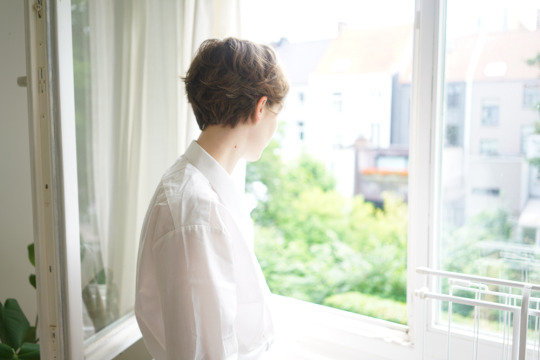
Interesting. Are there photographers you do feel affected by?
Photography that is placed in a larger whole by a combination of another medium. I'm a photographer myself, so I am not completely indifferent, but I find that it doesn’t stick with me when it works purely photographically. Naturally, I have a love for the sculptural experiment of the photographer, as I'm searching into that field myself. Artists that attract me greatly are Joëlle Tuerlinckx, Helen Marten and Michael Dean. I think for now, it’s rather difficult to call artists ‘just’ photographers (laughs).
Naturally, I have a love for the sculptural experiment of the photographer, as I'm searching into that field myself.

What is the last exhibition you've been to that stuck?
I’m afraid that was also not a show from a photographer (laughs). The big room in the exhibition 'Listening the pressure that surrounds you (2016)' by Thea Djordjadze in Sprueth Magers Gallery had a big impact on me. Very subtle but beautiful!
How does your work stands in relation to the camera?
The camera is just one of the ‘bodies’ I'm dealing with. A concept is also a body in a sense. The material, which is autonomous, is another. The space, movement, the limitations, all bodies. I, as the maker of work, am the manipulatory body. The image is only created through the encounter between all those bodies. The camera is as important as the stick or the rubber circle. Not more, not less.
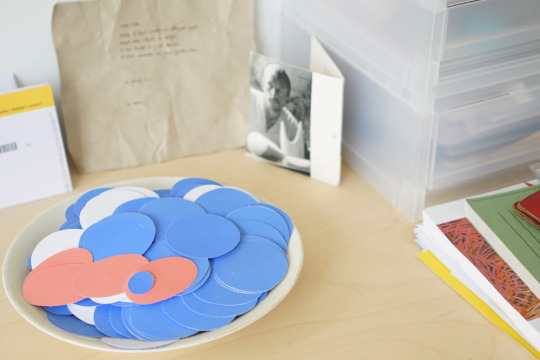
how people think about existing forms keeps me busy.

Where does the autonomy of your circles actually comes from?
Mainly from movement. I am interested in topology, a certain branch of mathematics which deals with deformations of an object in a space. But also how people think about existing forms keeps me busy. A cone shape for example. If you show his flat side, you'll see a circle. You can not see the depth behind it. My work 'Weight of a Line' from 2015 plays with a derivative of that thought. A line is a concept, not something concrete. You can not grasp or measure its weight. Just like a border. It only exists in our minds as a concept because we create a difference between one and the other.
Artists and intellectuals are ultimately the marginals of this world and that’s too easily forgotten.
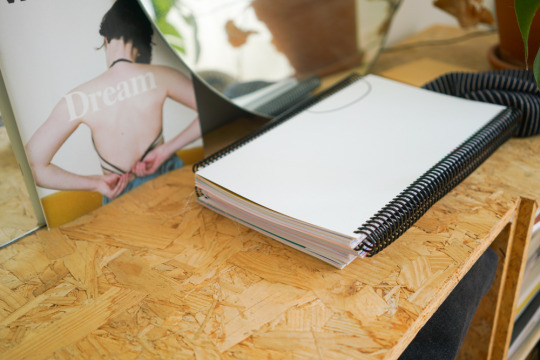
People often forget that you, as an artist, are confronted with your work at all times of the day. It's like a flat hand in front of my eyes.
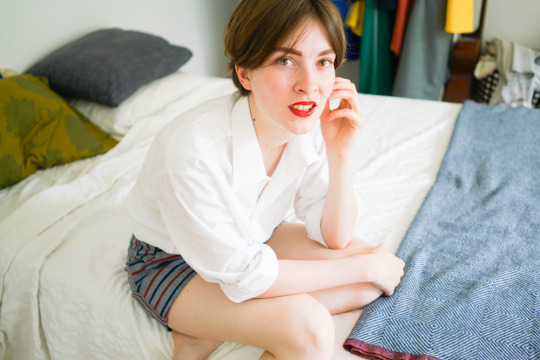
I am not always in the mood for people, bursting into your space like a hurricane, suddenly ‘getting’ your work all at once.
How important is it for you to talk about such ideas in your work?
I do not like lofty ways. Artists and intellectuals are ultimately the marginals of this world and that’s easily forgotten. On the market you also want to buy your vegetables with people who are friendly, honest and open (laughs). Do not get me wrong. I like talking about art, whether it's my work or work by another artist. A good conversation about something, however, needs the right context. Only from a sense of mutual respect, can real information be shared. When someone has decided what his or her opinion will be, talking sometimes makes little sense.
People often forget that you, as an artist, are confronted with your work at all times of the day. It's like a flat hand in front of my eyes. I am not always in the mood for people, bursting into your space like a hurricane, suddenly ‘getting’ your work all at once.
I was invited to a debate on social engagement in the arts. Being the youngest and only woman with four experienced men – three of them double my age - I was planning to wear a mustache. But I was too tired that morning for jokes like that (laughs).
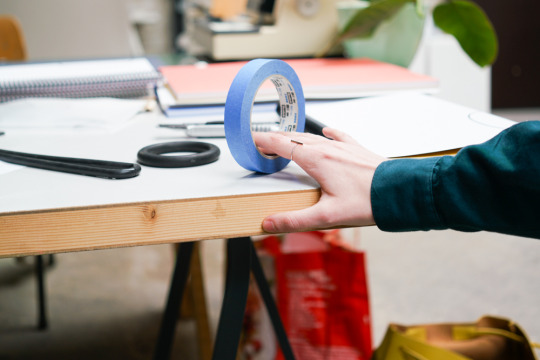
You don’t want to defend yourself if people have a wrong idea of what you do?
Mostly not. It really depends on the person's openness. I've already heard crazy things about my work, but usually I do not mind that much. It’s also not always evident. A couple of weeks ago, I was invited to a debate on social engagement in the arts. It was an event that took place in Tour & Taxis in Brussels and the guest speakers were Wouter Hillaert, Jeroen Olyslaegers, Ben Van den Berghe, moderator Oscar Van den Boogaard and me. Being the youngest and only woman with four experienced men – three of them double my age - I was planning to wear a mustache. But I was too tired that morning for jokes like that (laughs).
Supporting attention to something, for 5 hours non-stop, is super political!
From my – maybe flawed - point of view, I was the suspected artist with "little socially engaged" work. But I find that aesthetics are not merely form but are certainly also political. Supporting attention to something, for 5 hours non-stop, is super political! That form of attention is still very rare in our society, I am afraid.
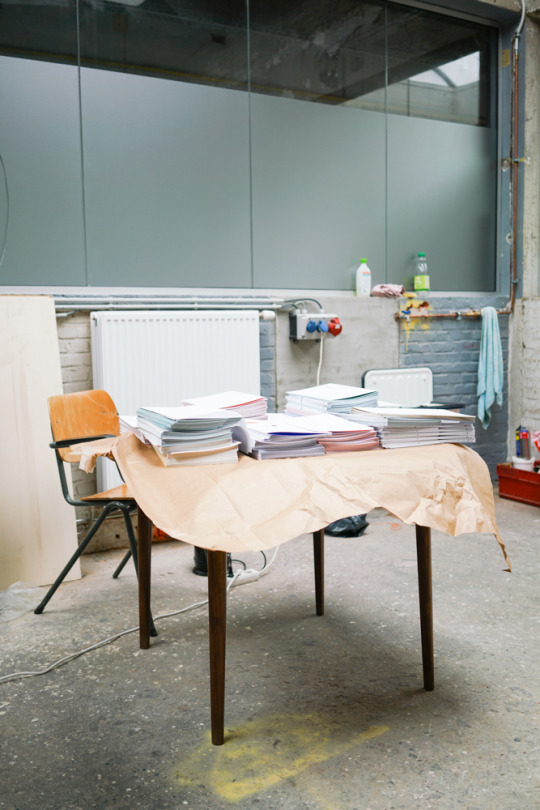
I don’t work with circles because I like the way it looks.
What are aesthetics for you?
I do not think aesthetics are mere form. Aesthetics have a whole agency. I also do not work with circles because I like the way it looks. I don’t know if shape actually exists independently.

I don’t know if shape actually exists independently.
You always really consider the exhibition space. Have you always done that?
Due to practical considerations in a space, you must move differently both with yourself and your work. I always start from the space now but that has been an evolution. As I mentioned before, I wanted to abandon the idea of framed photography that only hangs on the wall. I wanted to make the paper move in-space. The space, however, recommends it how to move, it dictates what can and what can not. I don’t want my work to be just an aesthetic object, therefor it has to work in the space.
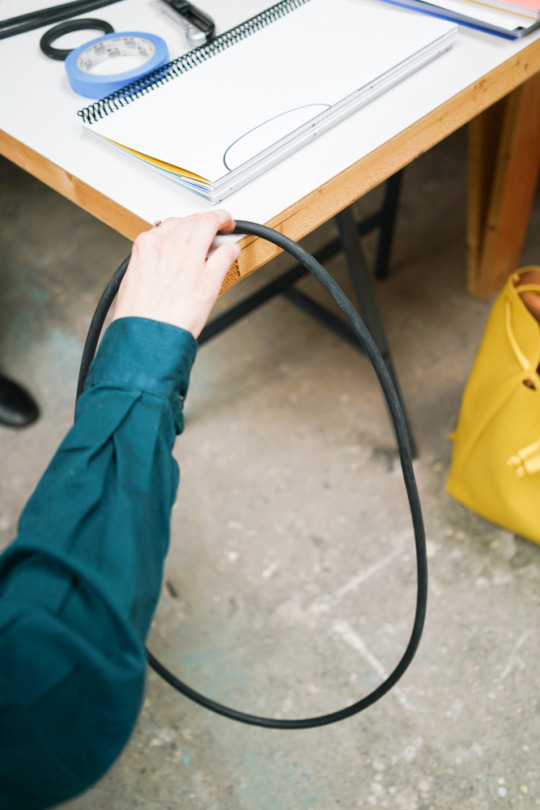
I enjoy being busy with my clothes, my house and plants.

How important is shape for you in your life and work environment?
Very important. I enjoy being busy with my clothes, my house and plants.
Do you have a fixed rhythm?
No not really.
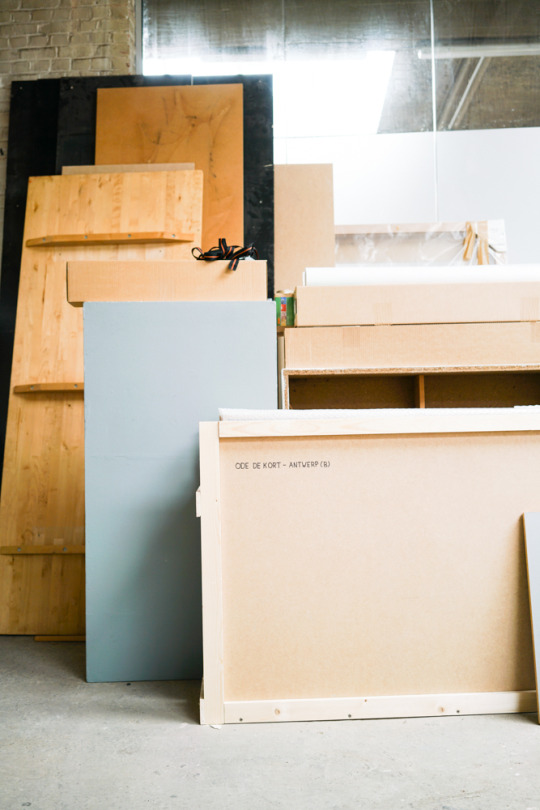
I need a lot of emptiness.

Do you miss that?
Sometimes I worry about that, but at the same time, I have to take my time for things. I always have to bear a difficult production process. My boyfriend, Boris Van den Eynden, works very different from me as an artist. He works from 8 o'clock in the morning until late in the evening, and in a sense he has concrete things to work with. I can’t implement it for myself though. Although I work very hard and certainly show the necessary professionalism and self-discipline. I need a lot of emptiness. It's just a very different fight.

I danced a lot as a child. I should actually do that again to relax. I often sit in my head for too long.
A fight?
There are some difficulties. For example, when do you decide that a work is finished? Deadlines work well for me. Restrictions in space and time often bring solutions.
By now, luckily, I know what process I need to go through if I want to create new work, but it still sometimes crawls into my body. In the beginning of a new production, I really have to go deep into myself and that is not always easy. To get rid of over thinking things, I sometimes draw: arrangements or spaces. Playing as such and having fun with materials is also important to me in the initial process. Look up the boundaries of my material, move, dance. From these things something can arise. I danced a lot as a child. I should actually do that again to relax. It would be beneficial for my work actually. I often sit in my head for too long.

During your studies you stopped dancing. You miss that?
In a certain way it is still present in my life. If I am, for example, making a video or a photographic image, I’m dancing with those objects. But pure dance, yes, I miss that very much! I need to move, I need an exhaust valve. I need things to let the tension out of my body. I'm actually looking for the right environment, where interesting choreography can be combined with my current physical disabilities (laughs).

You are talking about your need for relaxation. Do you use humor in your work to solve something?
No, it just happens sometimes. In the video 'Suspension of a circle' I had a lot of fun with the comic movement of that relaxed rubber circle slab. I always start from something that follows its own form and sometimes something unimaginably funny happens. This give some airiness to the work I guess. I always keep room for coincidence. Humor relieves. Sometimes it's also a discovery. Sometimes it doesn’t make sense. The comical aspect in my work is a very specific form of humor. Not everyone may appreciate it, but I notice that most people who see the comedy often follow my work better.
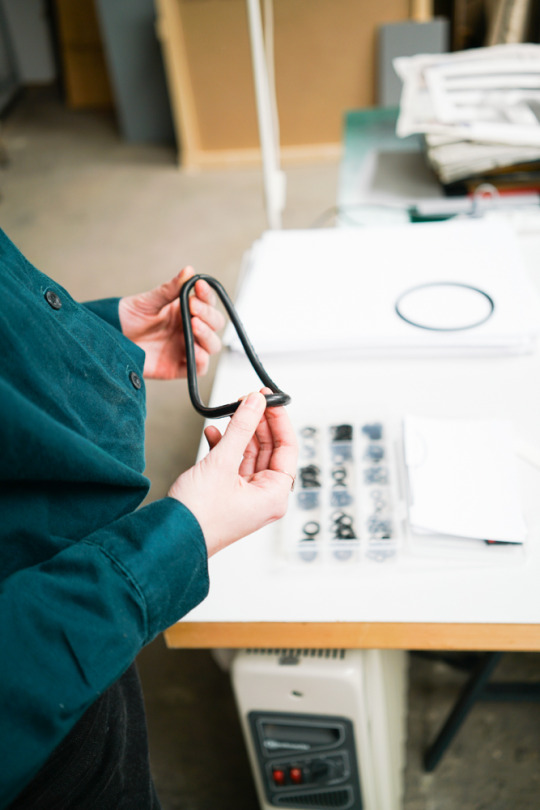
When did you meet your SpazioA gallerist, Giuseppe Alleruzzo?
I did a residence at Fondazione Antonio Ratti in Italy, where Giuseppe encountered my work and portfolio. We first "spoke" through email when he invited me to work in his project space. I met him in Pistoia when I built my exhibition. The experience was one of instant understanding and so we started working together after that.

Being an artist and dealing with an audience is confrontational, yes. You show yourself.

Did you sometimes feel you were too young to step into the gallery world?
When I met Giuseppe, I was still working on my master at KASK in Ghent, so it was important that I could still take my time for studies and residencies. Giuseppe has greatly supported me on that front too. For him, the relationship with the artist is the most important. I always had the feeling I was given the freedom to determine my own production rate. Also with his assistant Ariana, there is a huge ‘click’. I was really lucky with them.
I never felt I was too young to show work. Being an artist and dealing with an audience is confrontational, yes. You show yourself. Your work is critically reviewed by people. Exposing yourself is essentially frightening. But there are always uncomfortable issues. As I said, I try to look at it in a practical way: either you make work, or you don’t work. The rest will come.
I would love to make a playground once.
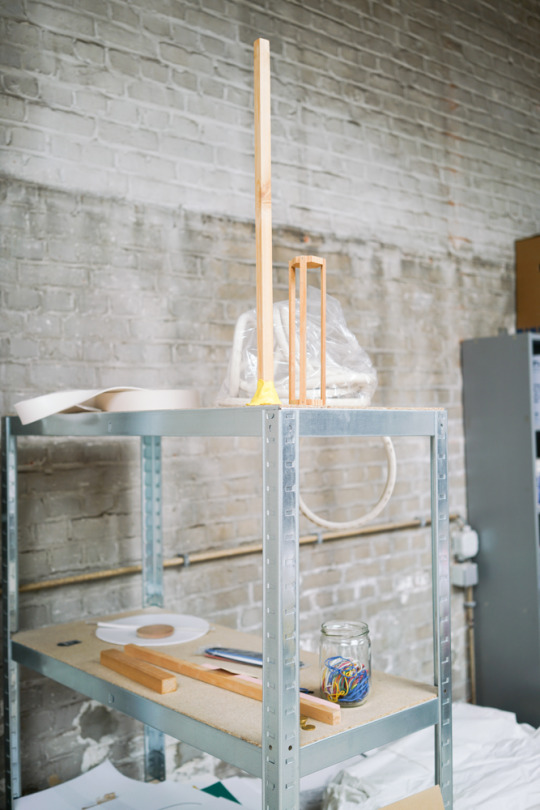
I am happy for you that you told us at the beginning of the interview, you don’t have a twenty-year plan. It wouldn’t feel healthy if you would have one at this age. However, I am curious about your plans in the near future. You just got your first solo exhibition 'O froooom O toooo O' in SpazioA in Pistoia, Italy. What's on your agenda now?
I will continue to work with my new book (a co-publication with Silvio Ebner and SpazioA Pistoia). In addition, I think that ‘performance’ still has an enormous capacity. Video, photography, sculpture, performance. There are so many interactions possible that new things will soon come. I'm back in the beginning of a new production process: an exciting moment always. Perhaps I urgently have to look for a suitable dance class for me. Against the tension in my body (laughs). I would also love to make a playground once. My idea is to just keep working and deal with everything as it comes.
Interview: Merel Daemen
Photography: Joan Panhuyzen
Editor English translation: Gary Leddington
0 notes